Clematis Vine Care: Planting, Growing and Pruning Tips
Whether you're a beginner or an expert gardener, Clematis vines are a perennial that belongs in everyone's garden. It's easy to grow, and if you plant a few different varieties you can have big, beautiful blooms all season long. Learn how with this Clematis care guide.
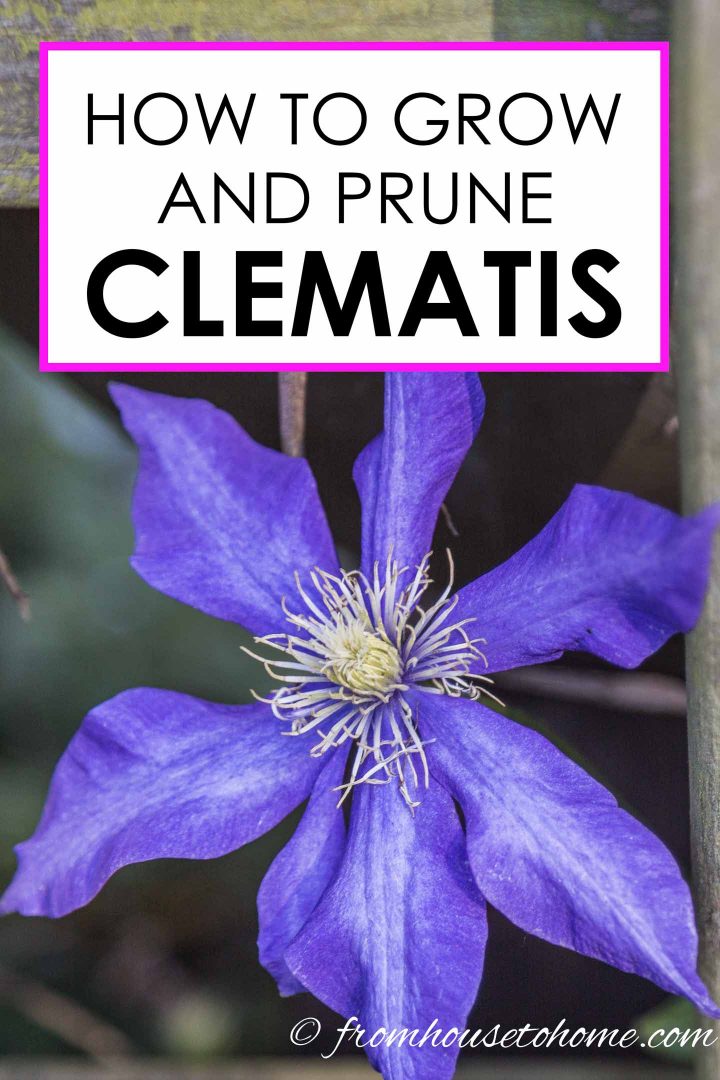
I have come to the realization that I am a little obsessed with Clematis.
I didn't actually know how obsessed until I started taking pictures for this article.
There are 25 different varieties of these perennial vines growing in my garden at the moment! And I'm not ruling out getting some more 🙂
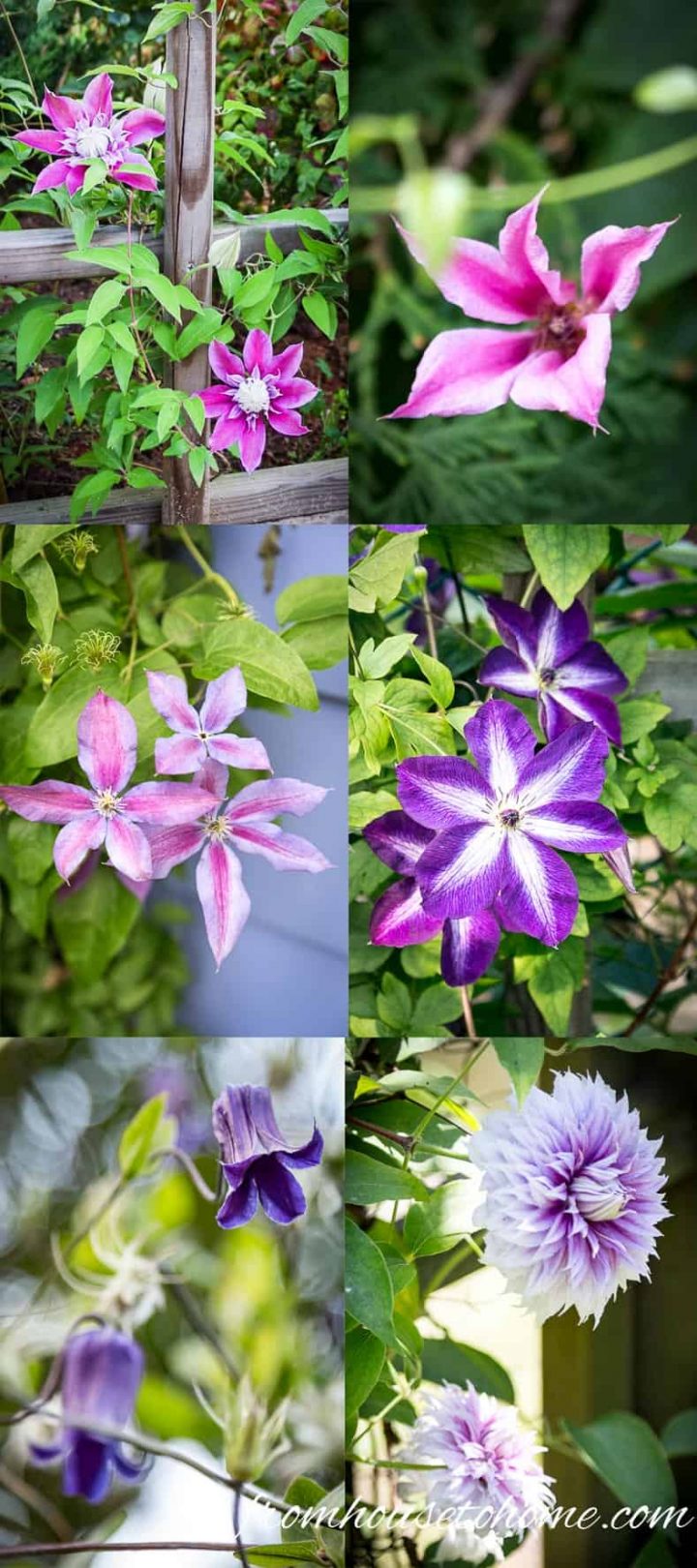
However, I think I'm justified. All you have to do is look at those beautiful blooms to know why I have so many of them.
But that's not the only reason.
Clematis is a very versatile and easy to grow perennial vine.
It comes in many colors, sizes and bloom times.
There are varieties with large flowers, small flowers, single or double petals, bell-shaped or tubular blooms.
Some varieties will only grow to be 2 – 3 feet tall, while others can cover the side of a garage.
And in almost all cases, Clematis vines are not invasive.
So you can grow them through other bushes without worrying about killing the plants (I do have experience with a couple of exceptions which I will tell you about later).
It has so many redeeming qualities that I think Clematis should be a part of everyone's garden.
So that's the “why” to grow these beautiful plants…keep reading to find out where and how to plant and grow Clematis.
What You'll Learn
If you know what you're looking for, you can skip straight to the section by clicking the link below.
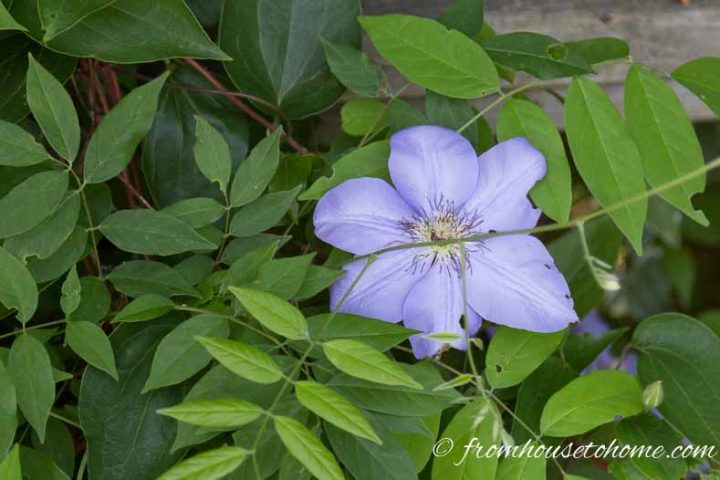
Where To Plant Clematis
Zones: 4 – 9
Light: Part shade to sun
Although most guides say that Clematis is a full-sun perennial requiring at least 6 hours a day of sunshine, where I live in South Carolina, I find that it grows best in part shade.
It really doesn't like the heat of our summer afternoons.
In fact, some of my plants bloom in the spring, die back completely in the summer and then grow and bloom again in the fall when the temperatures cool down. (I can't really complain about that since I get 2 bloom times every year!)
But (as with a lot of plants), the further North you are, the more sun it will need to produce the most blooms.
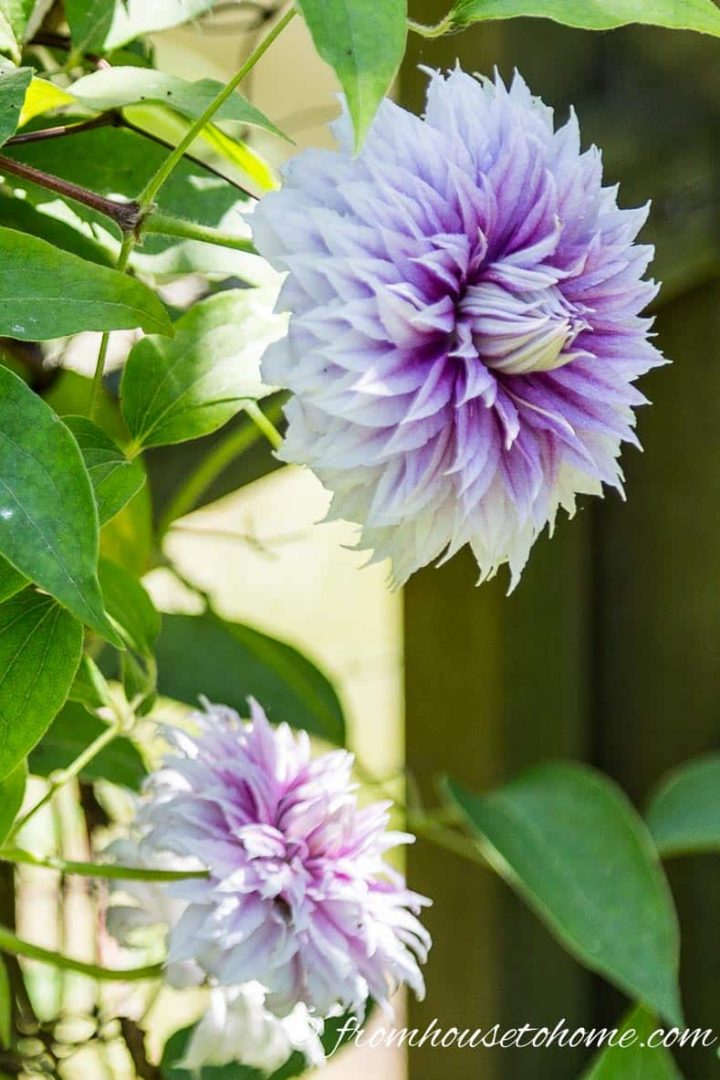
There's one other thing to keep in mind when choosing where to plant your Clematis.
Clematis like cool roots.
So you may want to pick a spot where the roots are shaded by other plants or structures, but the flowers are in the sun.
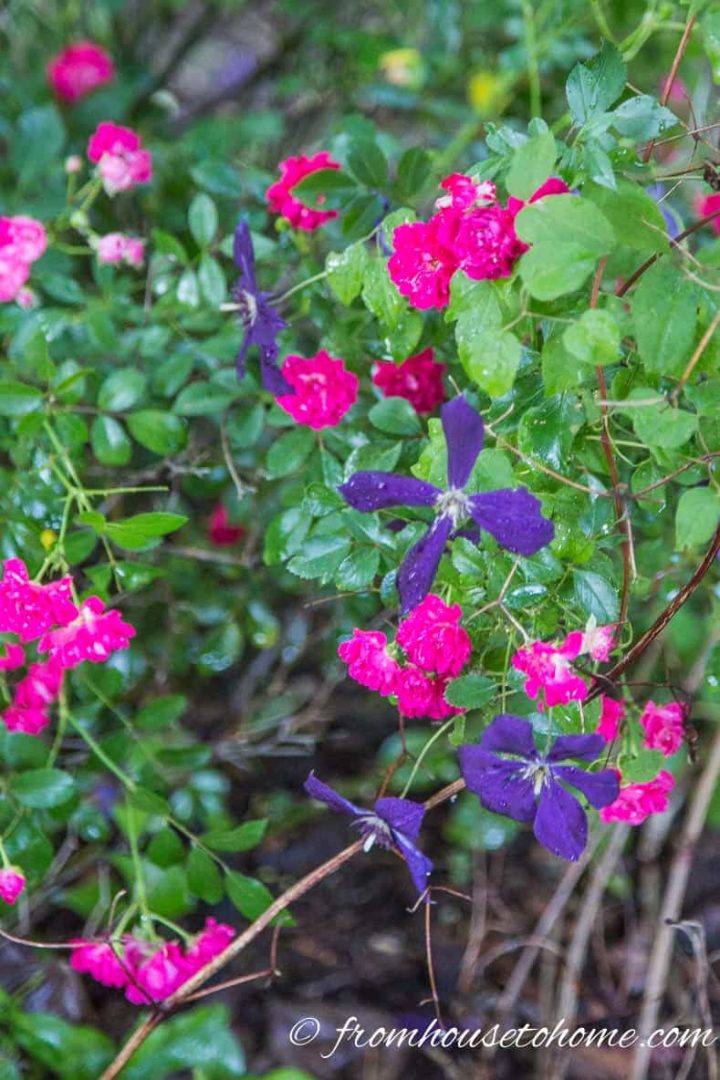
Supports
Since Clematis is a vine, it is usually grown on some kind of support.
Unlike some other vines, it is generally not an aggressive plant.
Which means it can be grown up through bushes or on top of other plants without causing them harm.
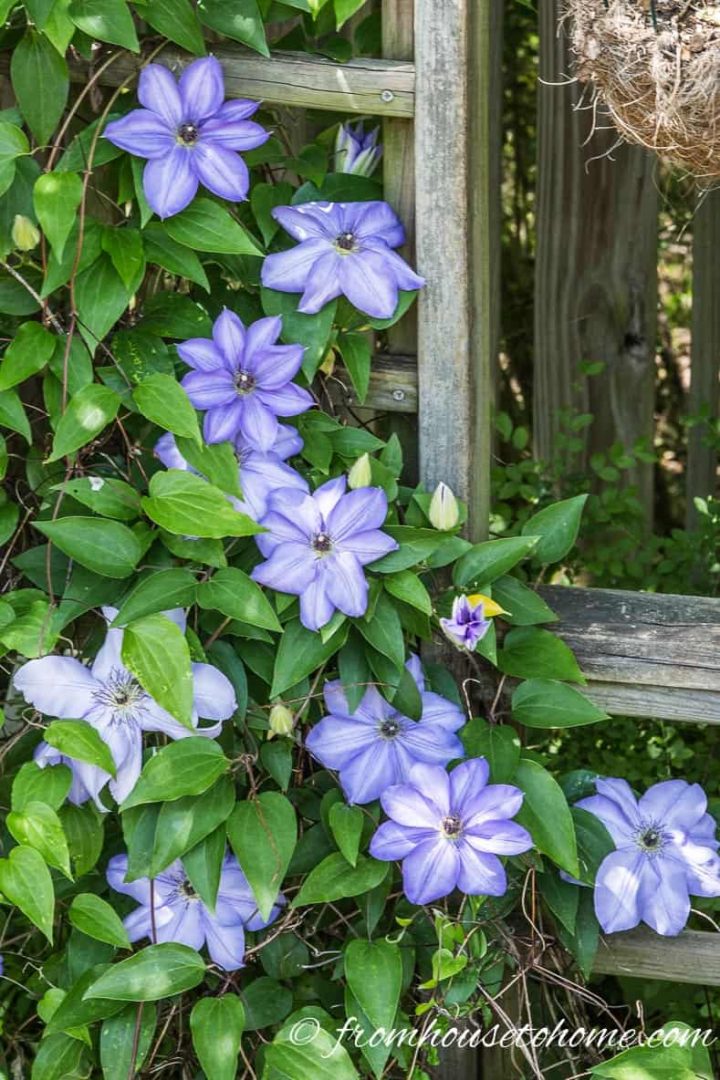
Of course, they look beautiful growing on trellises, arbors, and fences, too.
Since Clematis climb by twining their leaves around supports, and the stems aren't very long, they have difficulty sticking to wood structures.
To make it easy for them to climb, stretch some fishing wire or string across the growing surface which gives their leaf tendrils something thin to grab on to.
Although most gardeners don't grow it this way, Clematis can also work well as a ground cover (in which case you don't need any supports at all).
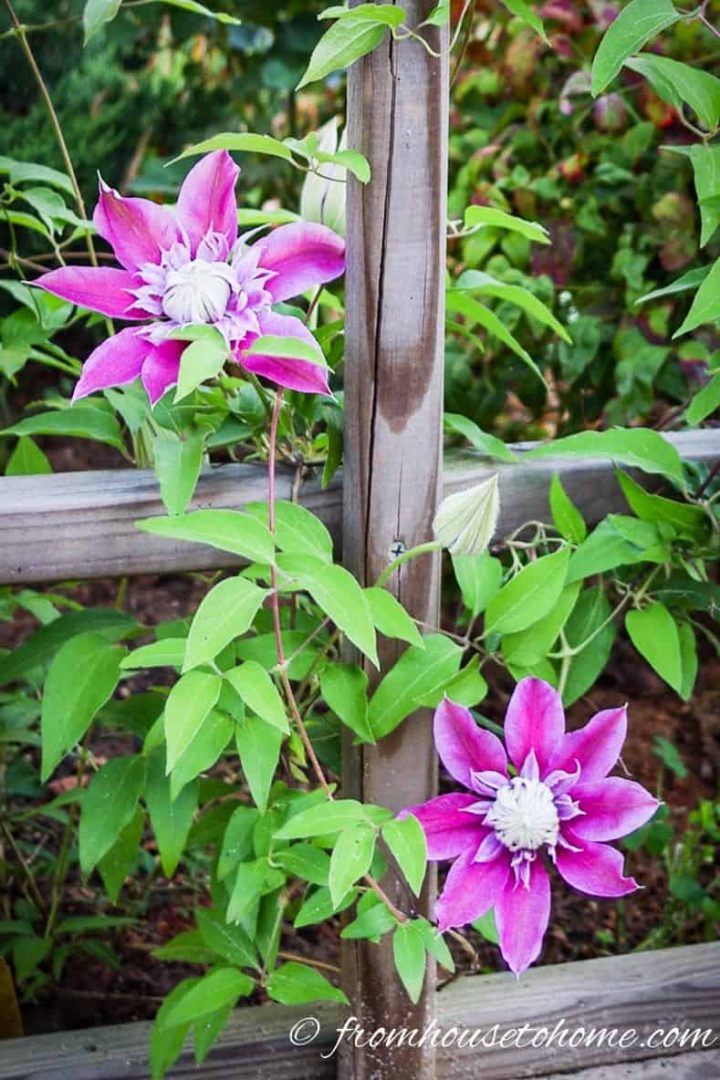
How To Plant Clematis
Once you have figured out where you are going to put your Clematis and what type of support you're going to use, the next step is planting it.
Dig a hole that is about twice as wide and deep as the size of the pot.
Mix some compost and good top soil in with the soil that you dug out of the hole.
While not absolutely necessary, adding a scoop of bone meal to the mix will help the roots to get established.
Fill the hole a little less than half way up with your soil mixture.
Plant your new Clematis so that a couple of inches of the stem is buried in the ground.
This will also help the plant establish strong roots.
Tilt the stem at about a 45 degree angle toward whatever support you are using. This will make it easier to get it to grow where you want it.
Then fill the rest of the hole up with your soil mixture and water well.
Cover the soil around the base of the plant with a thick layer of mulch (making sure that it isn't touching the stem).
If your new plant has a lot of growth on the top, prune it down to about 18″ tall. This will allow the roots to get established without having to support so many leaves and flowers which promotes a healthier plant.
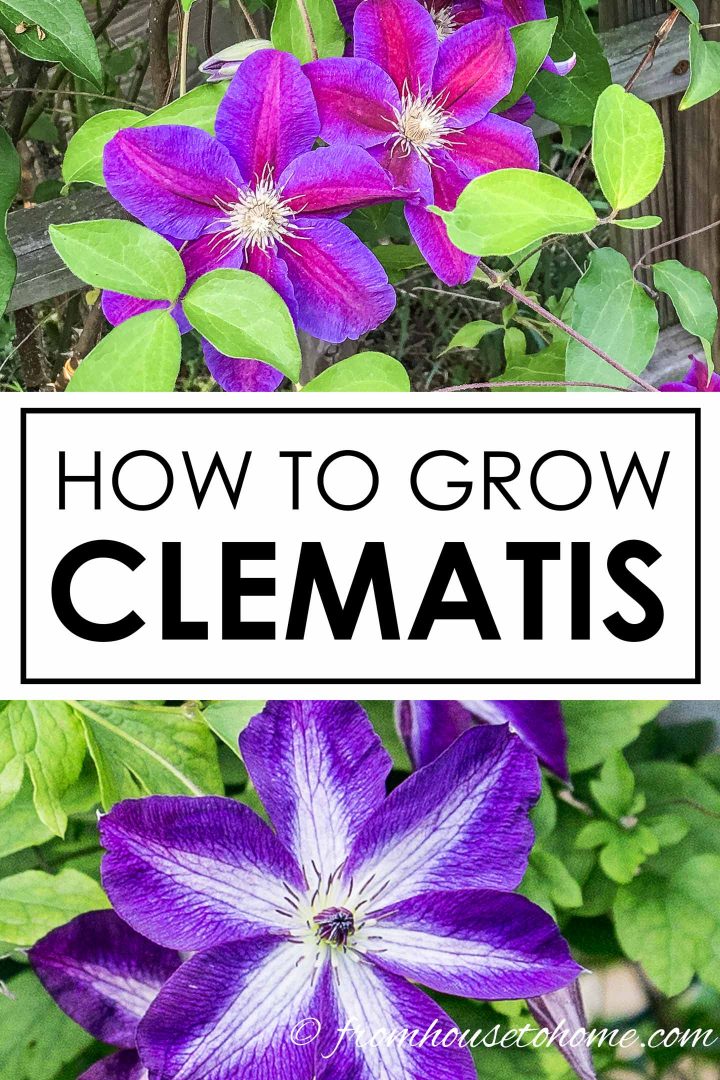
Growing Requirements
Clematis can take a couple of years to really become established, but once they do, they pretty much take care of themselves if you follow these guidelines.
Soil Conditions
One of the most important parts of Clematis care is to make sure you have well-drained but moist soil to grow the plants in.
Their roots can rot if they are too wet, and the leaves will fall off if it is too dry.
Clematis also prefer neutral to alkaline soil.
If you live in an area that has acidic soil (like I do in South Carolina), sprinkle some lime around the plants in the spring to help neutralize it.
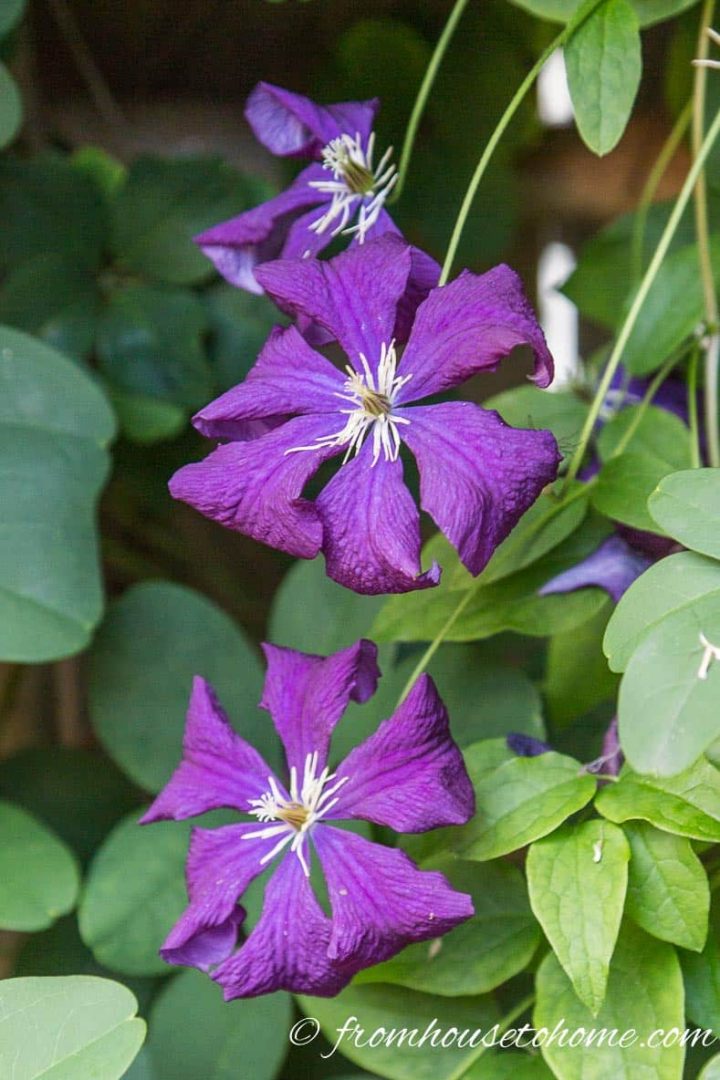
Watering
Watering regularly is a necessity for good-looking Clematis plants and flowers, especially during the heat of the summer.
As I mentioned above, not having enough water will cause the leaves to dry up and fall off leaving a very unhappy looking plant.
Installing your own drip watering system will make sure that they get the consistent watering they require.
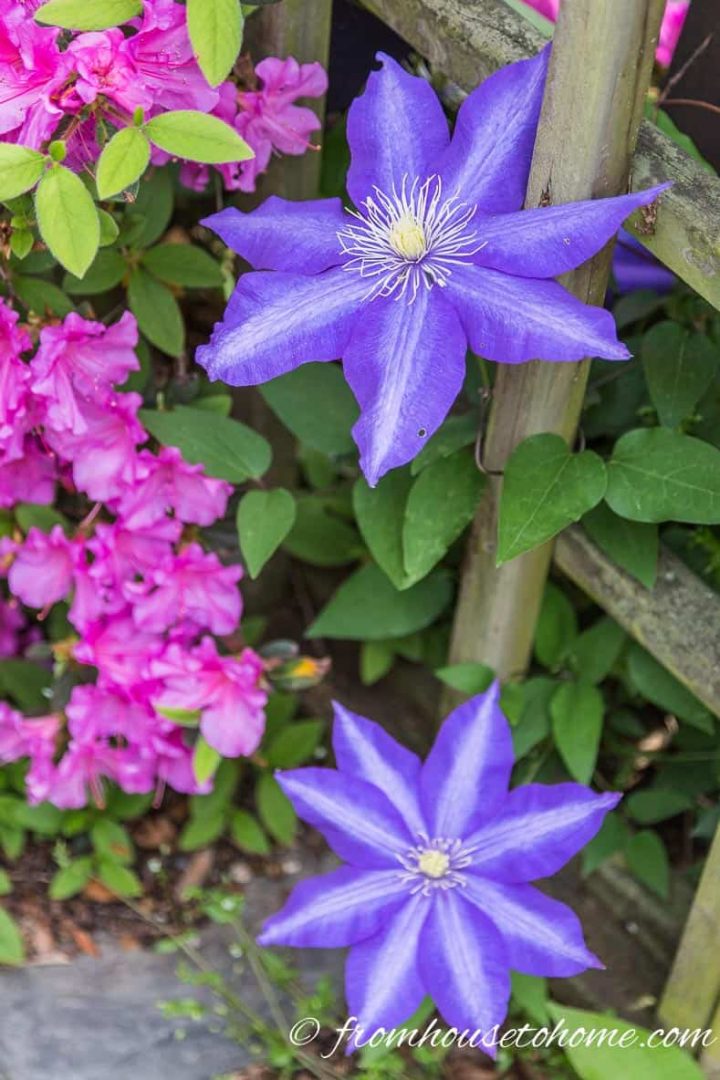
Mulch
Mulch is the easiest way to prevent the roots of your Clematis from overheating.
And it also helps to keep the soil moisture from evaporating (which helps with that water requirement).
Every spring, I cover the base of all of my plants with a 3″ to 4″ thick layer of mulch making sure that it doesn't touch the stems (which can cause them to rot).
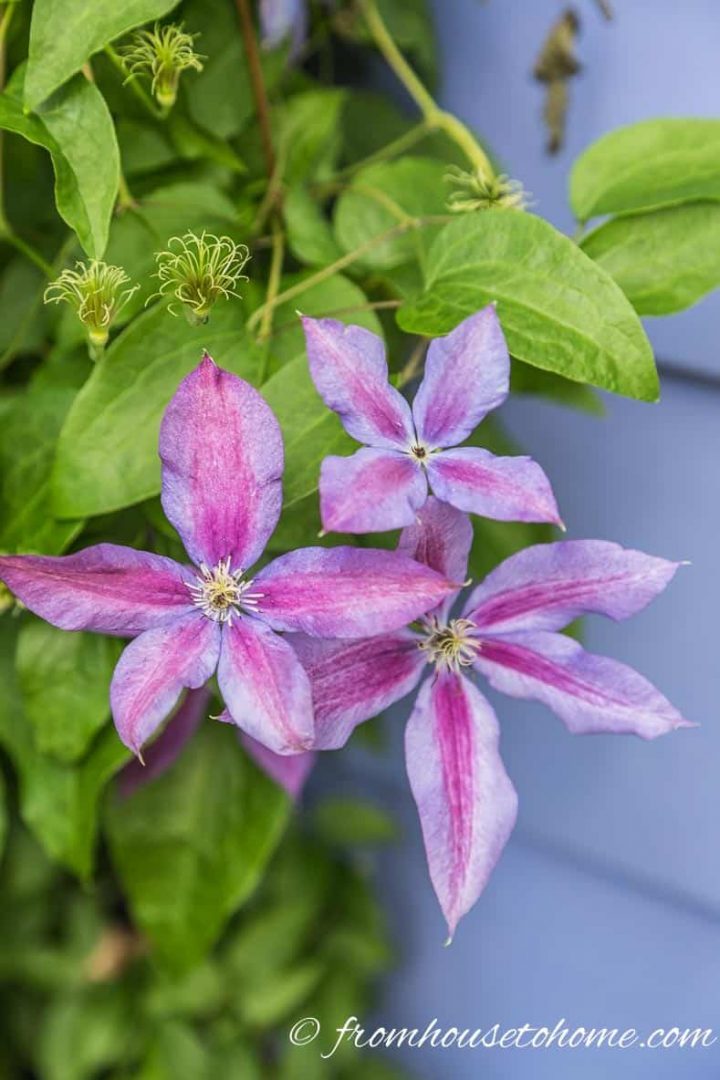
Fertilizing
With all of those big blooms, Clematis needs a lot of nutrients from the soil.
Fertilizing in the spring and the fall will help to keep them healthy and blooming.
I like to use organic fertilizer.
In the spring, I sprinkle alfalfa pellets (which you can find HERE*) around the base of the plant and water them until they get mushy.
Then in the fall, I put down a layer of compost around the plant which also adds to the organic matter in the soil.
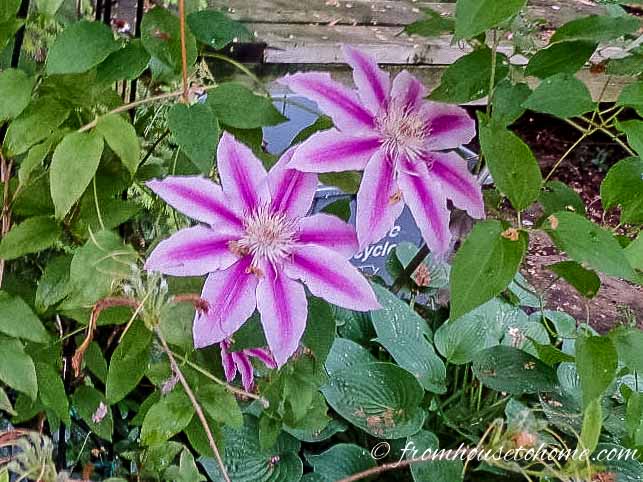
If you prefer to use chemical fertilizer, use one with less Nitrogen and more Phosphorus (eg. a 10-30-20 mixture) in the spring to promote blooms. In the fall, add an evenly balanced fertilizer (eg. 10-10-10 or 20-20-20).
Next up is learning how to prune your Clematis. It's really not as complicated as it seems!
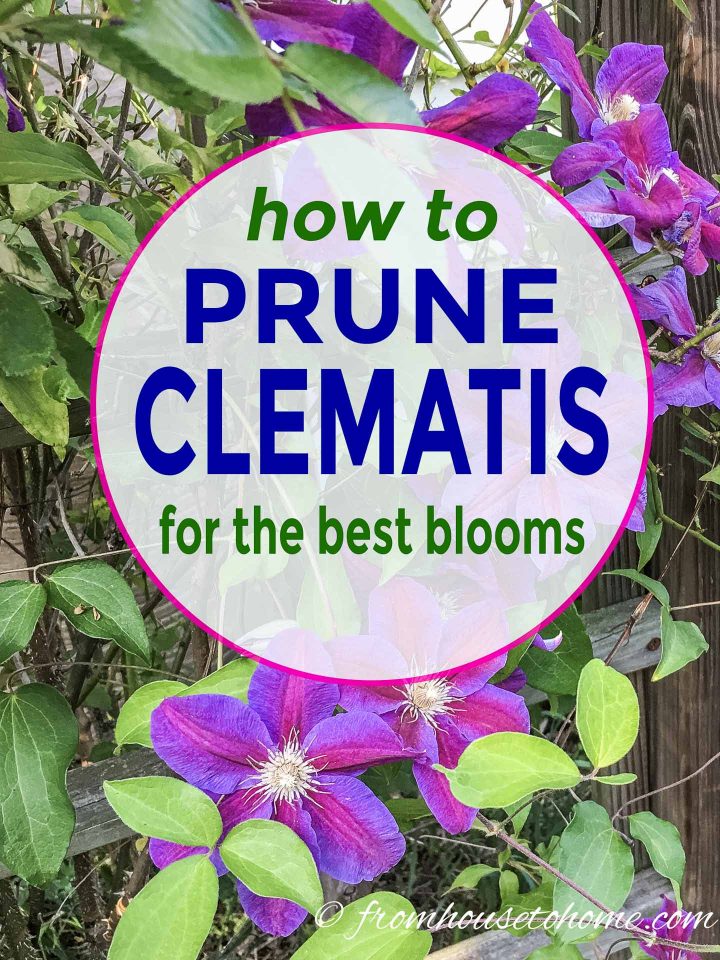
Pruning
Pruning seems like the most complicated part of Clematis care since different types should be pruned at different times.
The trick is to find out what type of Clematis you have so that you know when and how to prune it.
Clematis plants are generally divided into 3 groups, not very creatively named – group 1, group 2 and group 3.
The group that your variety falls in determines its pruning procedures.
[blockquote align=”center”]
Tip: If you're not sure which group your Clematis belongs to, try looking it up on Fine Gardening's website. Otherwise, use the descriptions below to figure out which one it's in.
[/blockquote]
Group 1
Group 1 Clematis have the following characteristics:
- flower in early spring
- has bell-shaped or small saucer-shaped flowers
- blooms on last year's shoots
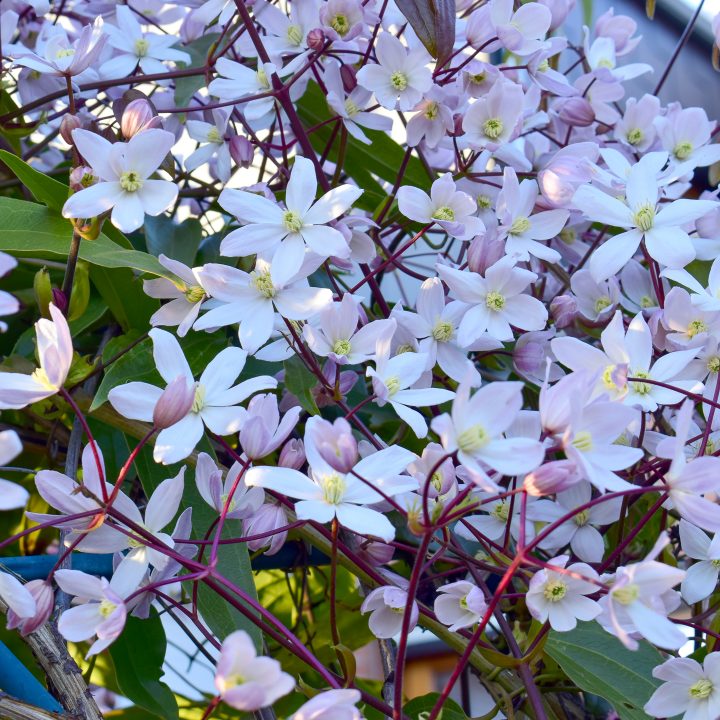
Group 1 should be pruned after they have bloomed to remove dead or damaged stems, and shorten the stems (if necessary), but do not need extensive annual pruning.
Group 2
Group 2 Clematis have the following characteristics:
- flowers in late spring and summer
- has large-sized flowers
- blooms on both last year's growth and this years new shoots
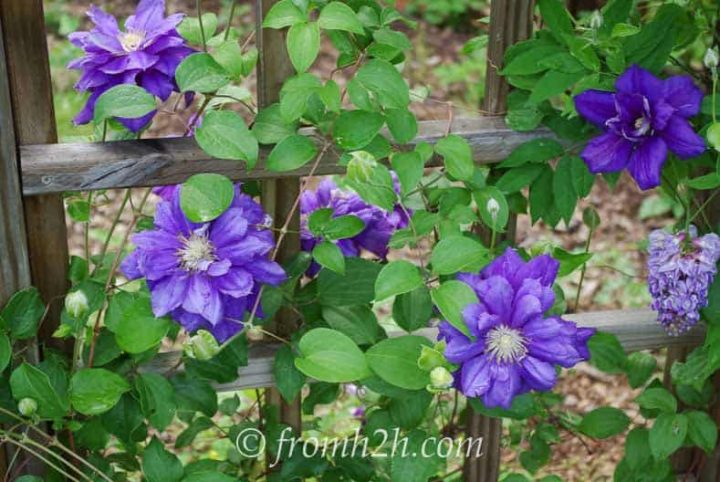
Pruning for group 2 should be done in early spring to trim stems just above strong buds (and to remove any dead or damaged stems).
Do not cut all the way back or you will reduce the number of flowers that you will get later.
Group 3
Group 3 Clematis have the following characteristics:
- flowers in summer or fall
- has large-sized flowers
- blooms on this year's growth
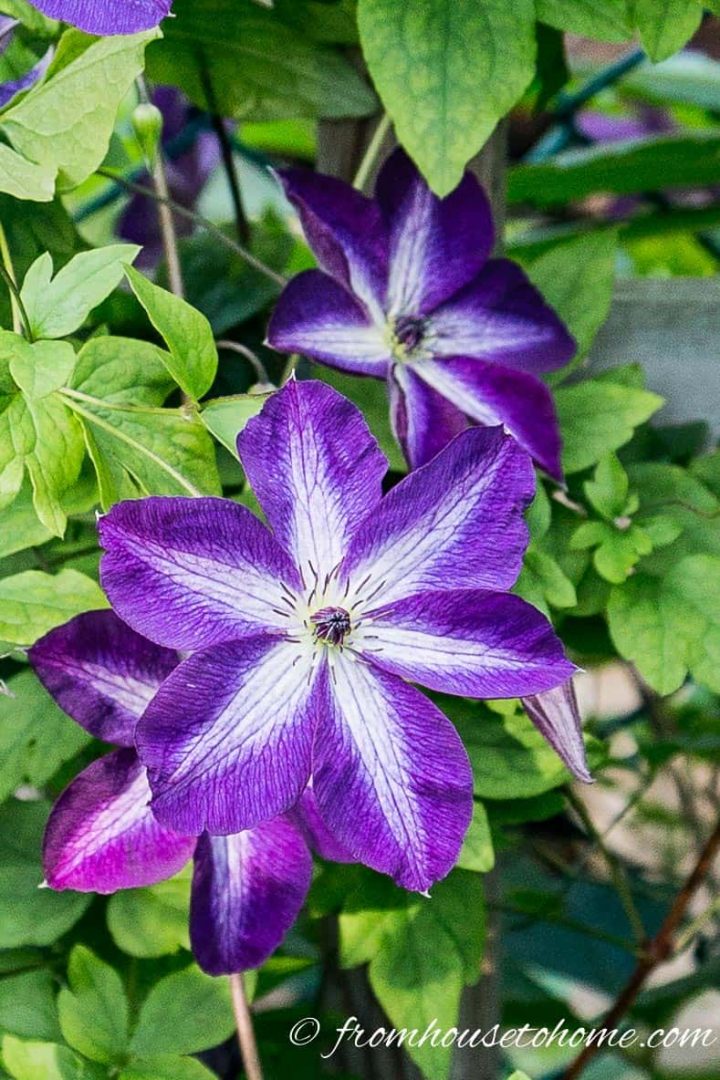
To prune group 3, cut the vines back to within 8 inches of the ground in early spring before new growth starts.
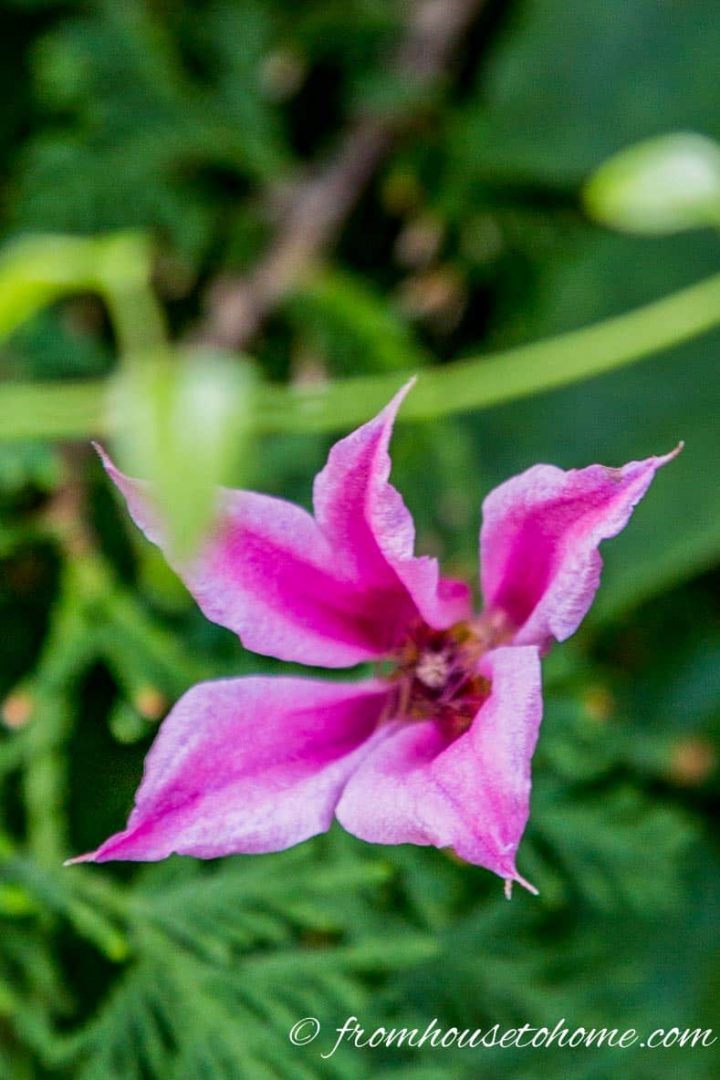
Other Varieties
With the popularity of Clematis vines, new varieties are being introduced all the time.
And they don't all fall into one of the traditional pruning groups.
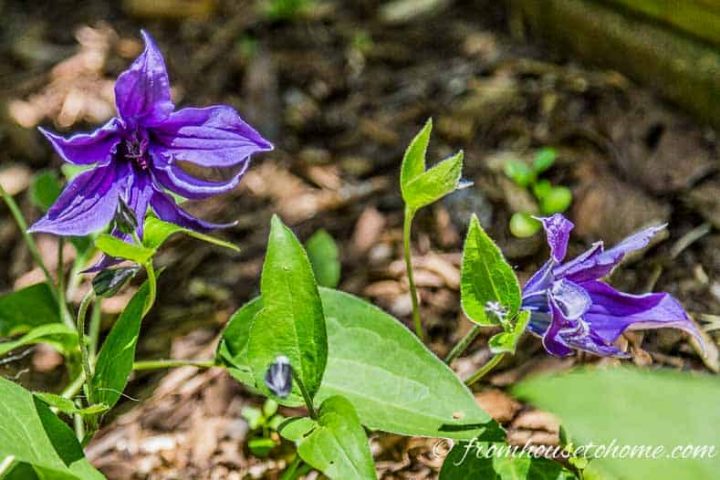
“Indigo Saphire” only grows to 3 feet tall and requires no pruning at all.
Since it doesn't get very tall, this is one of the varieties that I like to use as a ground cover.
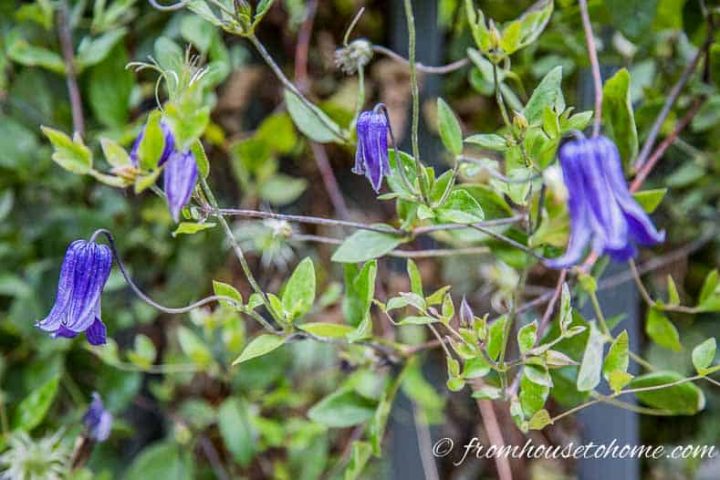
“Rooguchi” is a late spring bloomer that is not a true climber and should be cut all the way down to the ground in the early spring.
You can find out more about it in my “Best of” list below.
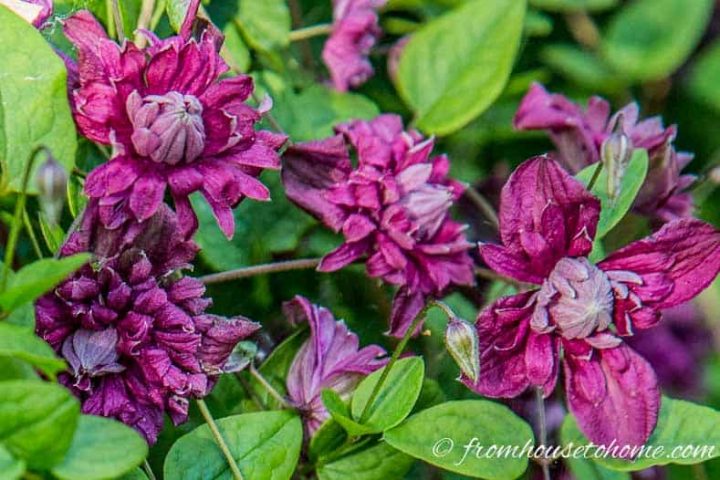
Clematis “Purpurea Plena Elegans” blooms on both old and new wood and benefits from pruning 1/3 of the branches each year so that the entire plant has been pruned every three years.
If after reading all the descriptions, you still aren't sure when to prune your plant, it is usually safe to do so immediately after it has finished blooming.
Having said all of that, there have been many times that I have neglected to prune my Clematis vines at all and they have still bloomed. So they're actually pretty forgiving.
They also seem to die all the way down to the ground occasionally but usually come back (just watch for the new shoots so you don't accidentally break them off).

The Best Clematis Varieties
Having grown a lot of different varieties of Clematis, I've come up with a few of my favorites, and a couple you might want to stay away from.
Toughest Clematis – ‘Venosa Violacea'
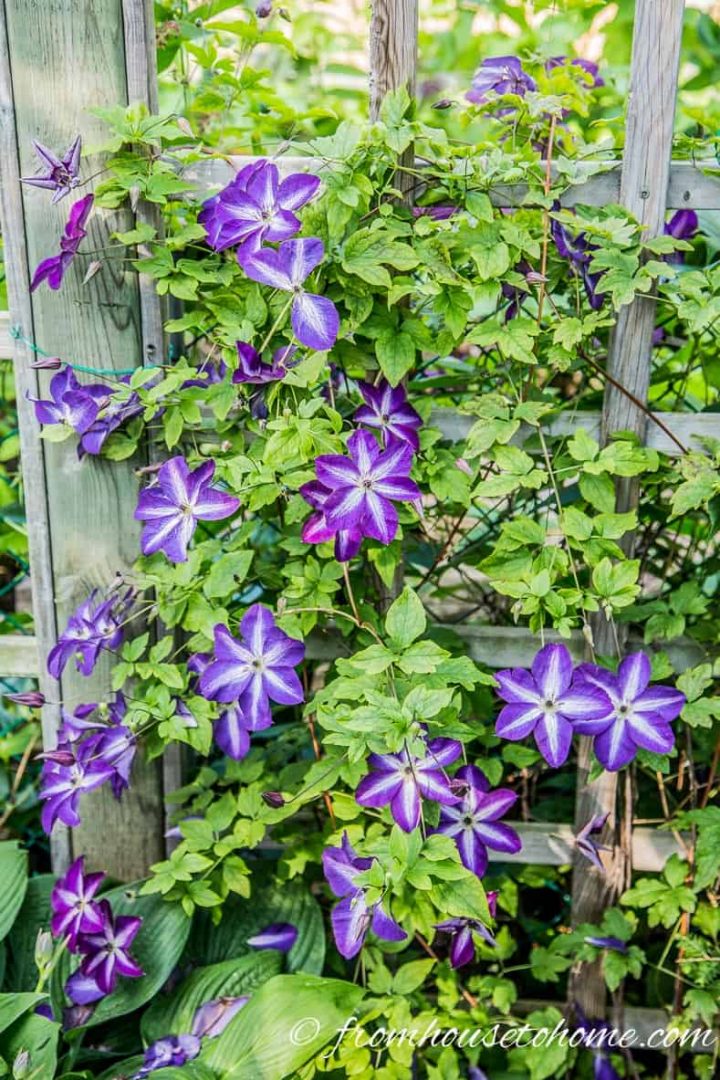
Clematis ‘Venosa Violacae' is a Victorian era French heirloom variety that has been around since 1893. And there's a reason why it is still popular today!
It blooms from spring until fall, doesn't seem to be phased by the heat, and even handles getting a little dry better than most Clematis.
Biggest Show – Clematis ‘Josephine'
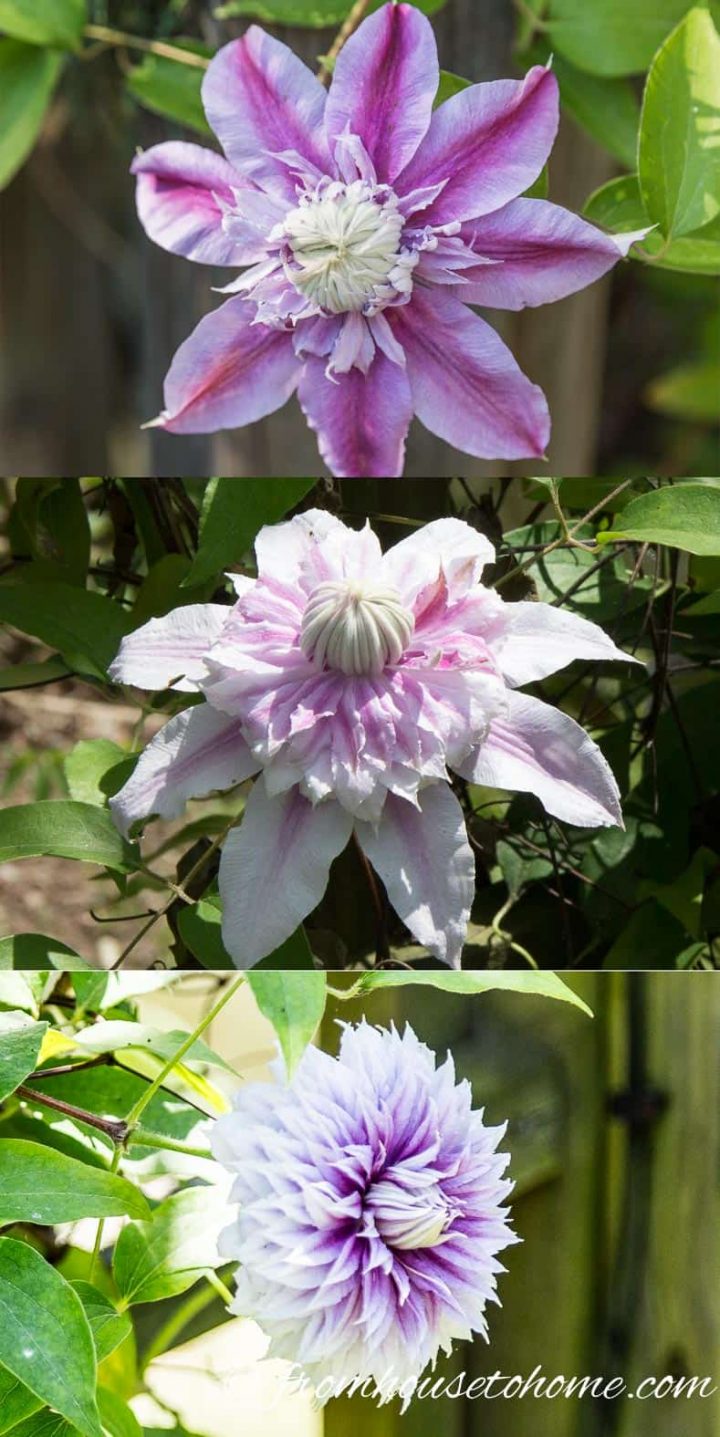
If you're looking for a Clematis that has big beautiful, multi-petal blooms, Josephine may be your girl!
She starts out like the picture above with dark pink single petals around the outside of a fluffy light pink center.
As the flower matures, the outside petals fall off and leave a flower that is a big fluff ball.
Not all of the flowers on the plant go through all of the stages (some go straight to the third stage), but they're still pretty.
Best Double Clematis – ‘Franziska Marie'
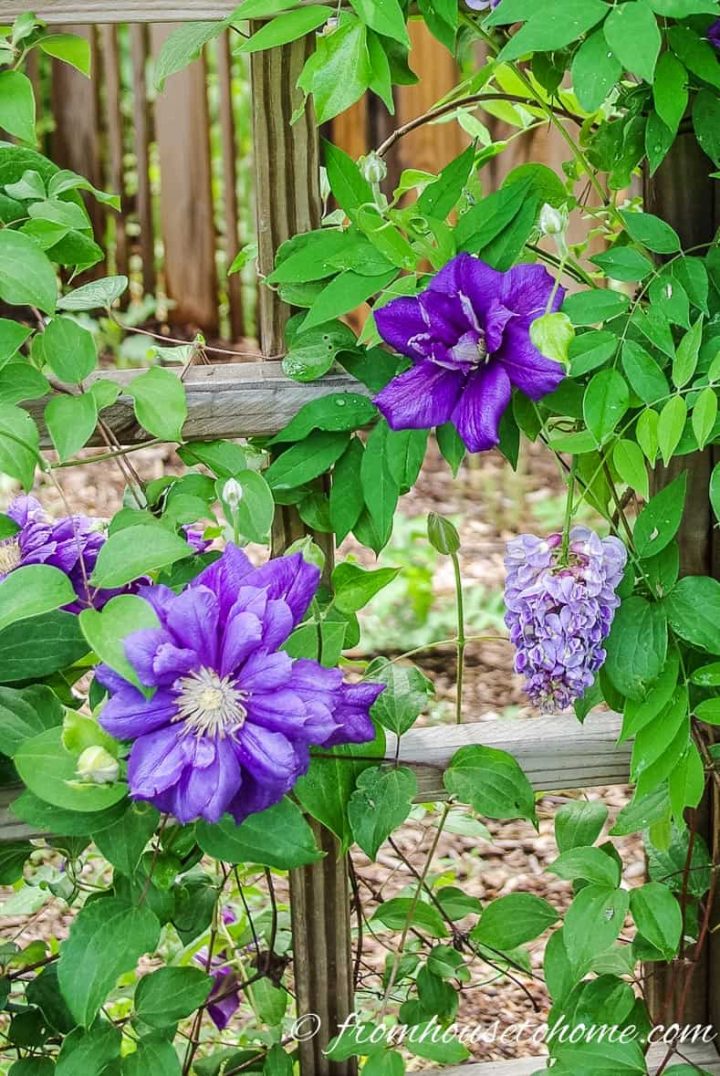
Clematis ‘Franziska Marie' has big double purple blooms that last all summer long.
The early blooms come out on old wood, and the later blooms grow on new wood, so even if it gets cut off by accident, you will still get some beautiful flowers!
Best Blue Clematis Variety – ‘Alice Fisk'
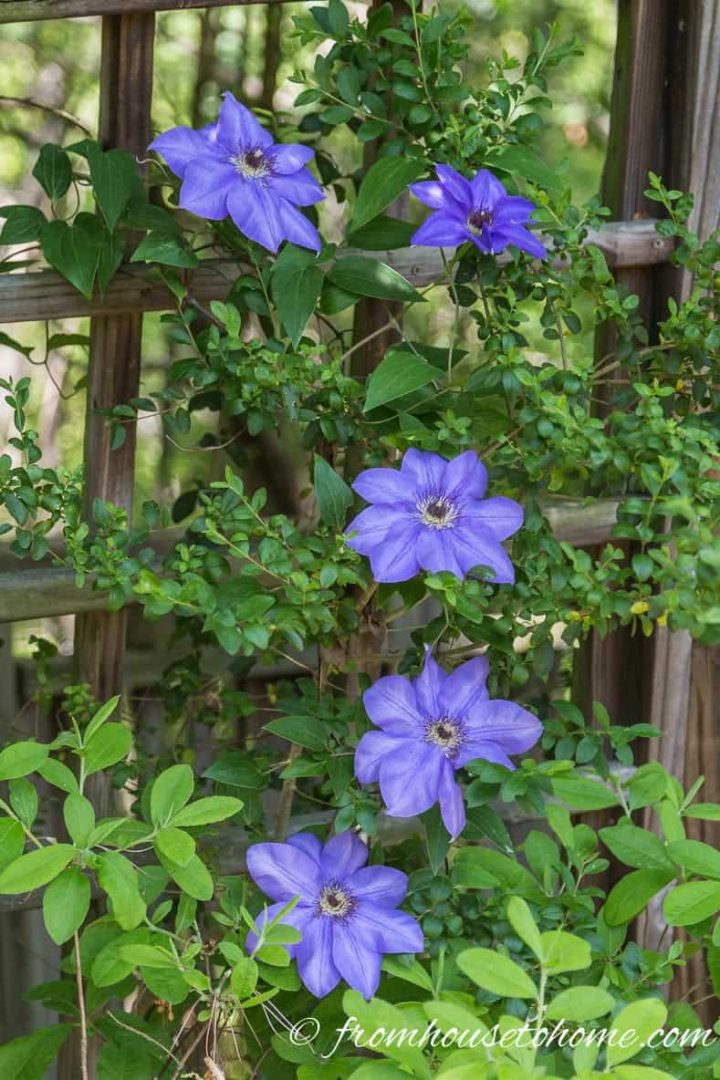
Clematis ‘Alice Fisk' has huge, eight-inch, periwinkle blue flowers that really stand out against the green foliage.
It grows through the arbor at the back of my yard and I can see the blooms clearly from the house.
Best Fuchsia Clematis – ‘Princess Diana'
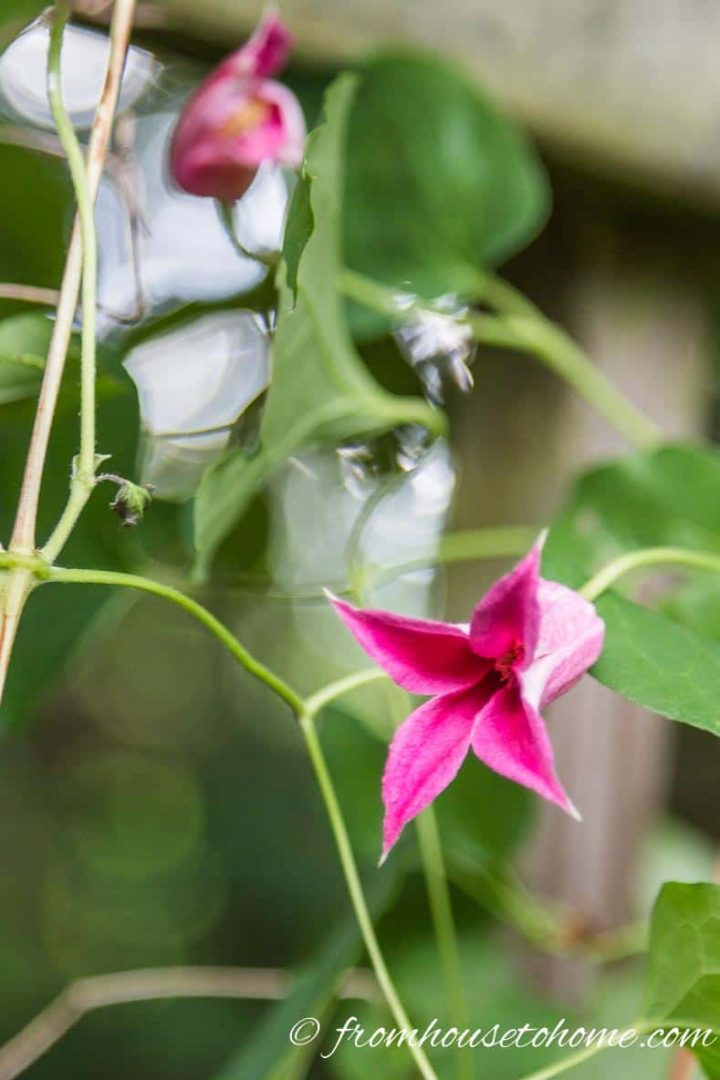
If you're looking for a bright pink Clematis, ‘Princess Diana' may be perfect.
Although the flowers aren't as big as some of the other Clematis varieties, it blooms profusely and the bright color makes up for its smaller size.
Best Striped Clematis – ‘Beth Currie'
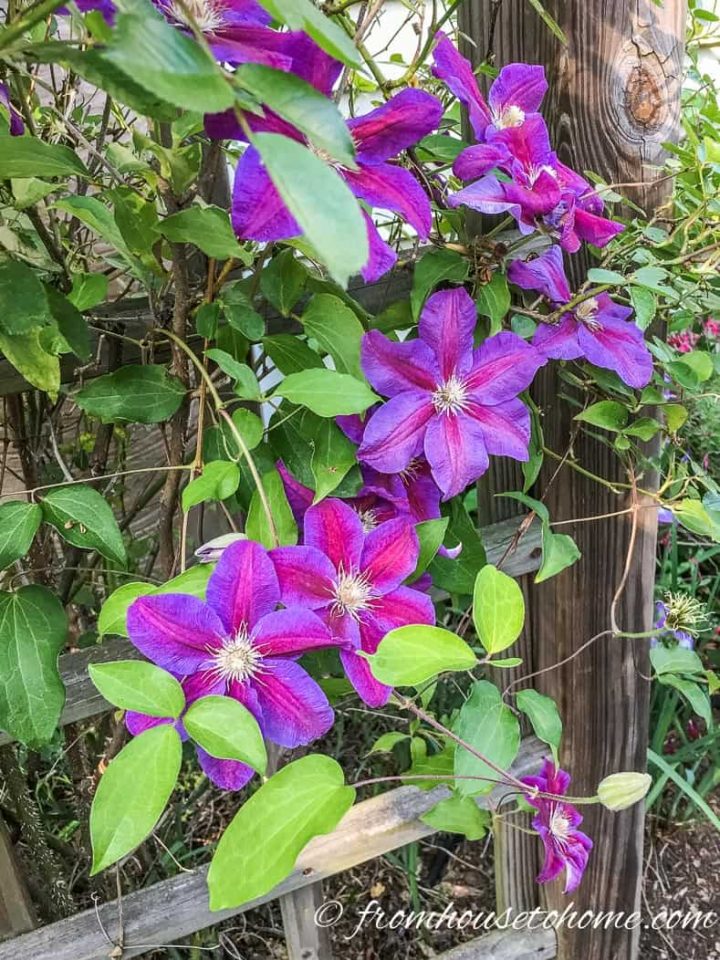
Clematis ‘Beth Currie' has purple and pink striped flowers that really stand out in the garden.
I like to plant mine with pink roses which complement the colors.
Most Aggressive – Clematis integrifolia ‘Rooguchi'
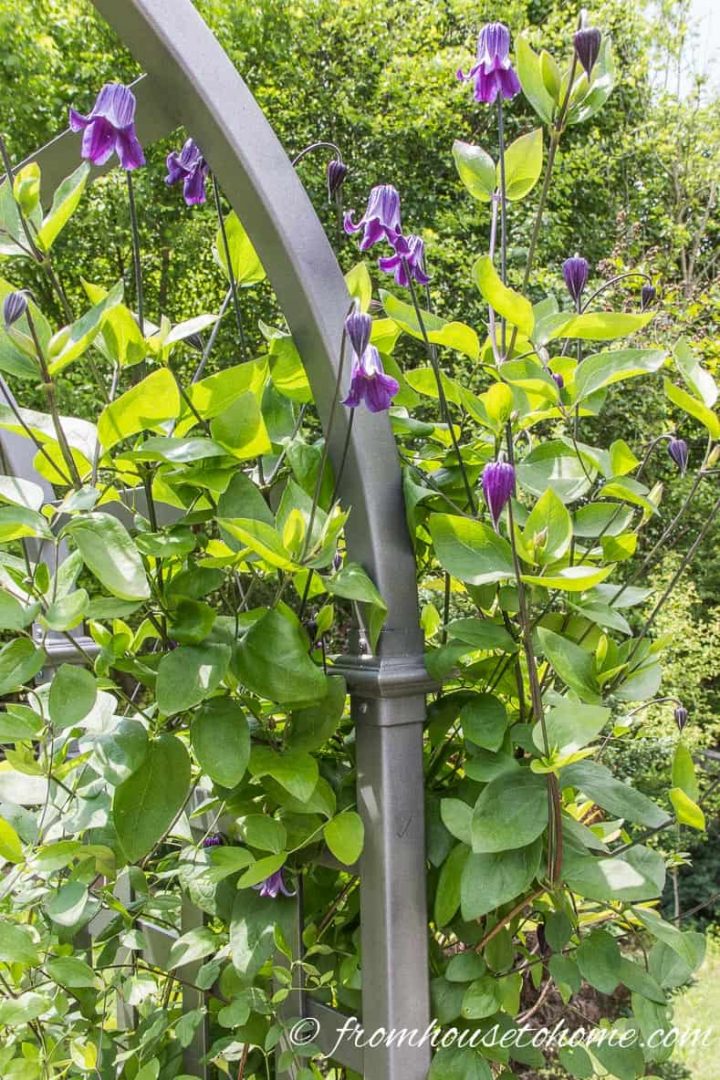
Clematis integrifolia ‘Rooguchi' has really pretty purple blue flowers and blooms profusely.
The big difference is that the plant is more like a bush than a vine. And it can easily choke out other smaller plants.
So while I still have this in my garden, I would recommend planting it in a location where it has lots of room to spread out.
Most Invasive – Autumn Clematis
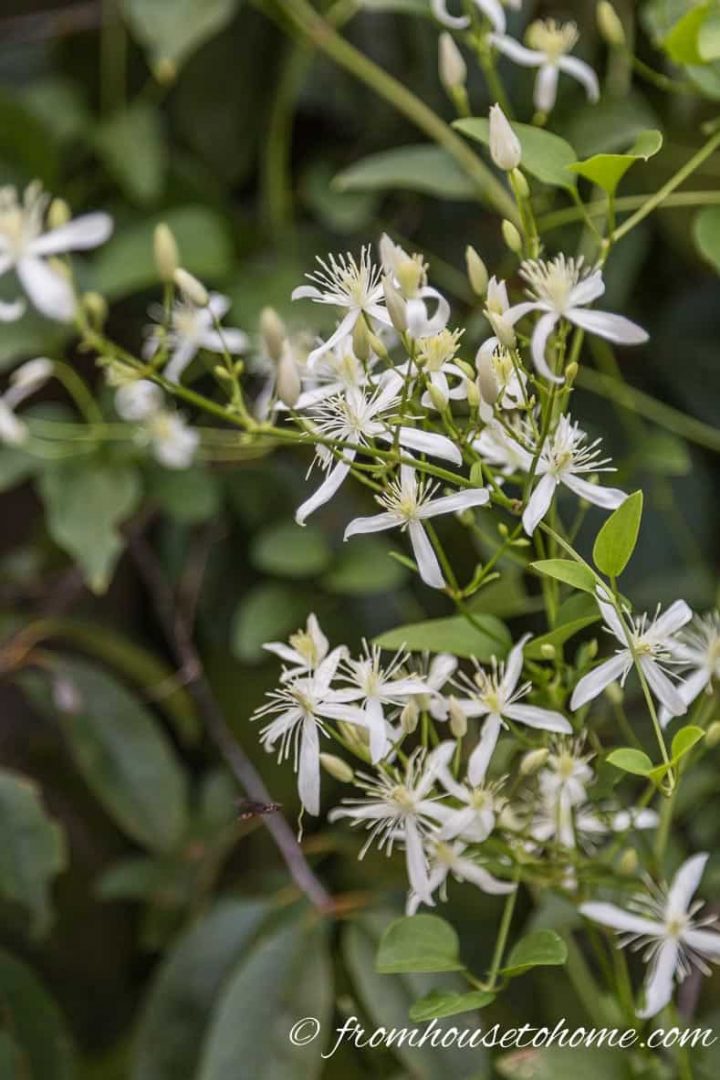
There's only one Clematis that I will not plant in my garden again, and that's the Autumn Clematis (Clematis ternifolia).
I had one growing beside an arbor in my yard and it never really did much (ie. I thought it had died) so I kind of forgot about it.
Until I saw it joining the Kudzu and Japanese Honeysuckle that are growing rampant over the trees in the ravine behind my house.
Then I looked it up and found it on the South Carolina invasive plants list…so I learned this lesson the hard way. Click HERE if you want to find out more about invasive plants.
Of course, depending on the climate and growing conditions in your area, it may or may not cause problems. Be sure to check with your local nurseries or other gardeners to find out before planting it.
Where To Find Other Varieties
If you want to find a Clematis that's right for your garden, or maybe are trying to identify one you already have, you can try out this web search tool.
You can enter in the color you are looking for, pruning group, and/or zone (among other characteristics) and it will give you a list of varieties that match along with their pictures.
Where to Buy Clematis
Here are a few of my favorite places to buy Clematis:
You can find more of my favorite places to buy plants online HERE.
Now I'm off to see if I can find variety #26 to add to my garden 🙂 And hopefully, you've found some inspiration for growing your own beautiful Clematis.
Other Perennials You Might Like
- 9 of the Best Flowering Vines For Shade
- Our Favorite Shade Plants
- How To Design A Stunning Shade Garden (With Pictures)
Do you have a comment or question about how to care for Clematis? Tell us in the section below.
Pin It So You Don't Forget It!
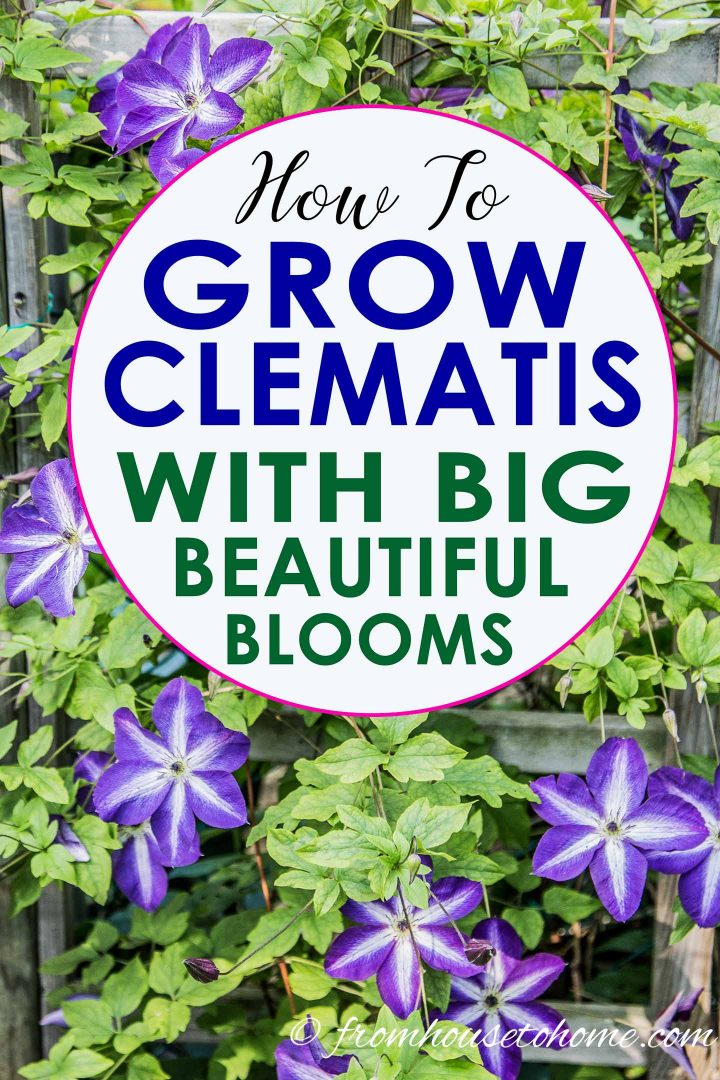
This post was originally published on May 16, 2017 but was updated with new content on November 23, 2024.


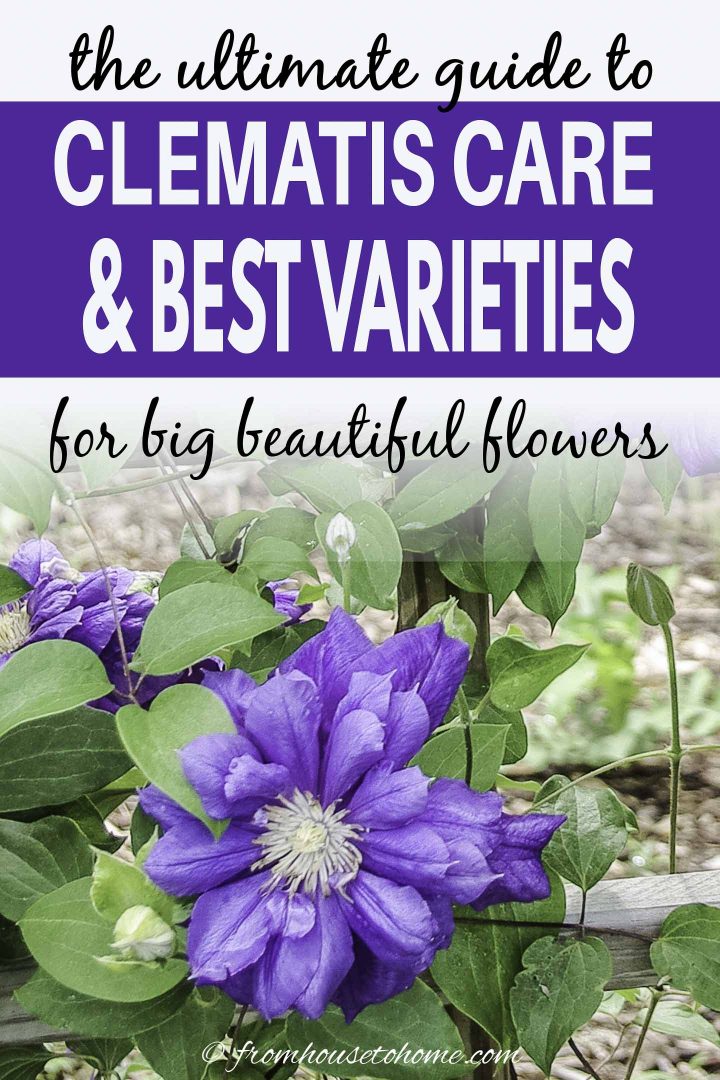
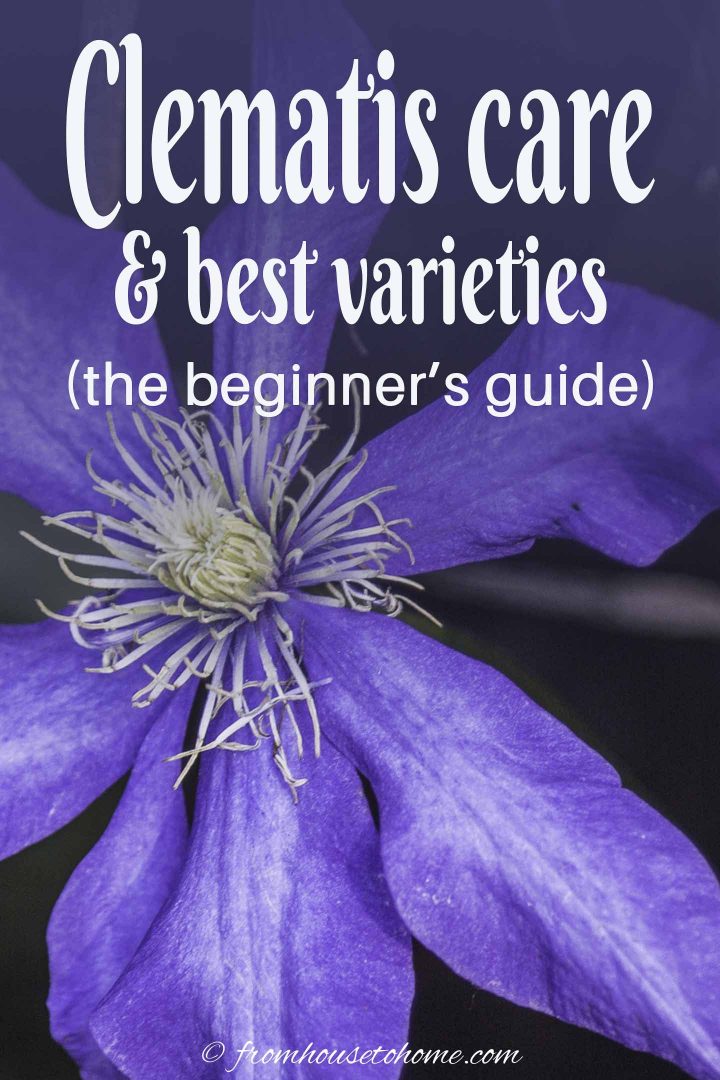
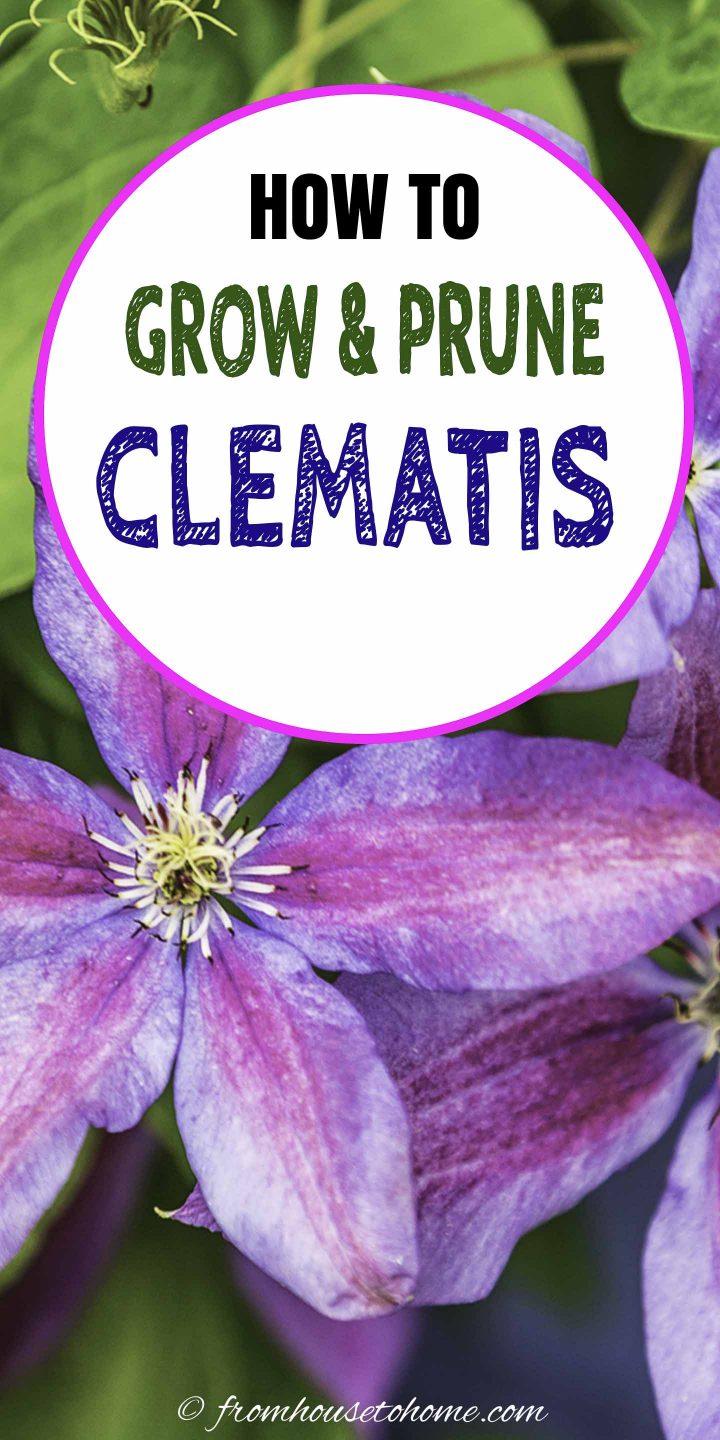
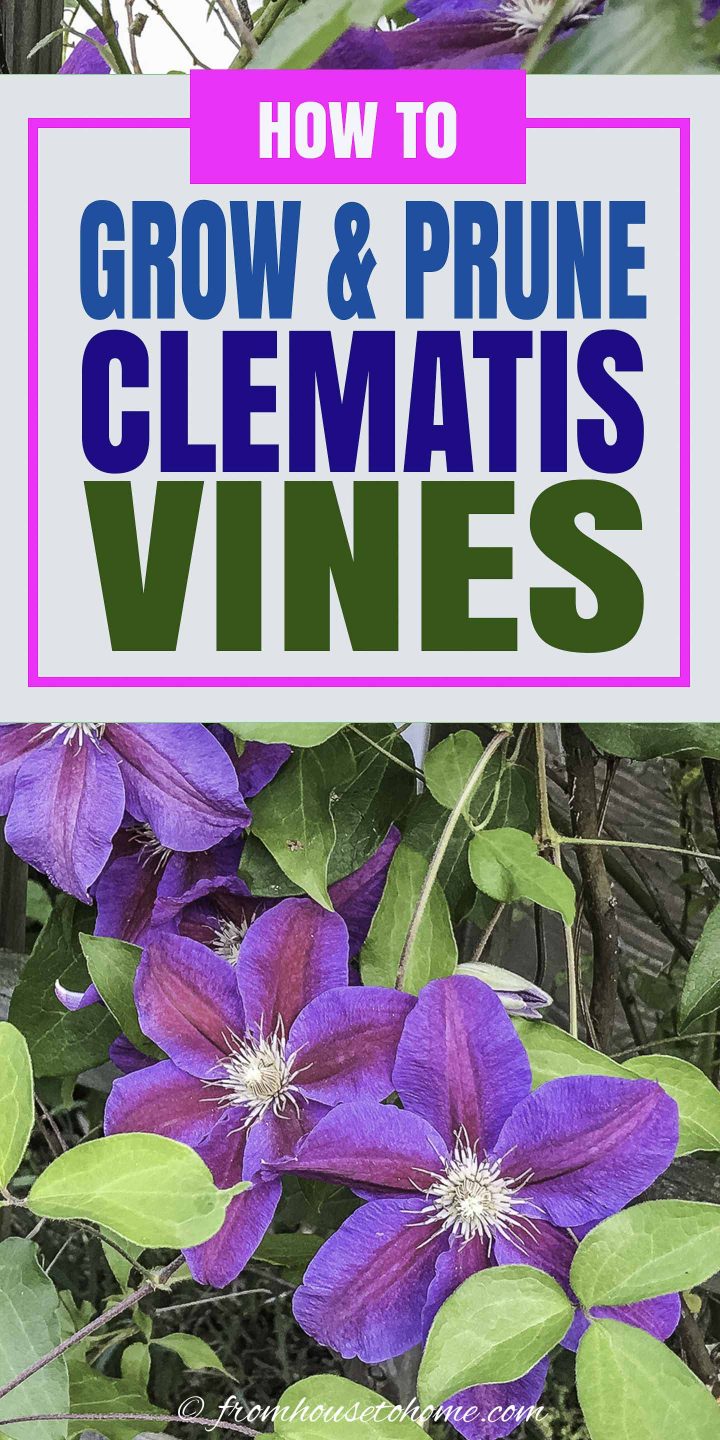
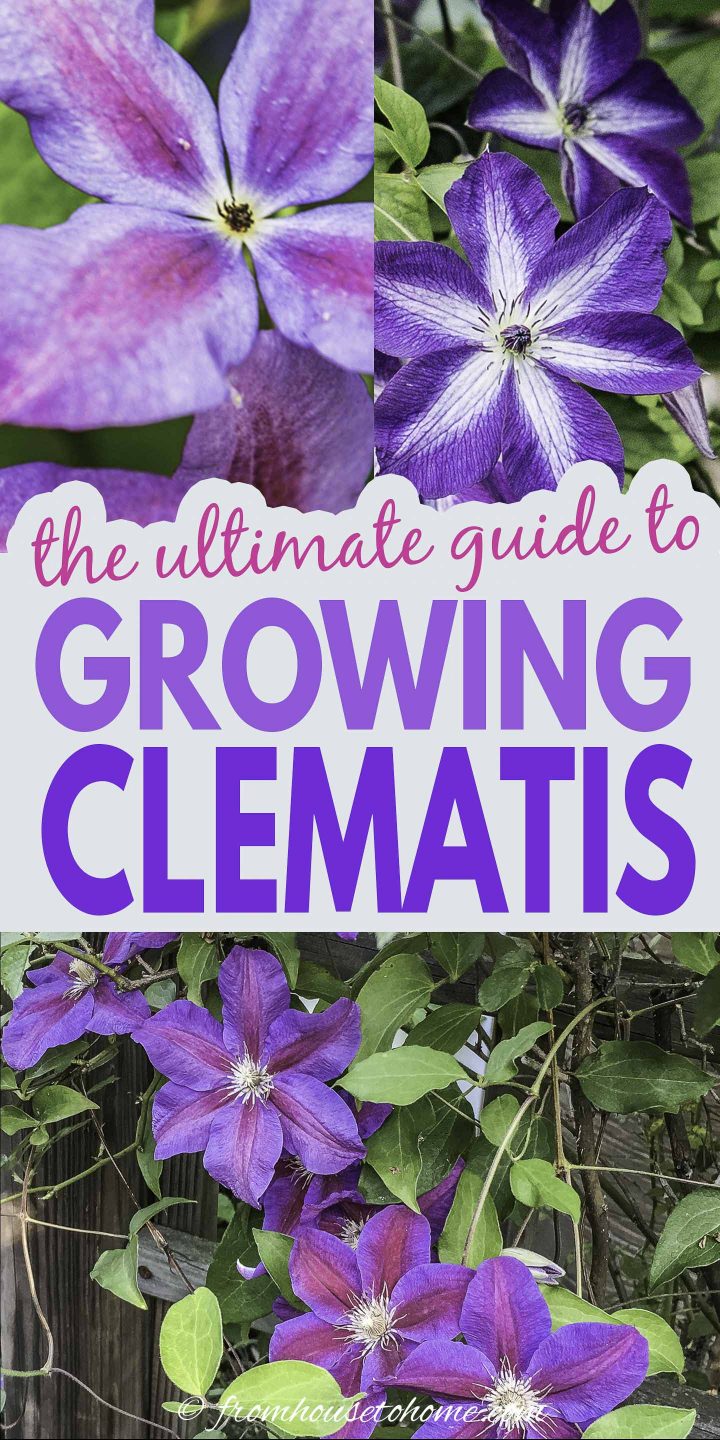
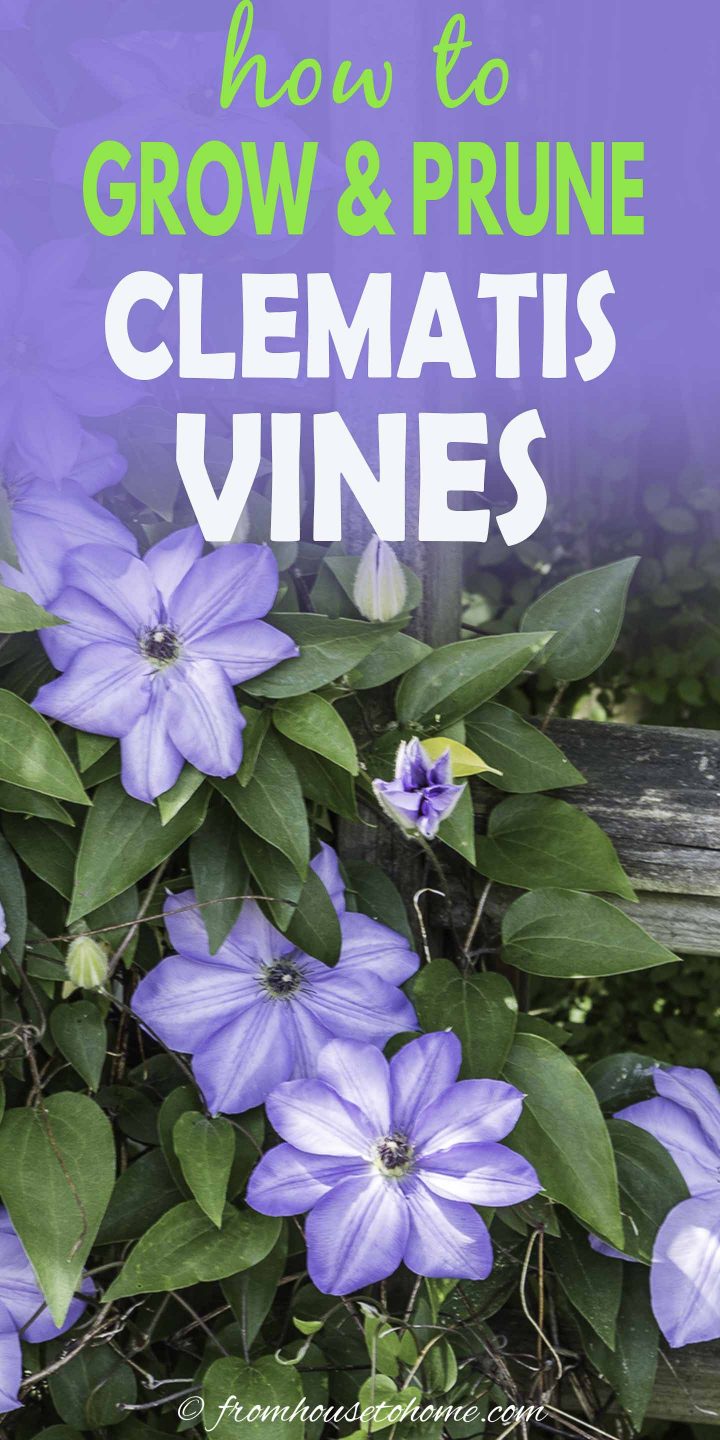
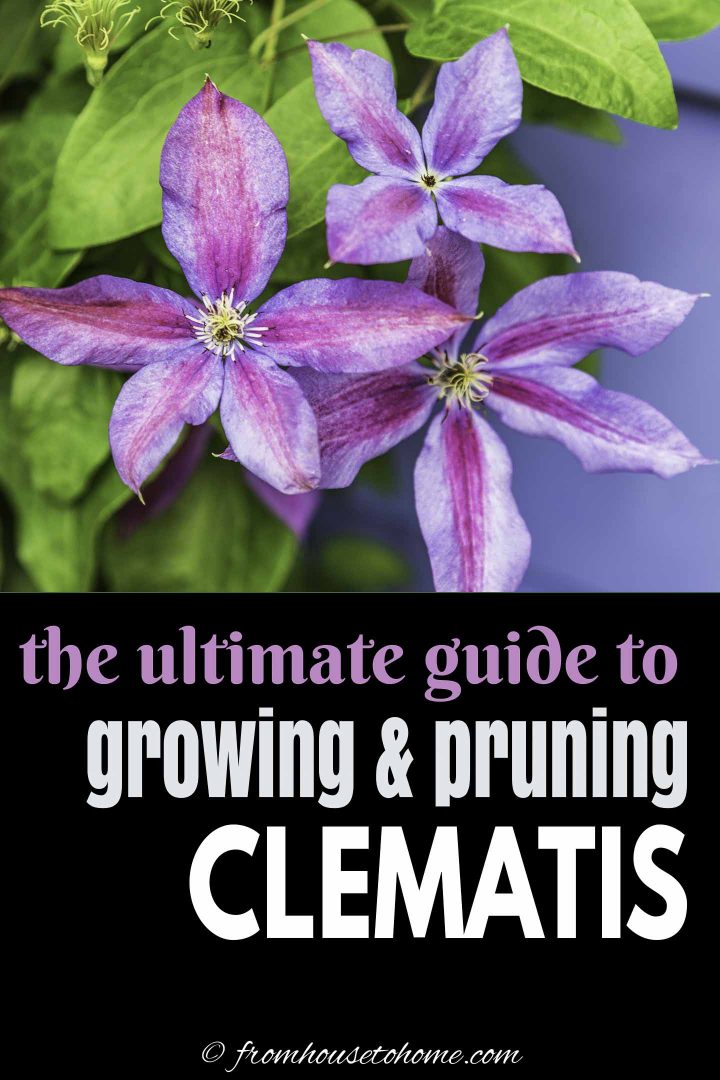
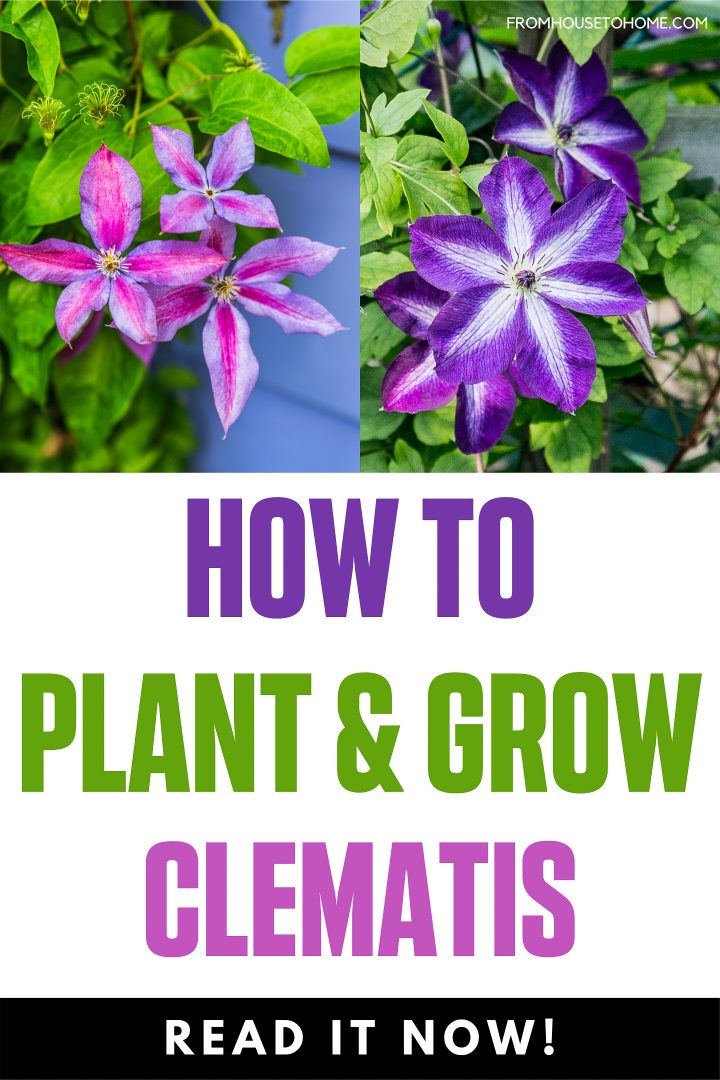
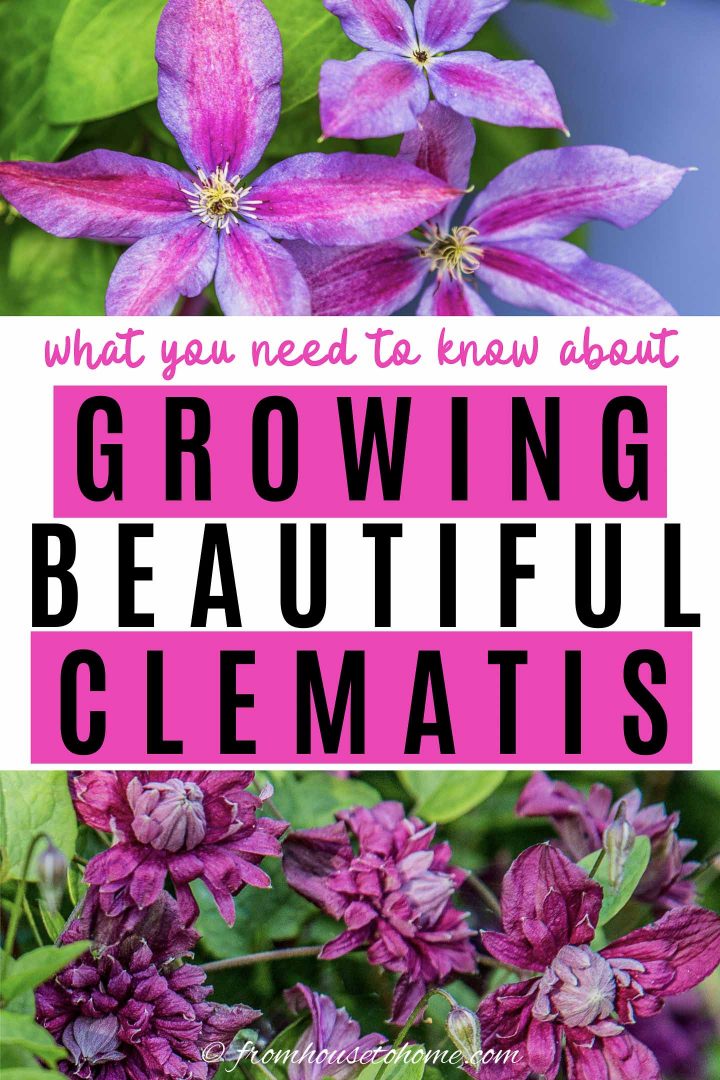
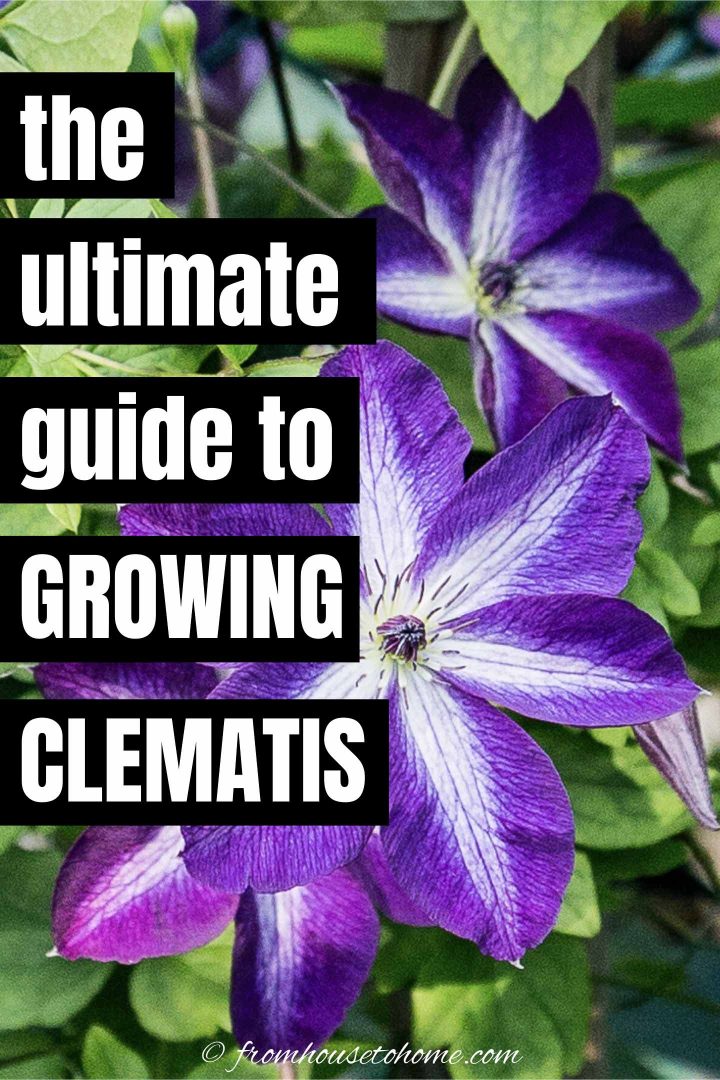
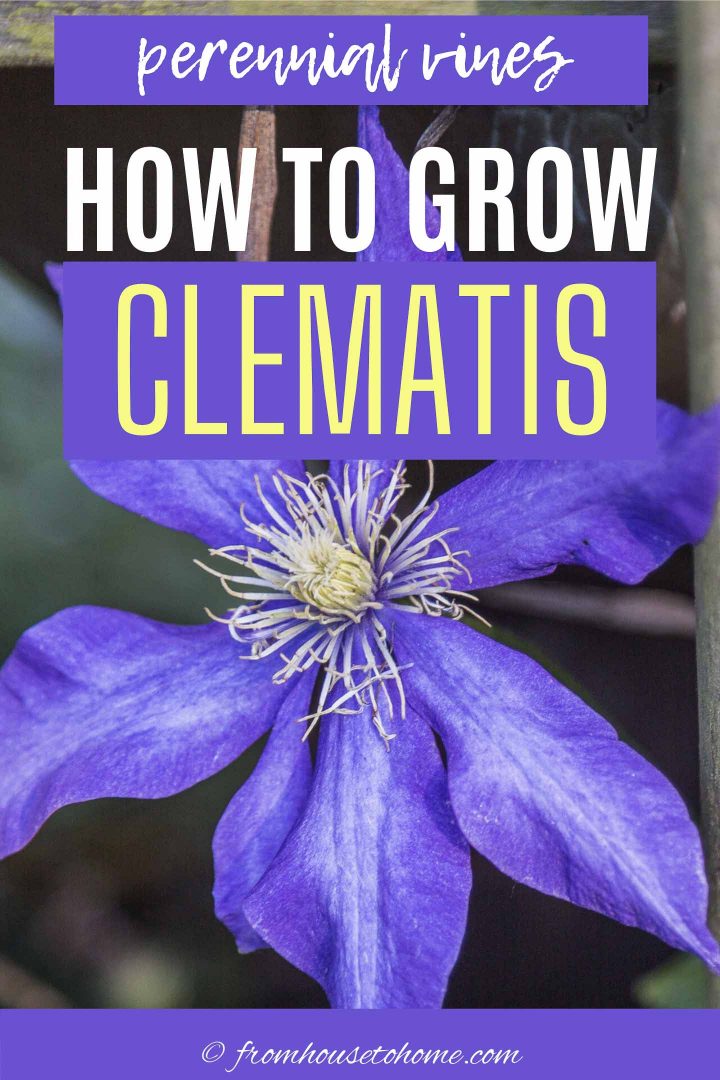
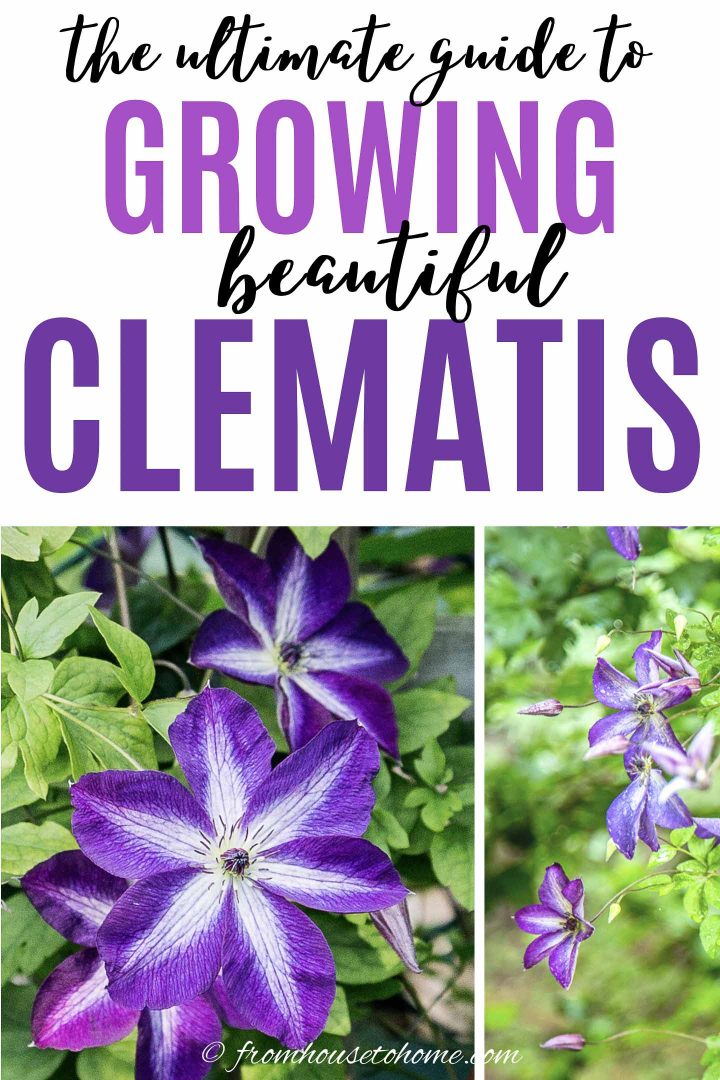
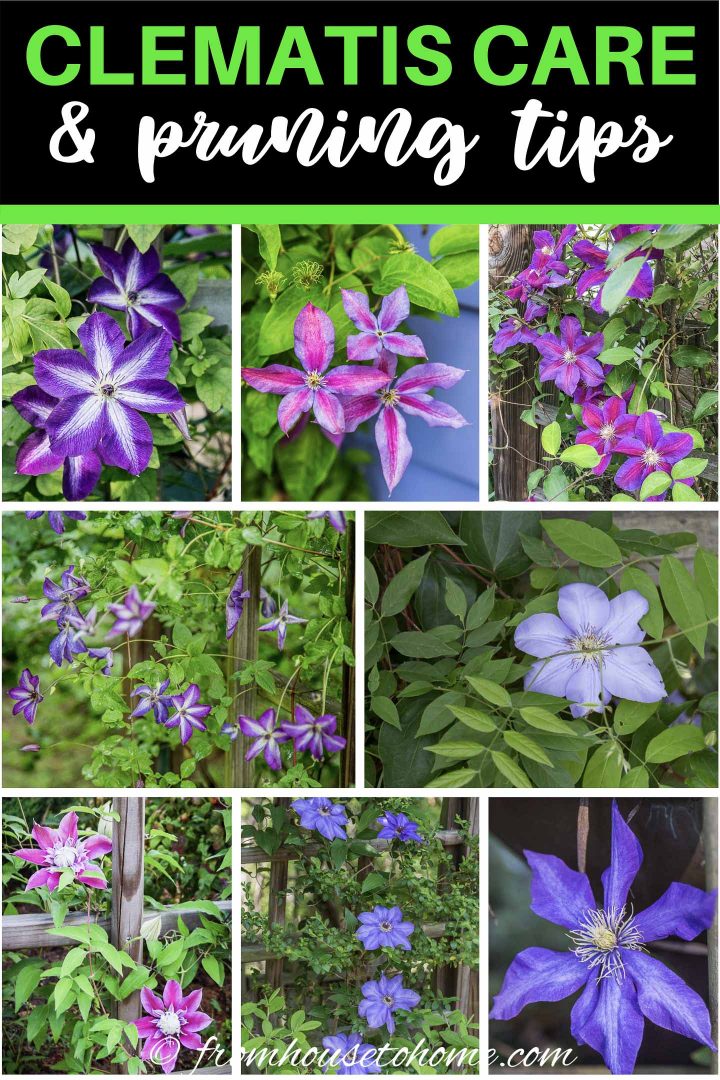
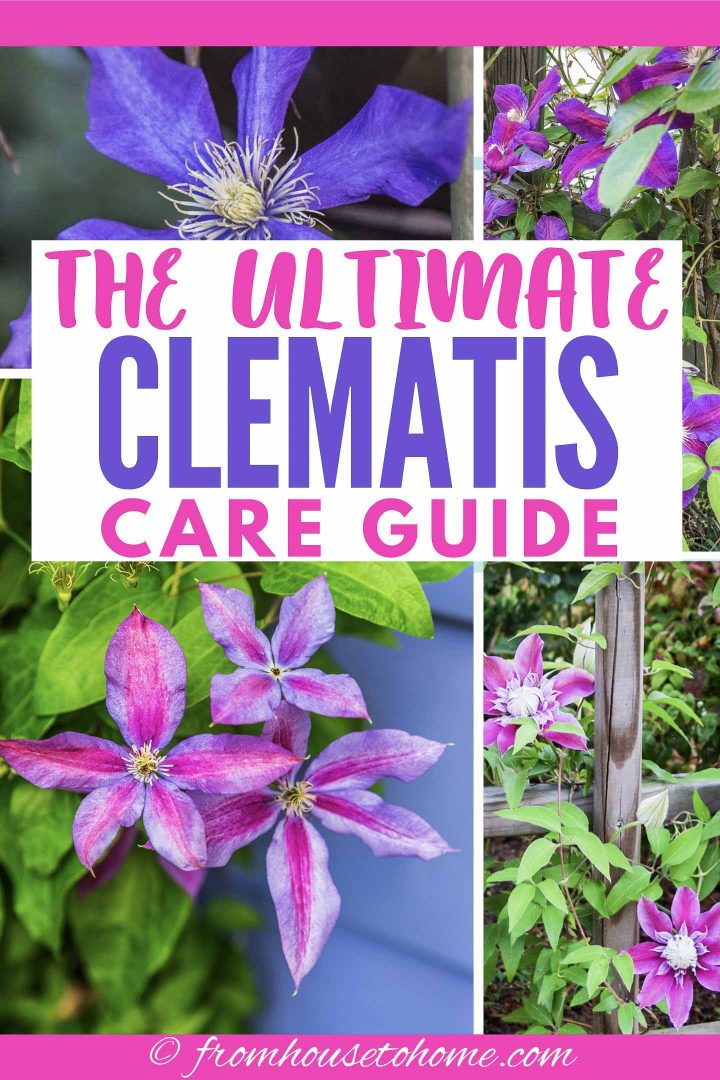
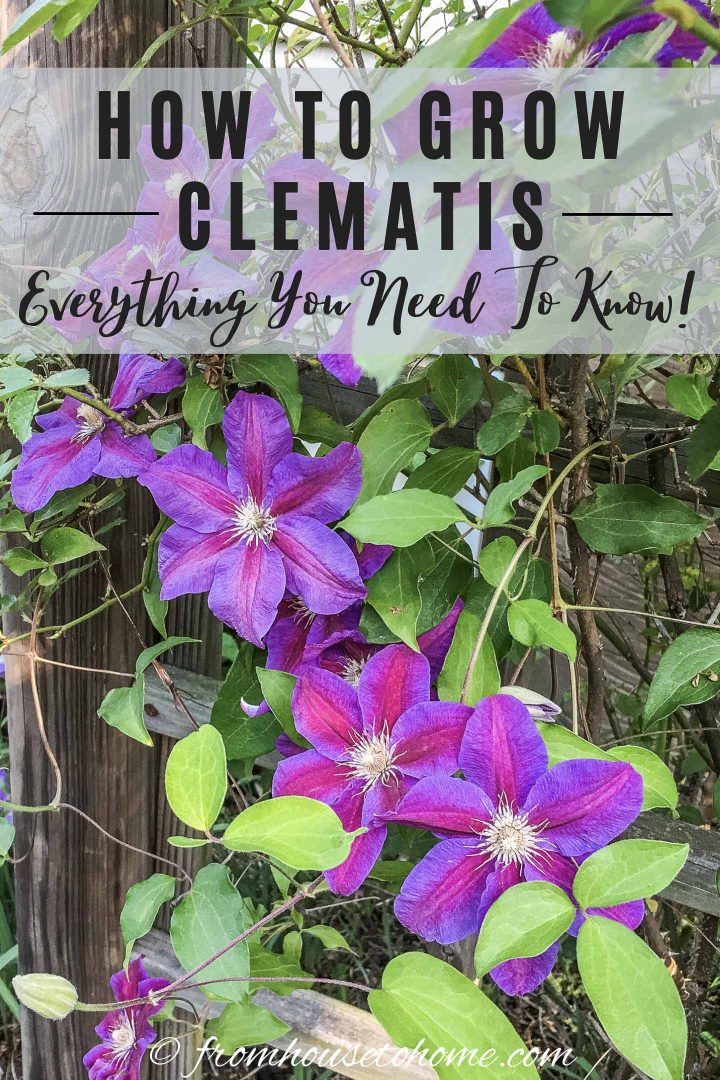

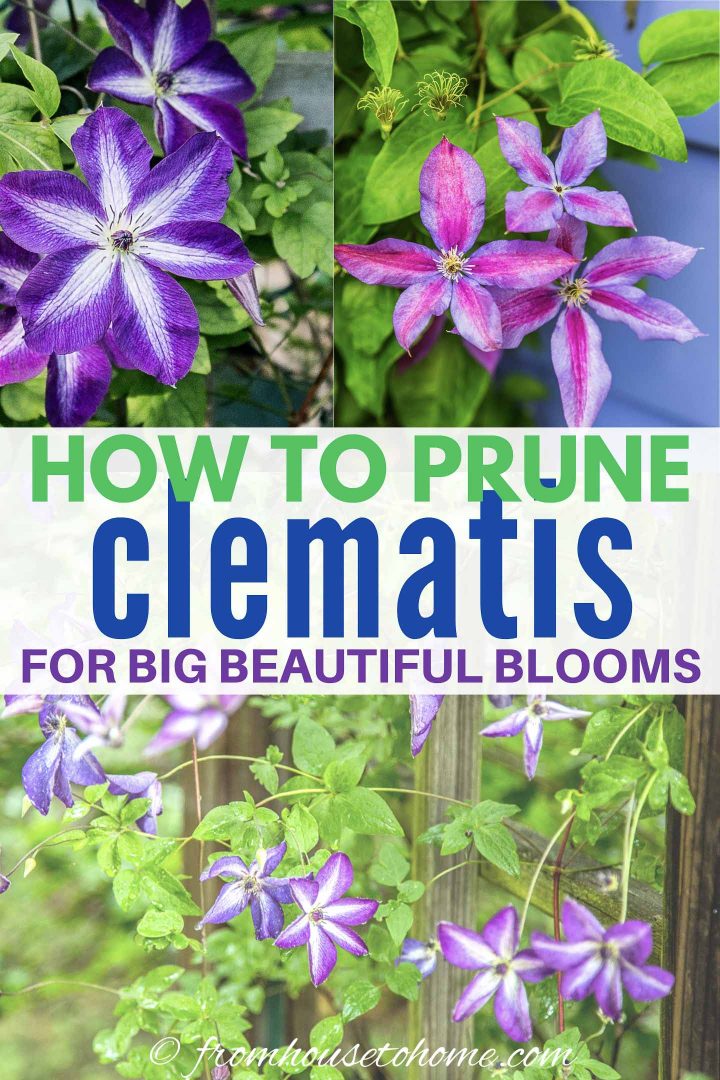

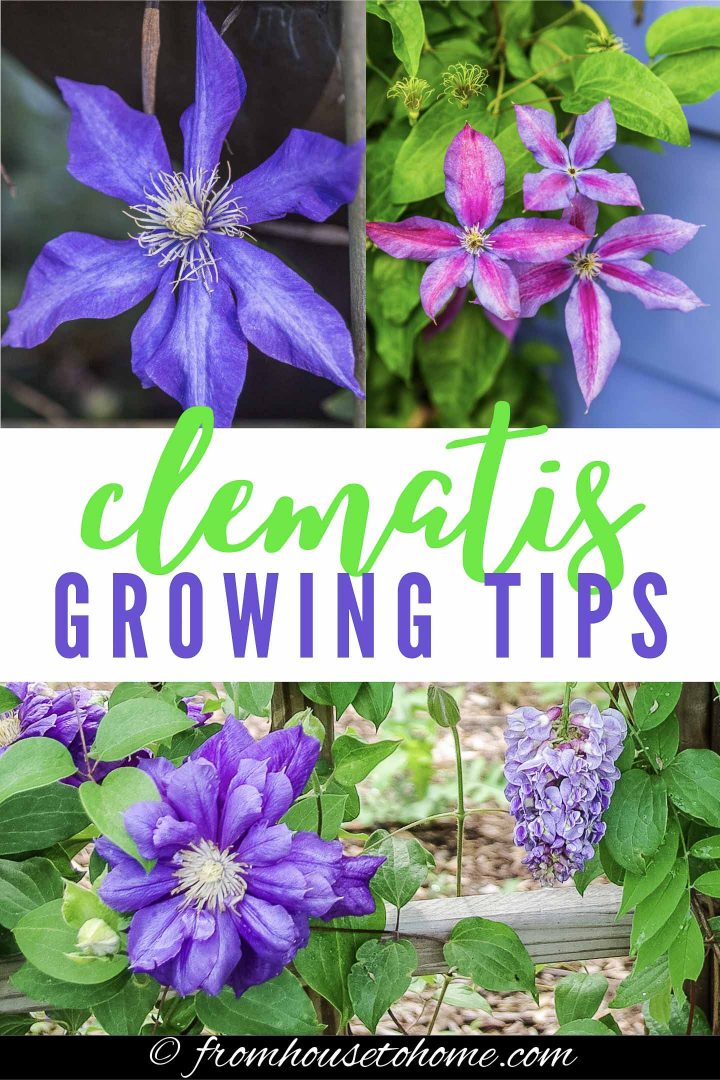

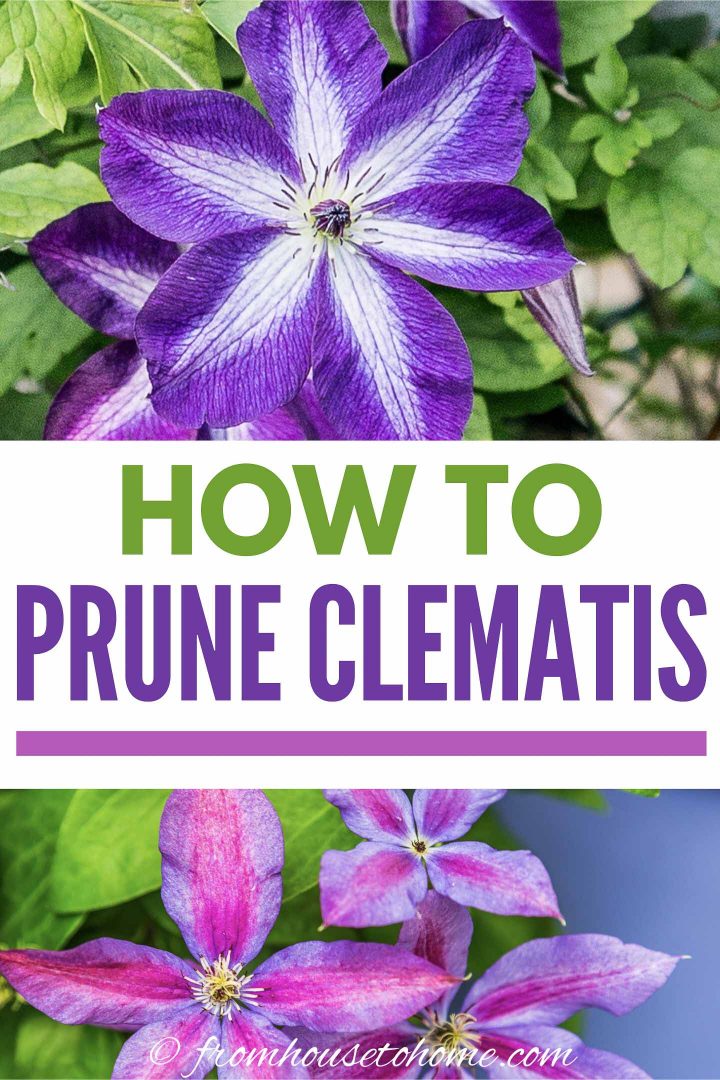


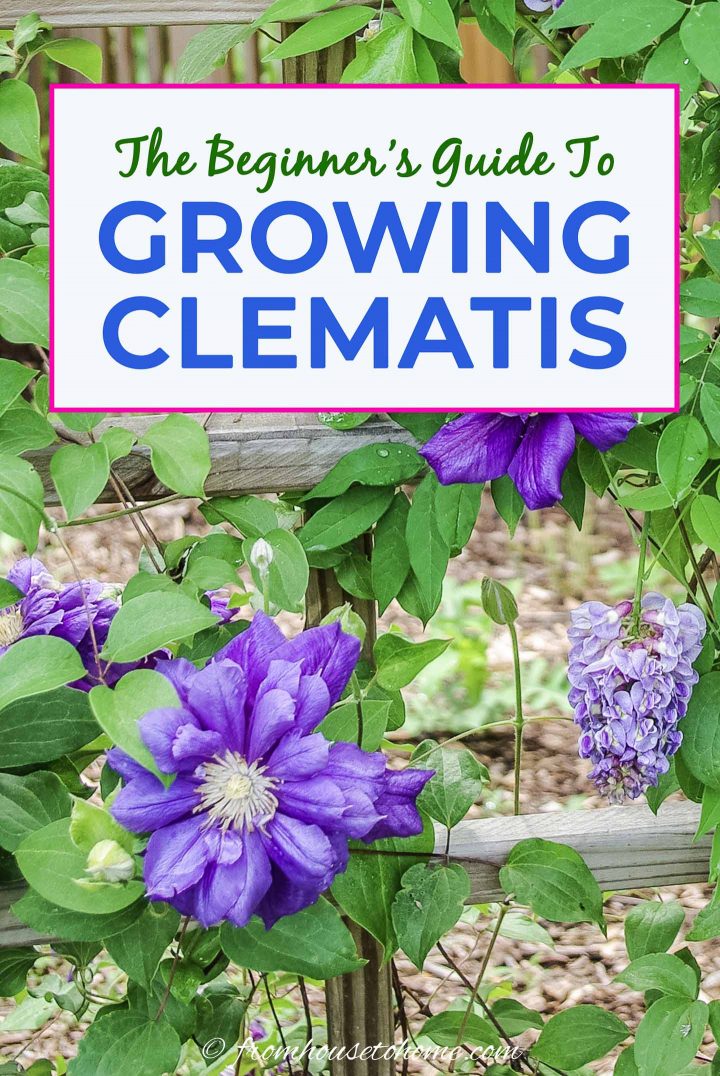
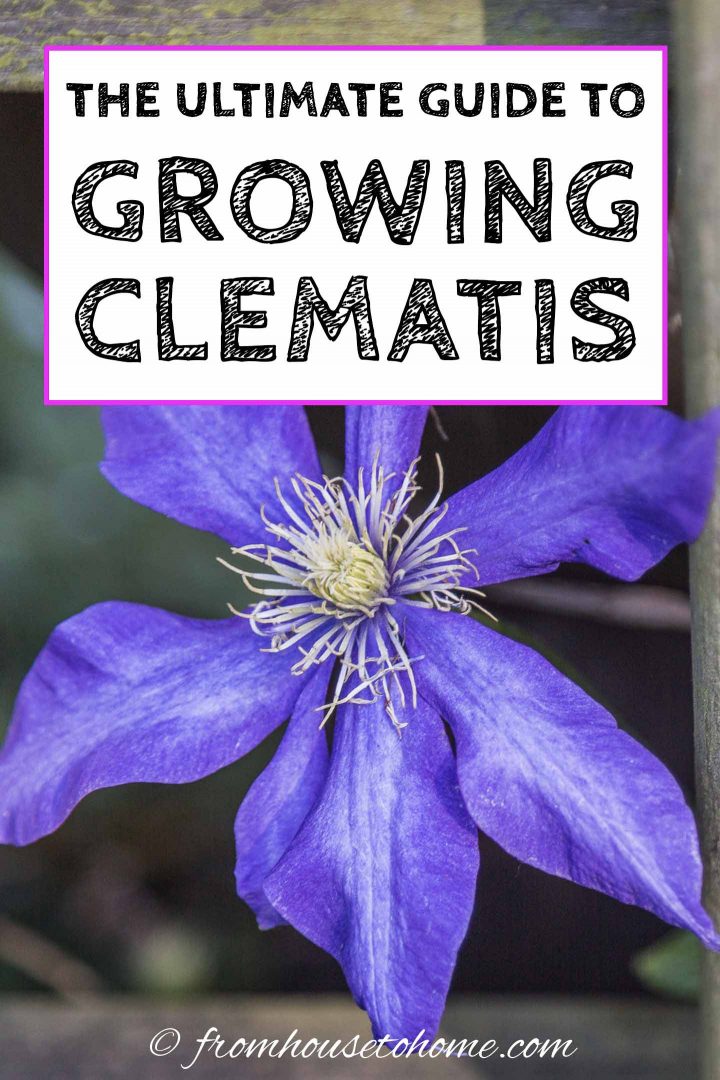
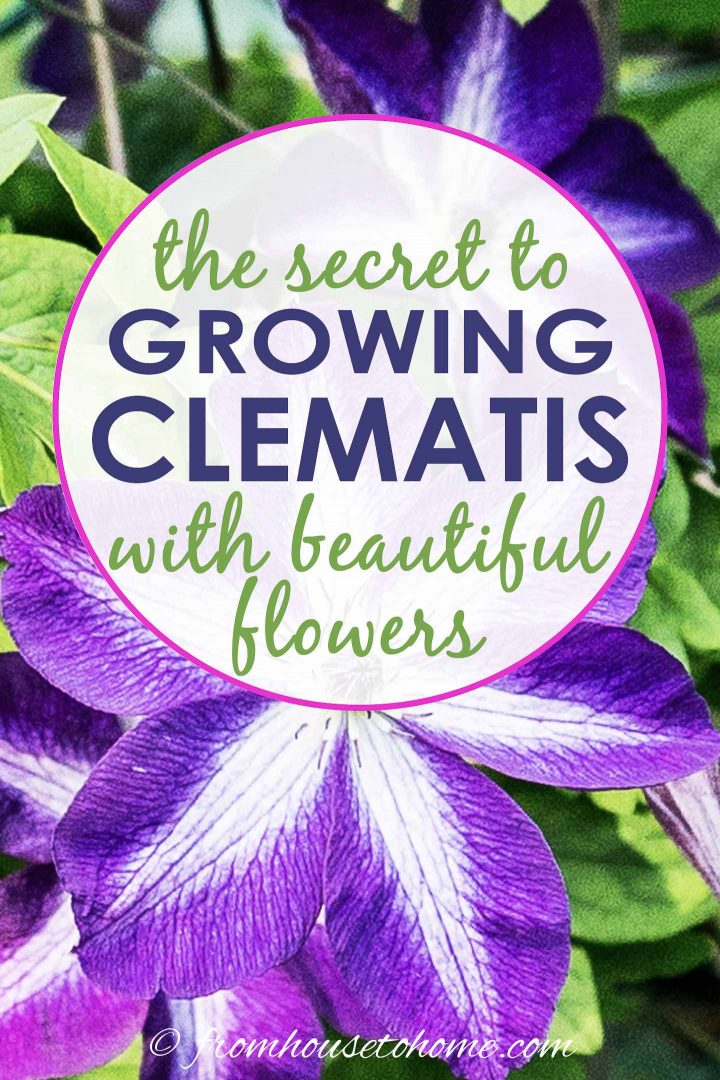
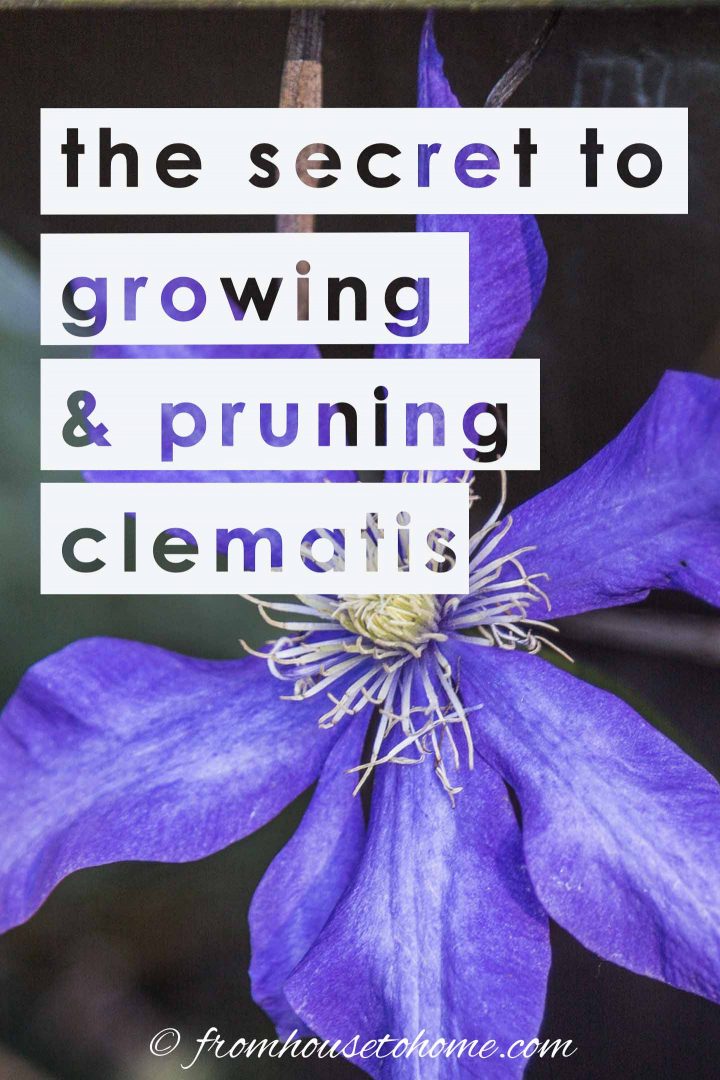
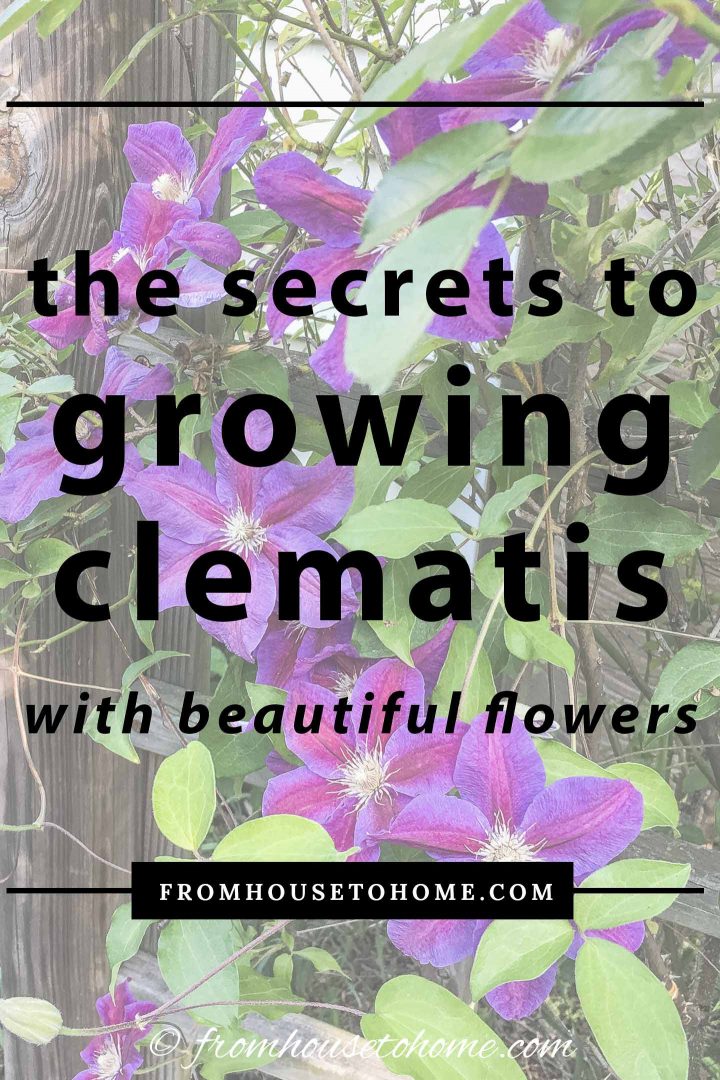
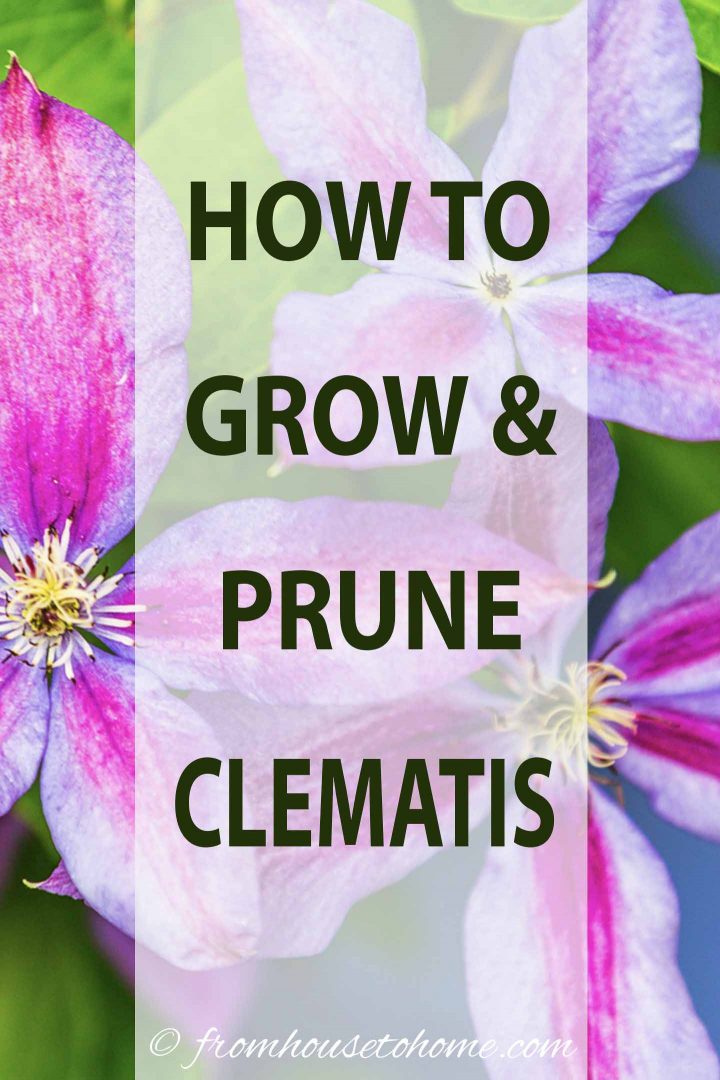


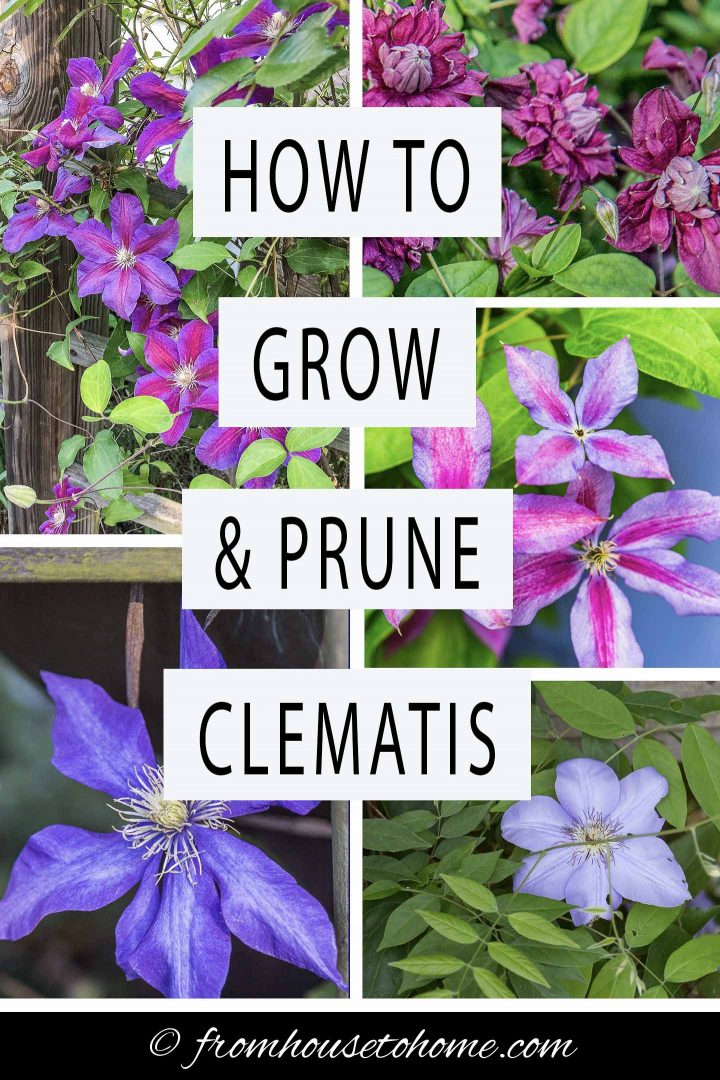
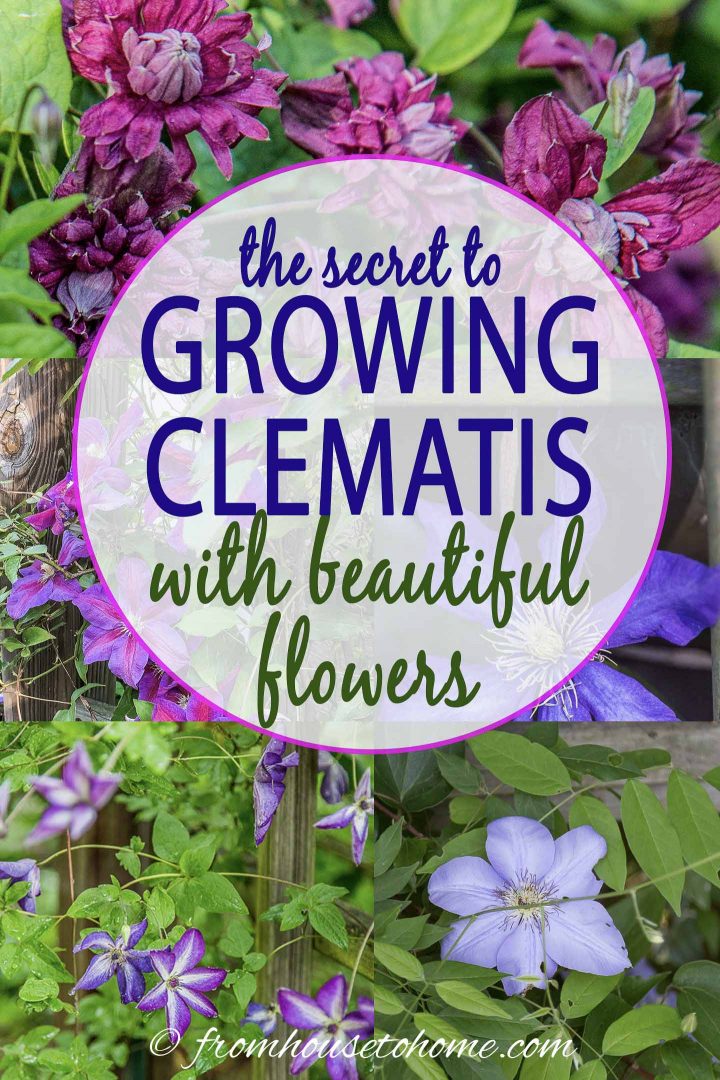

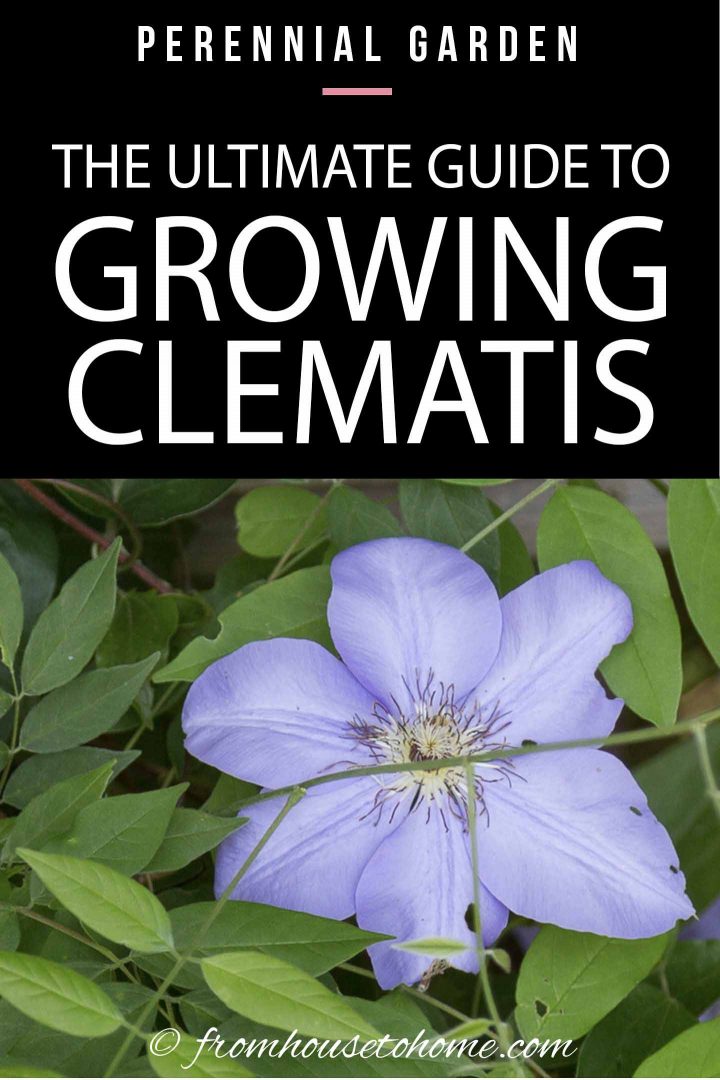
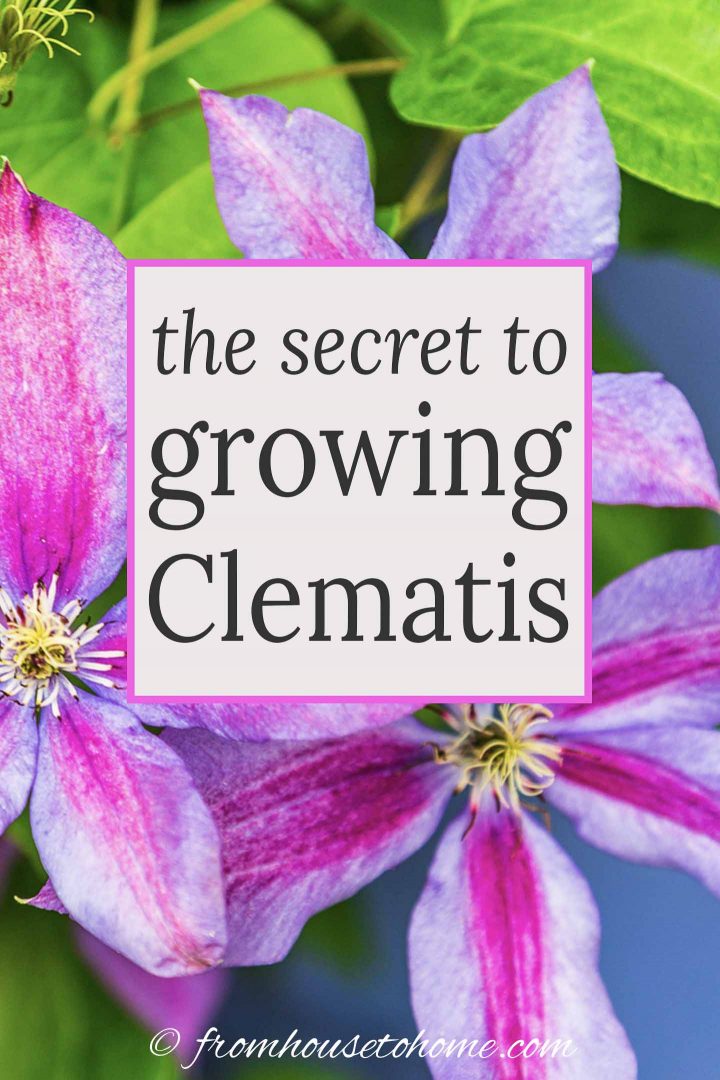
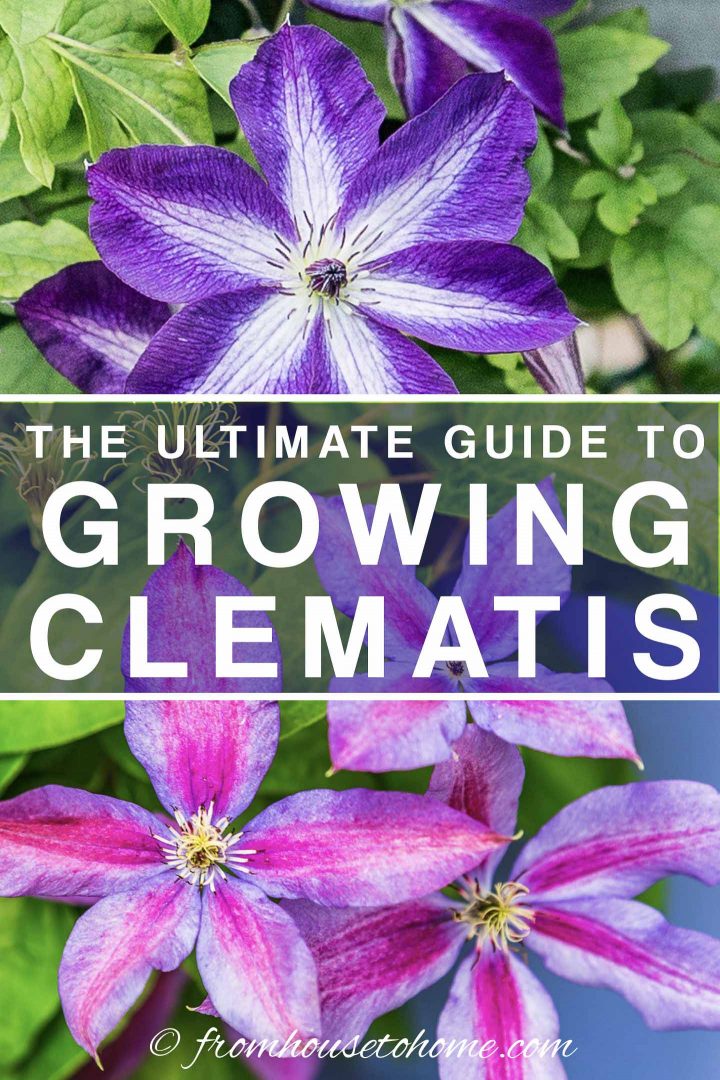
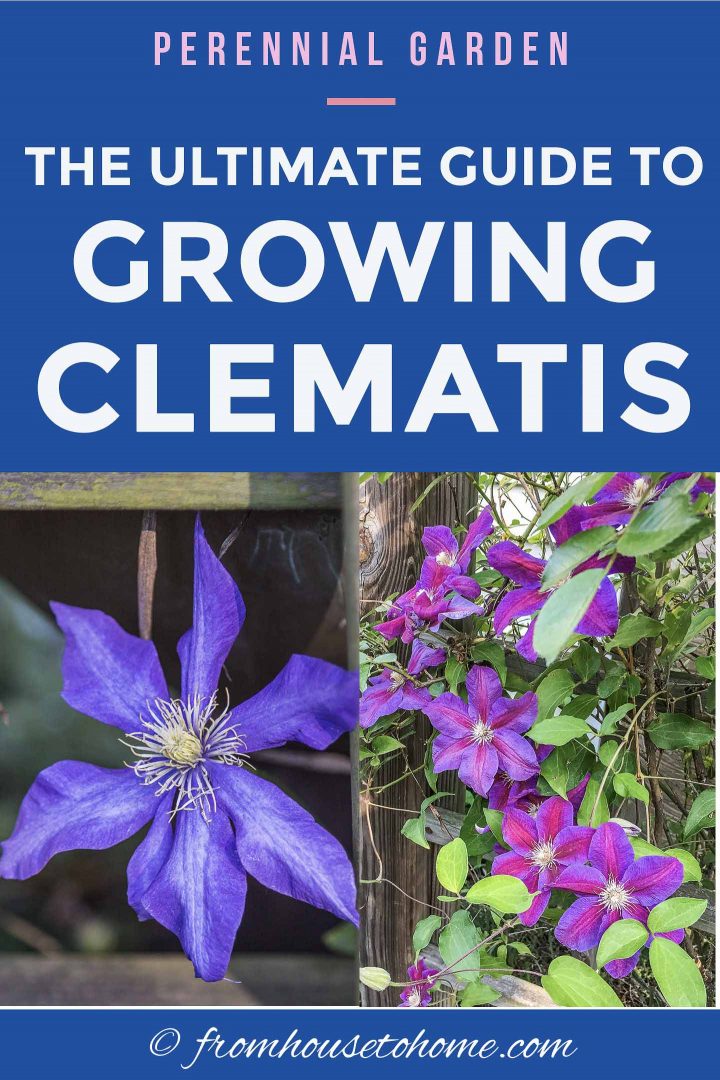
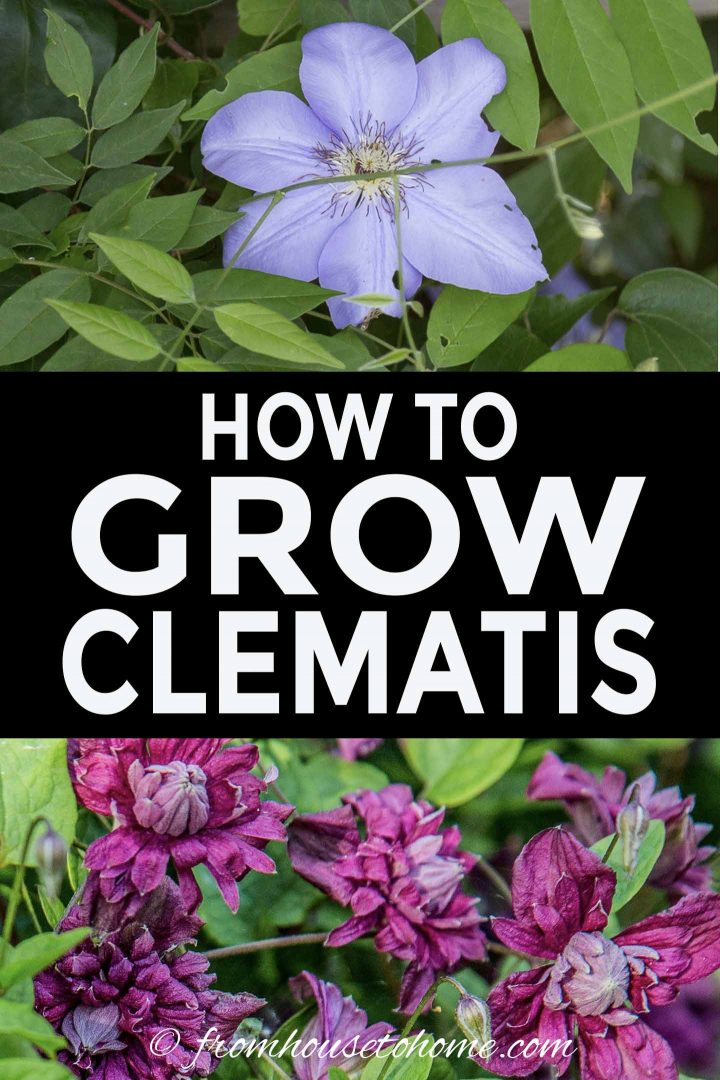
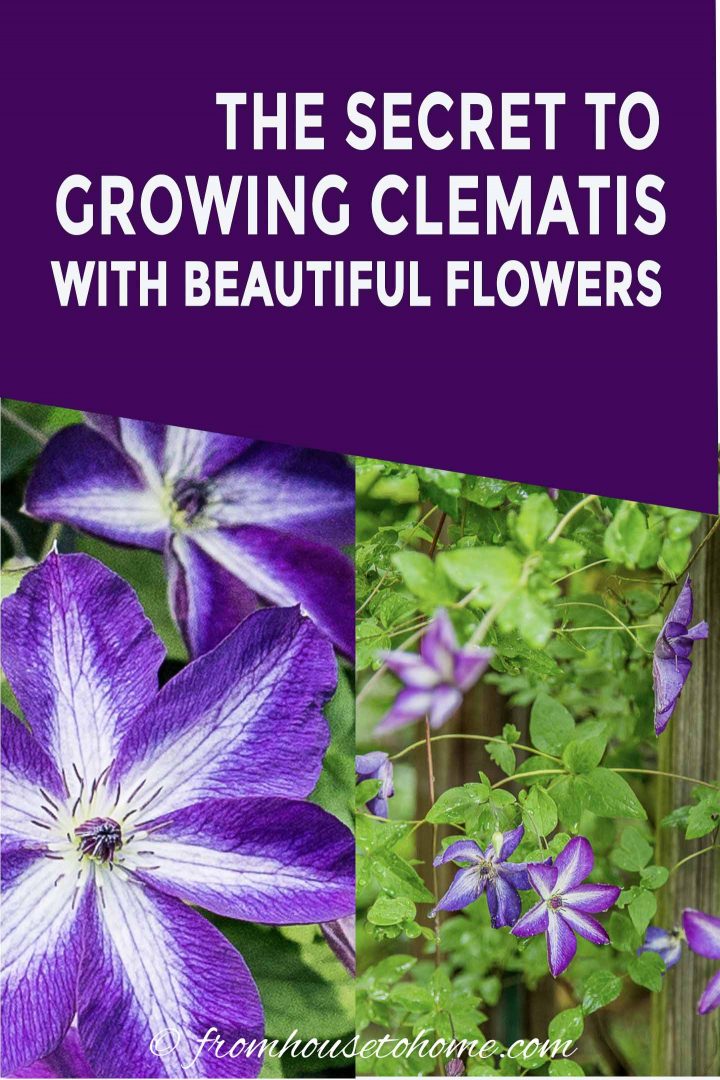

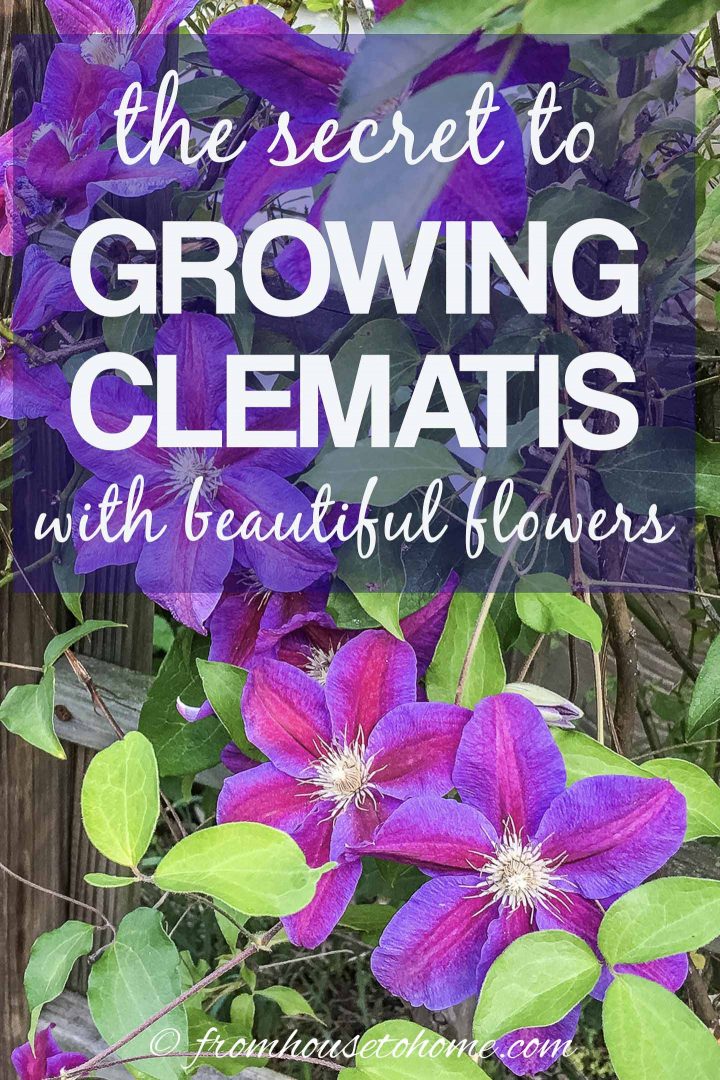
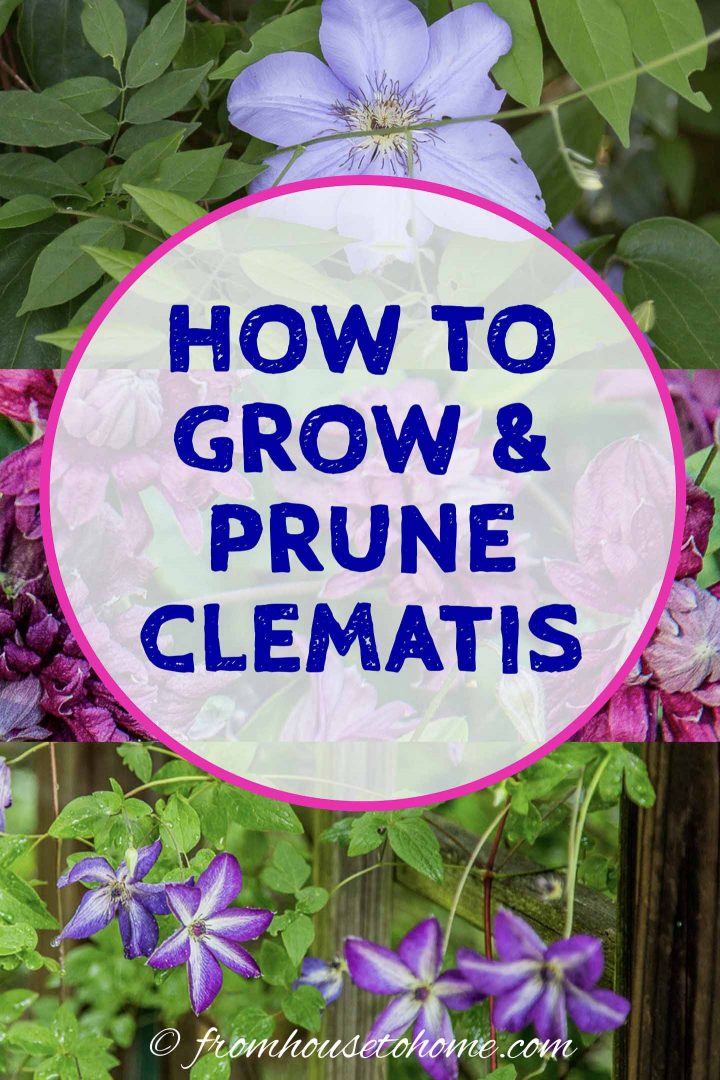

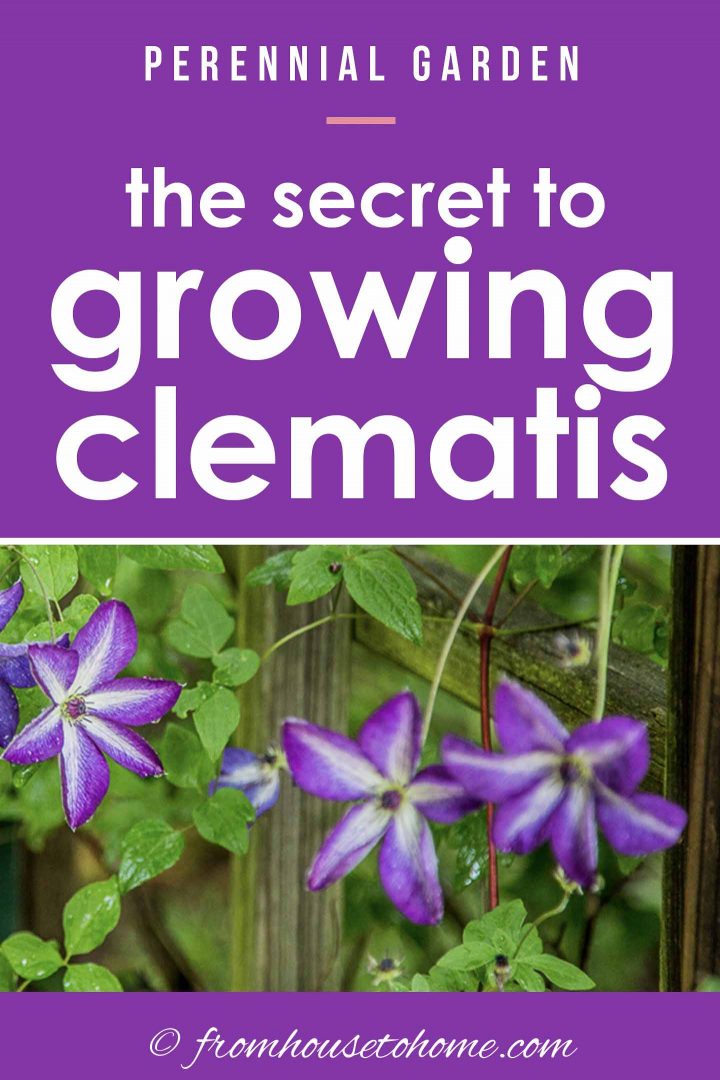
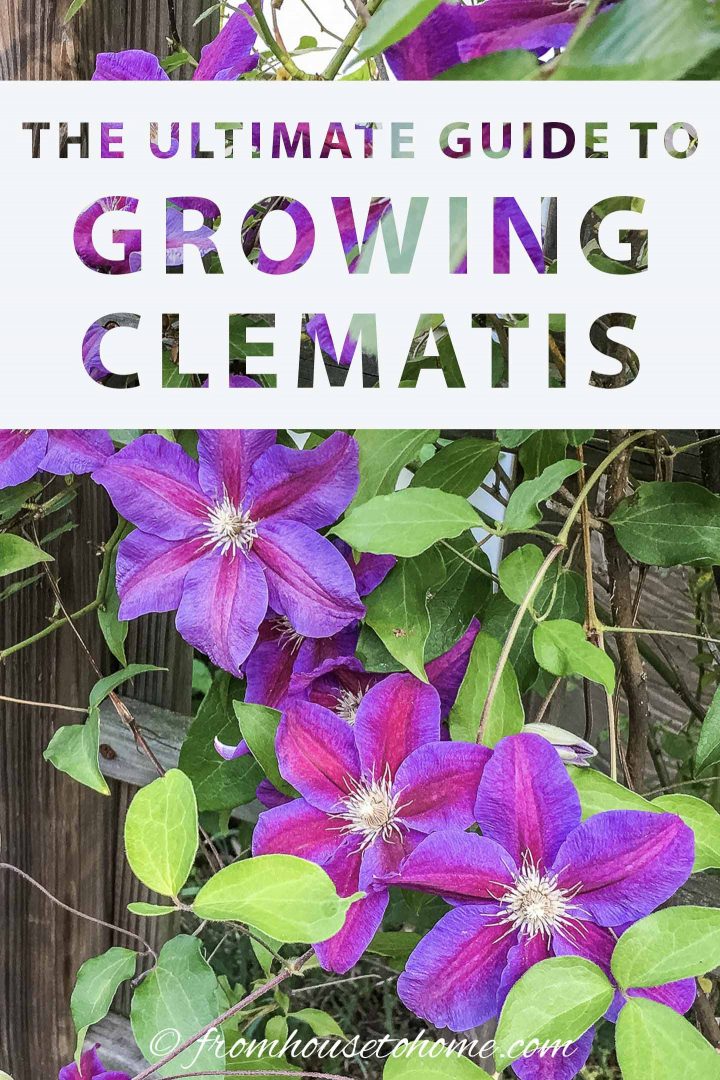

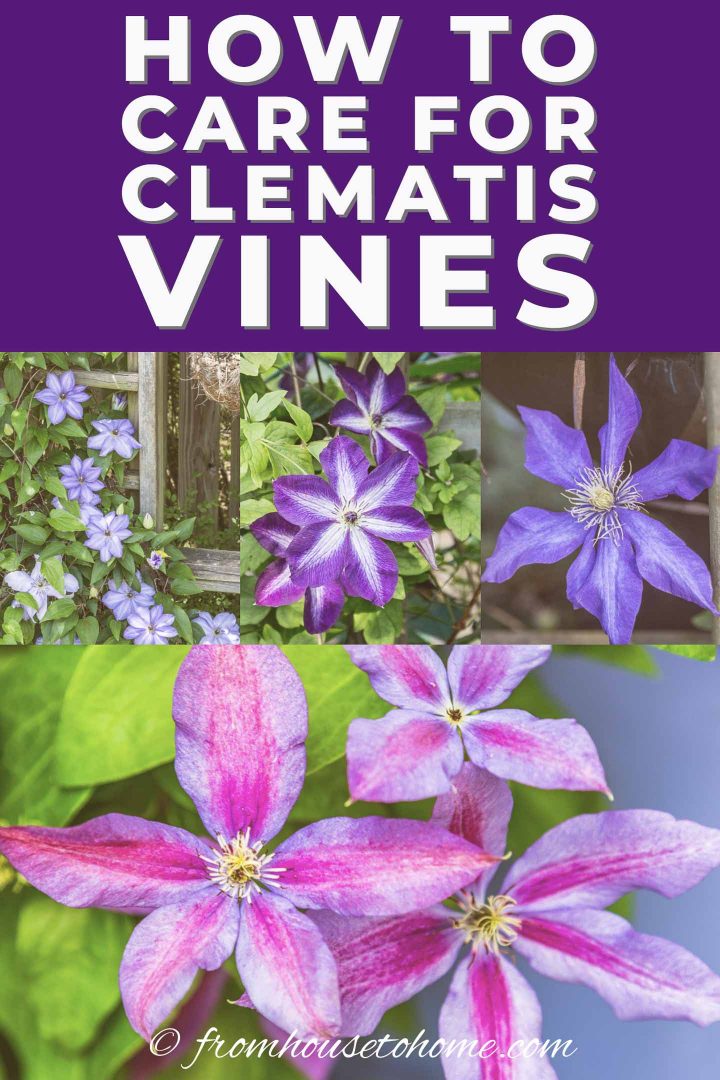
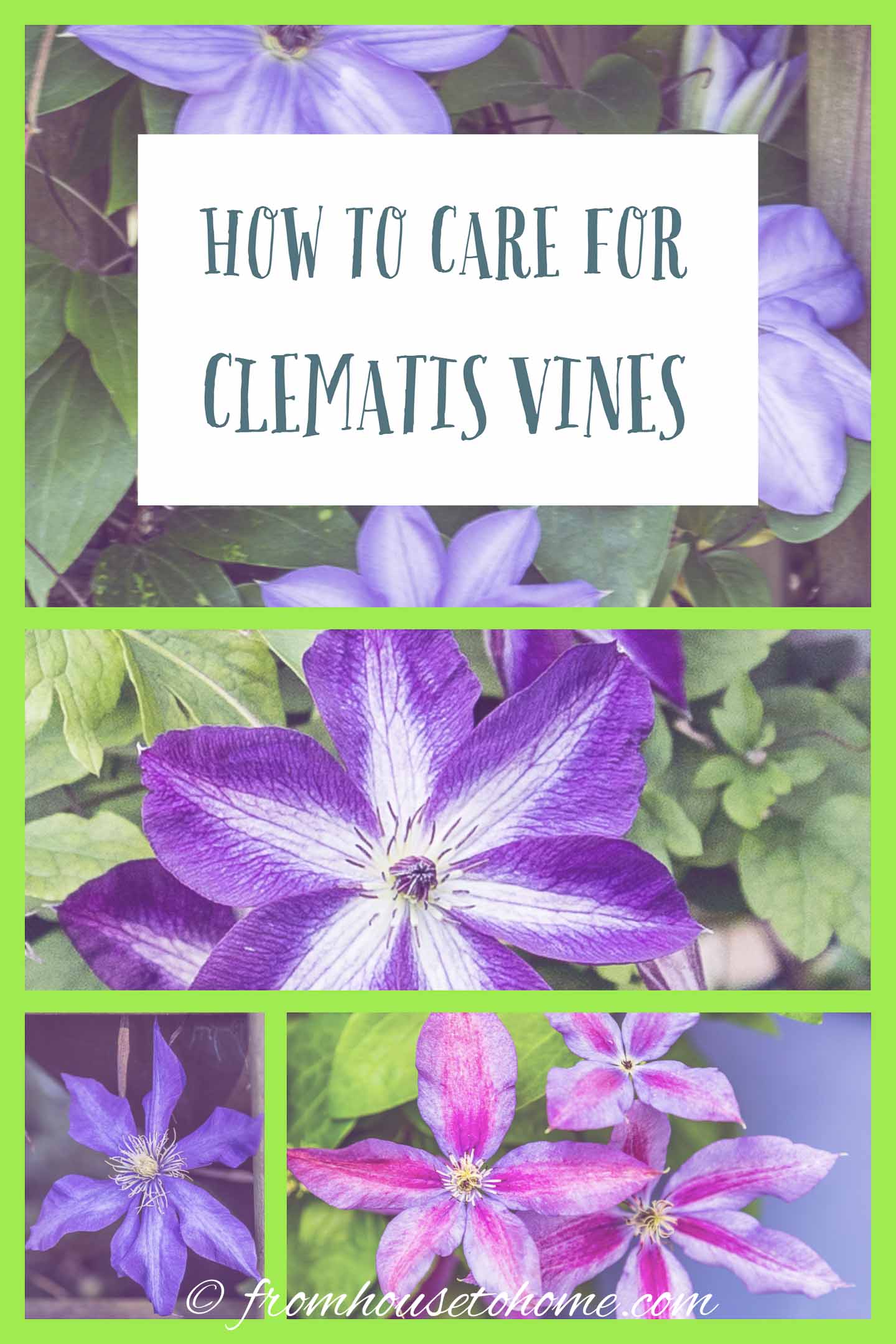




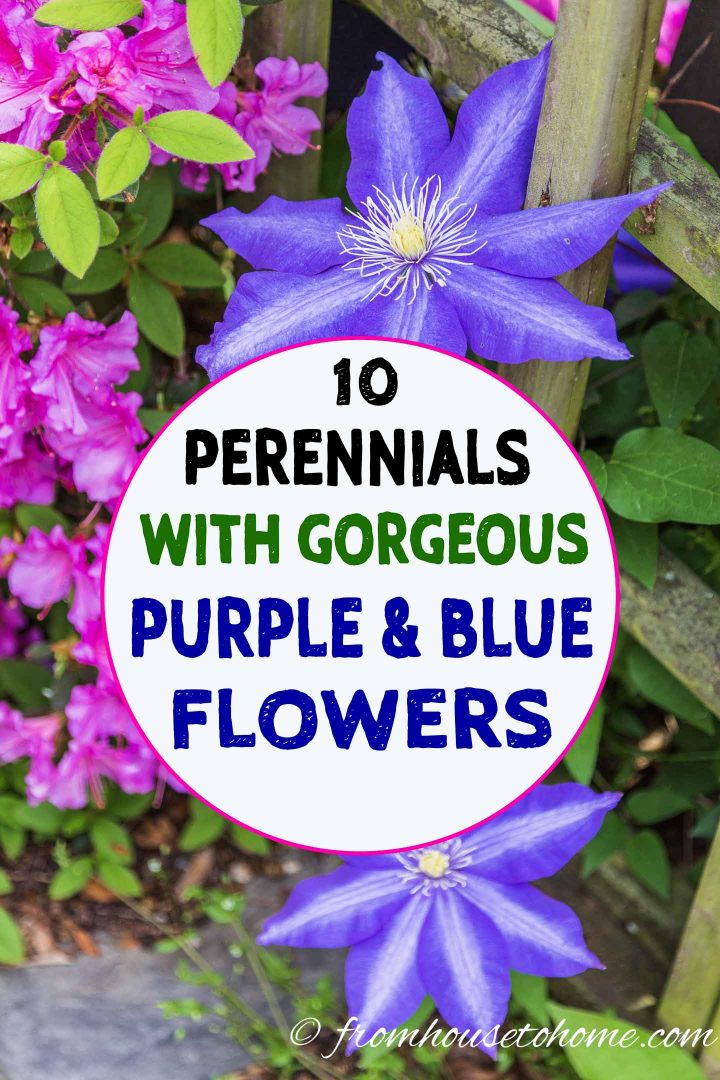
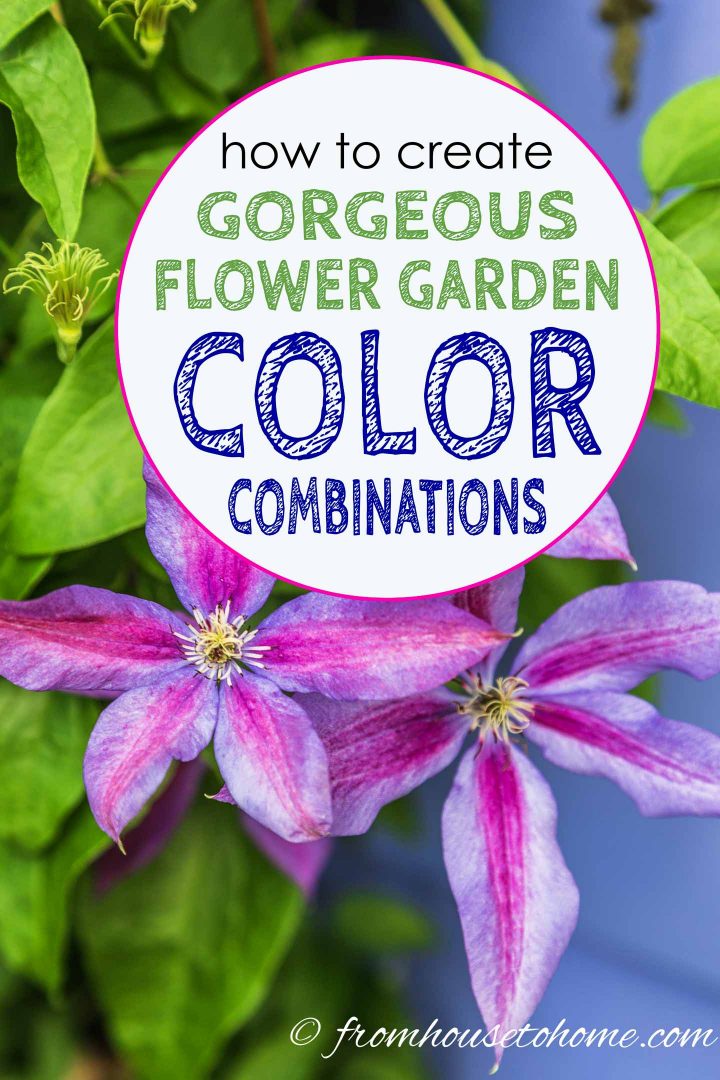



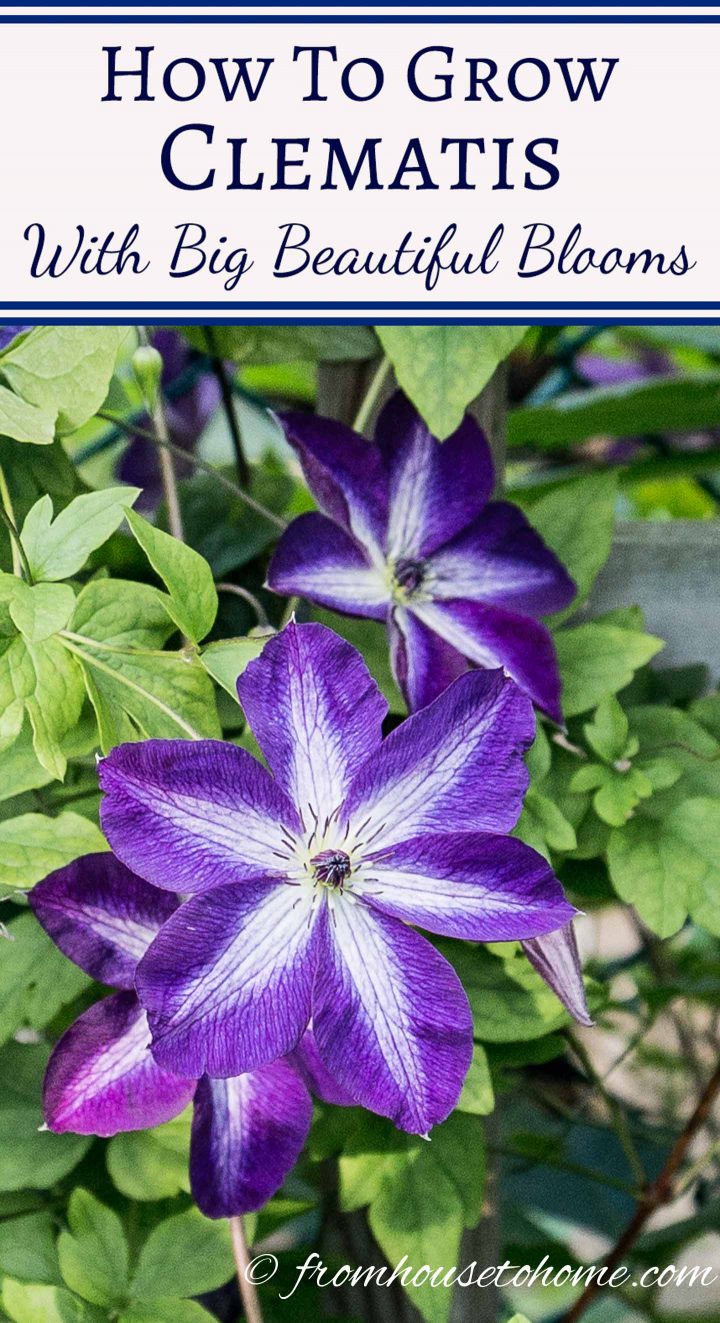
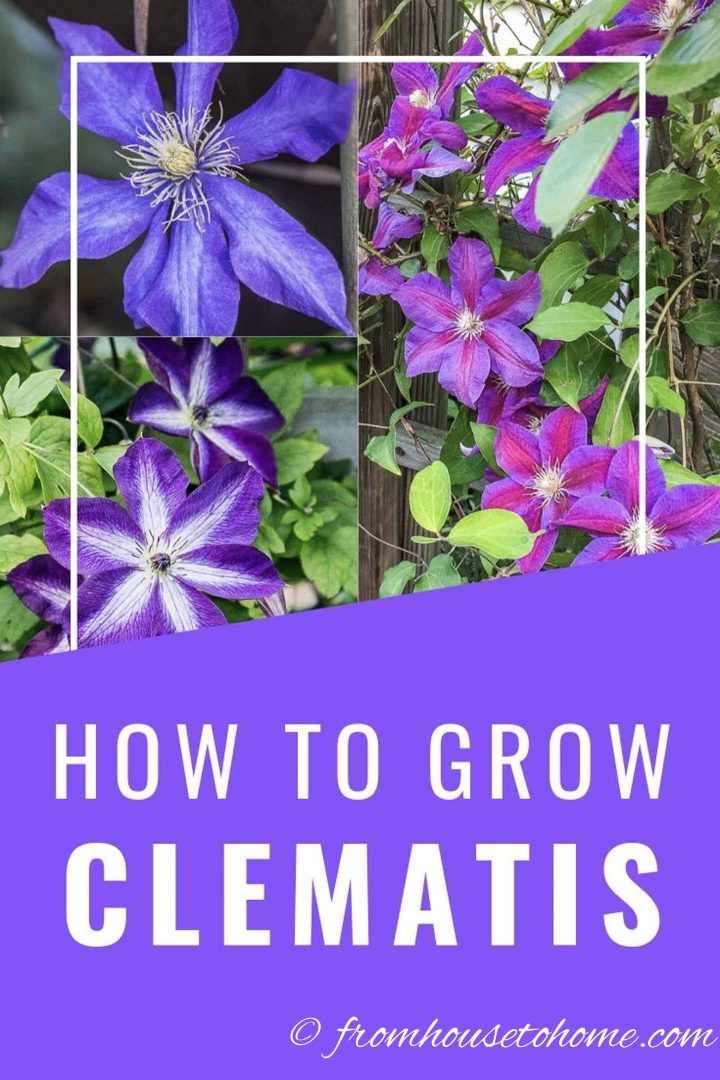

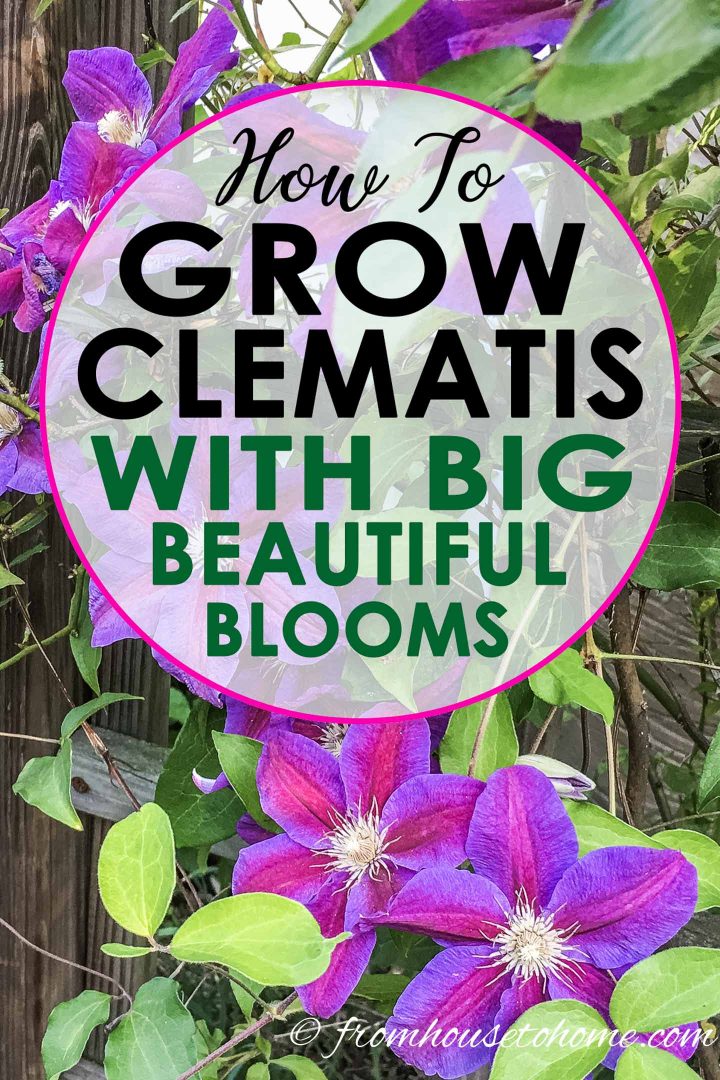
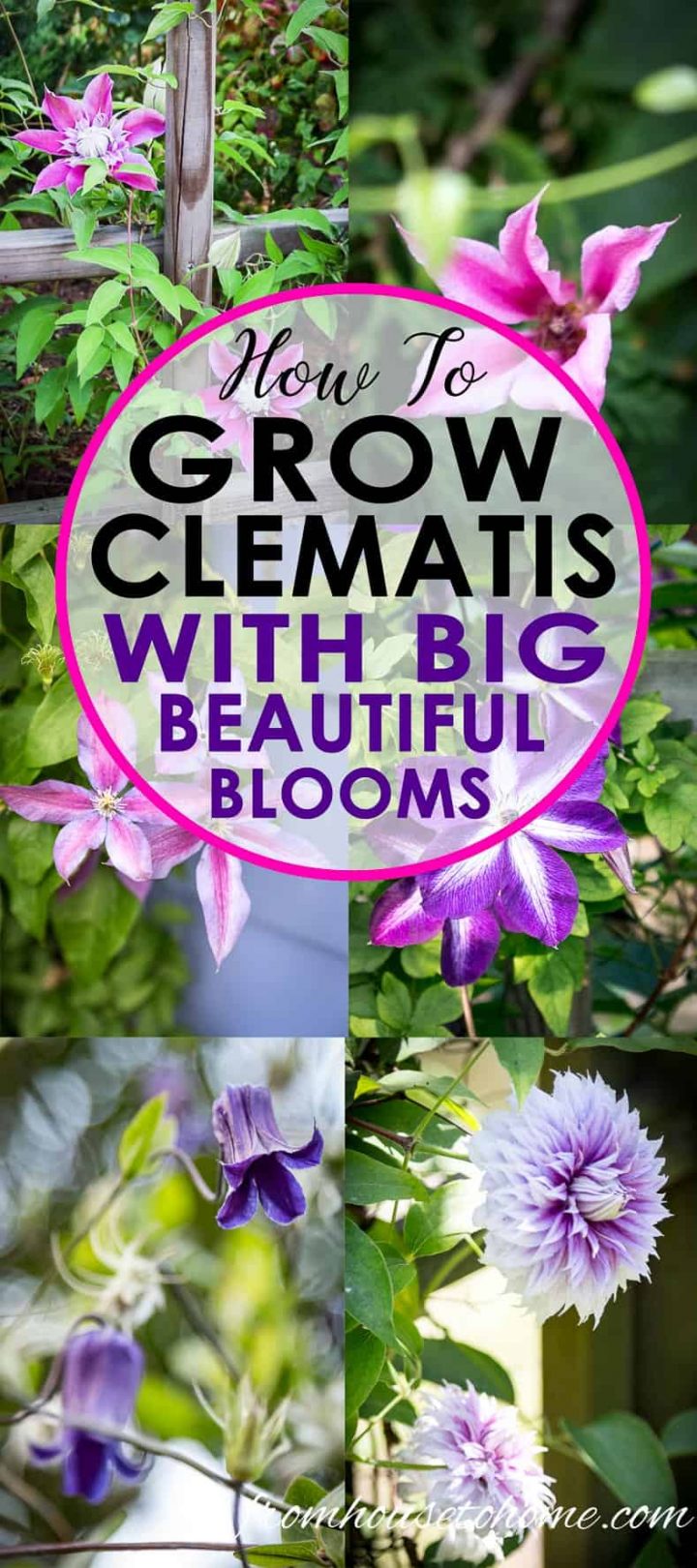
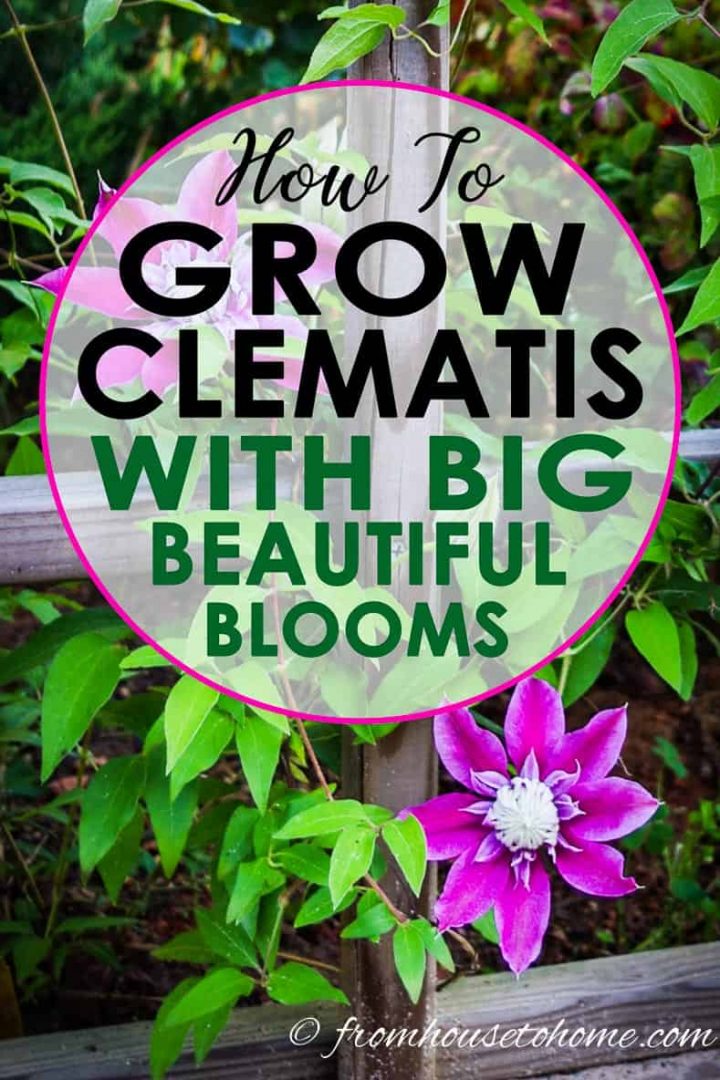
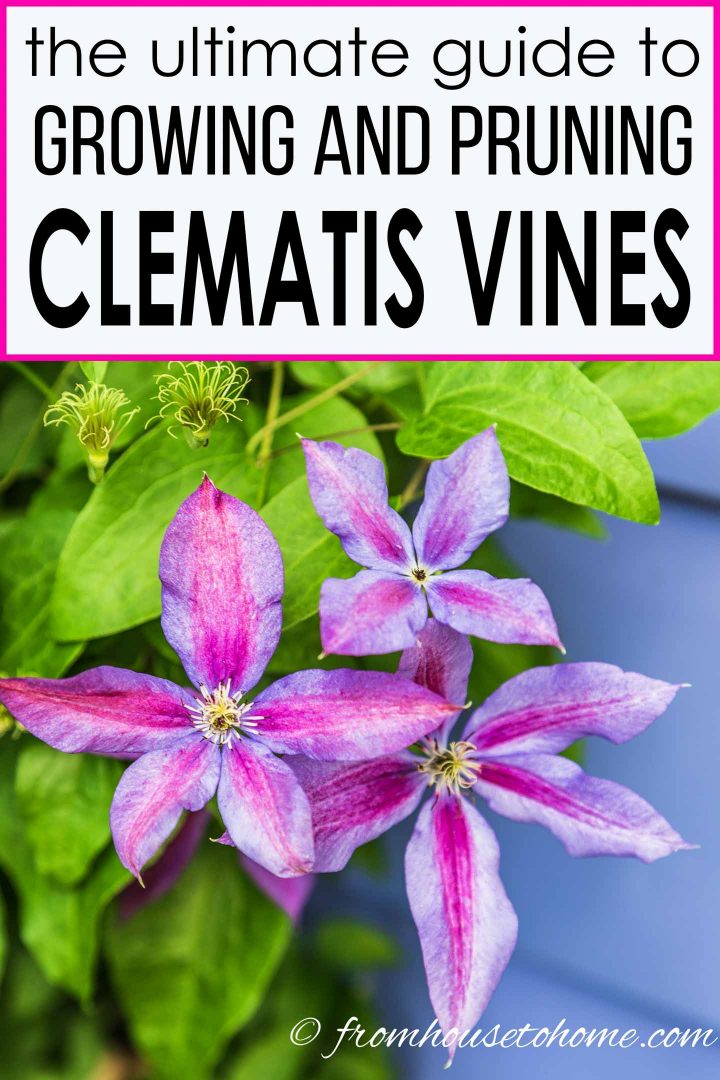

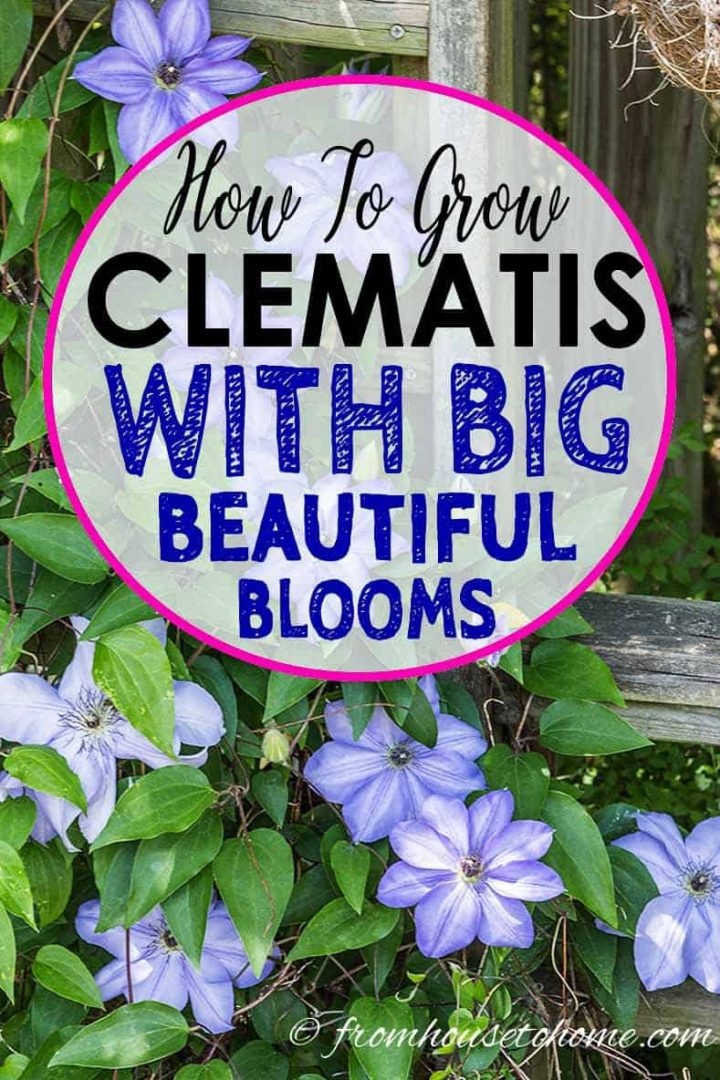

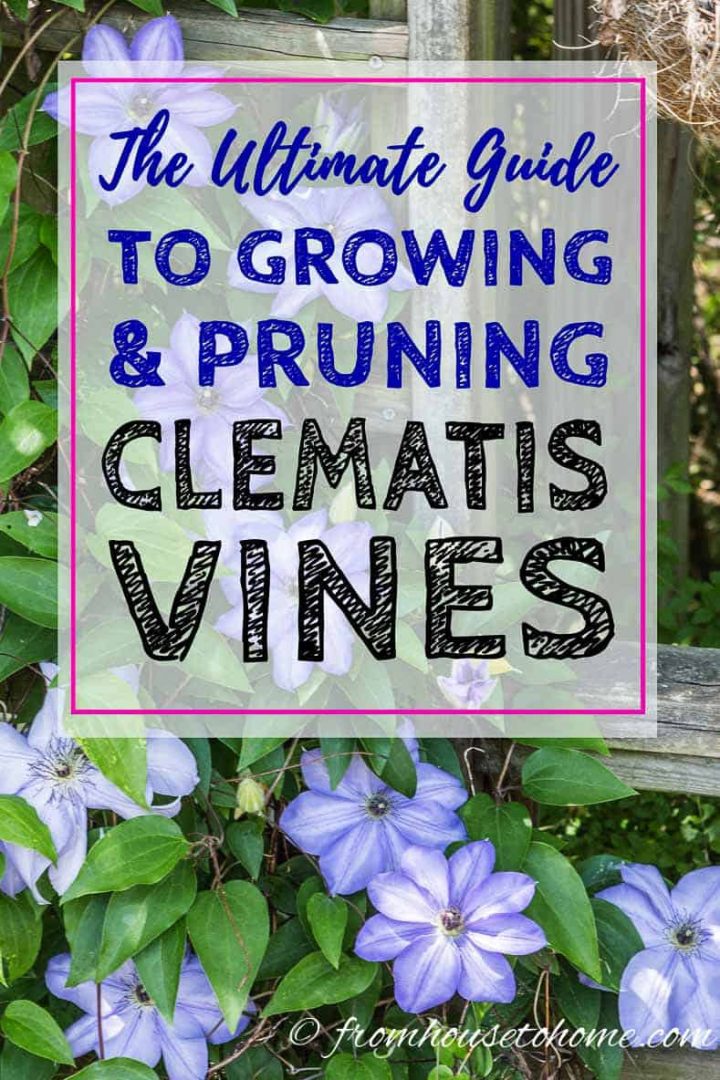
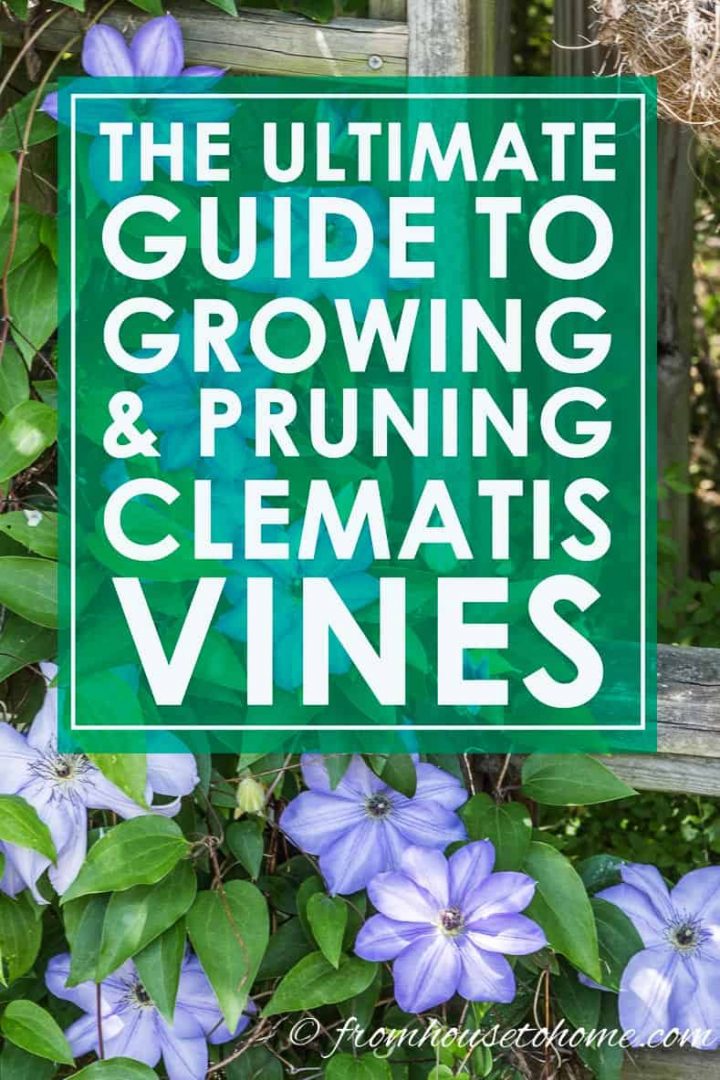




















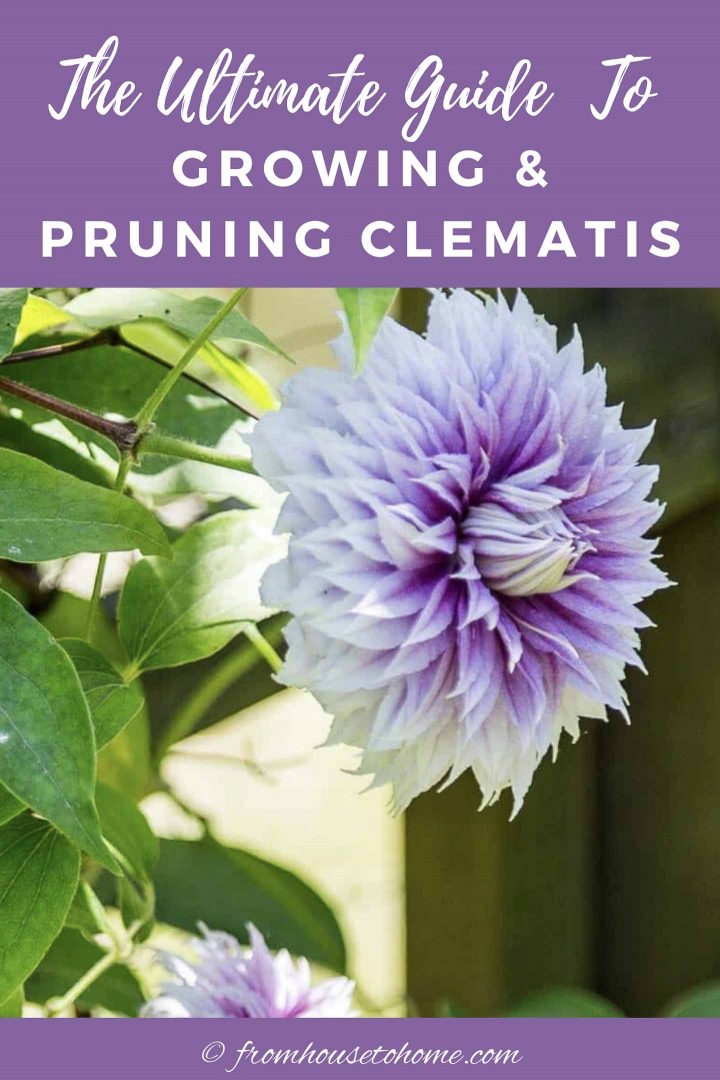
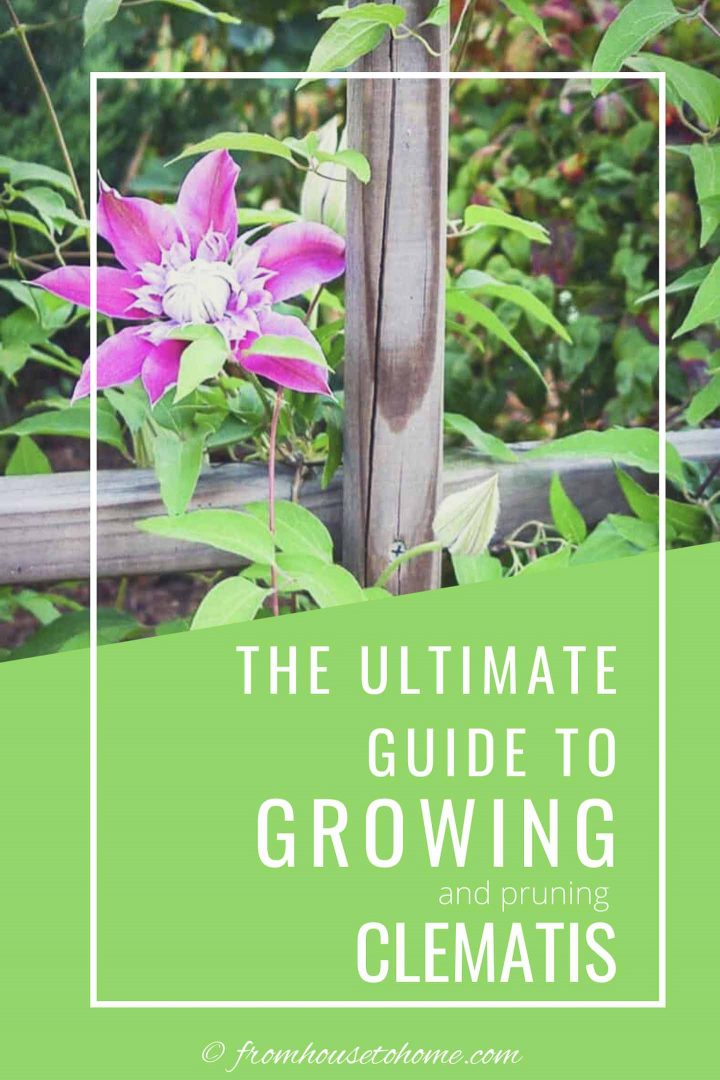
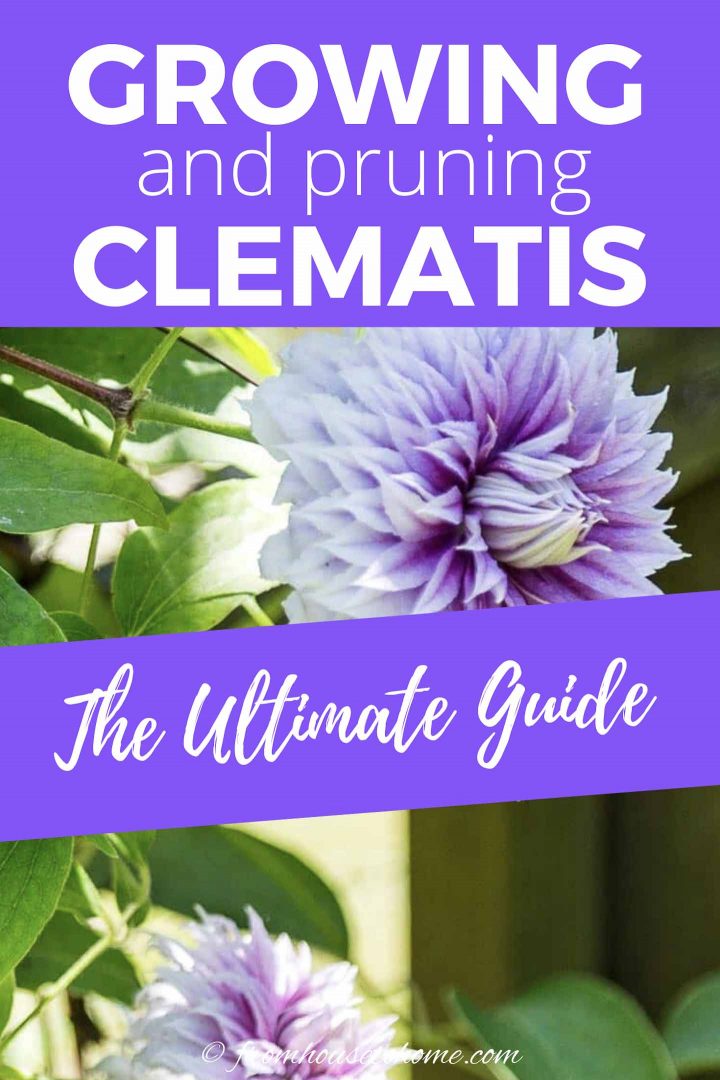
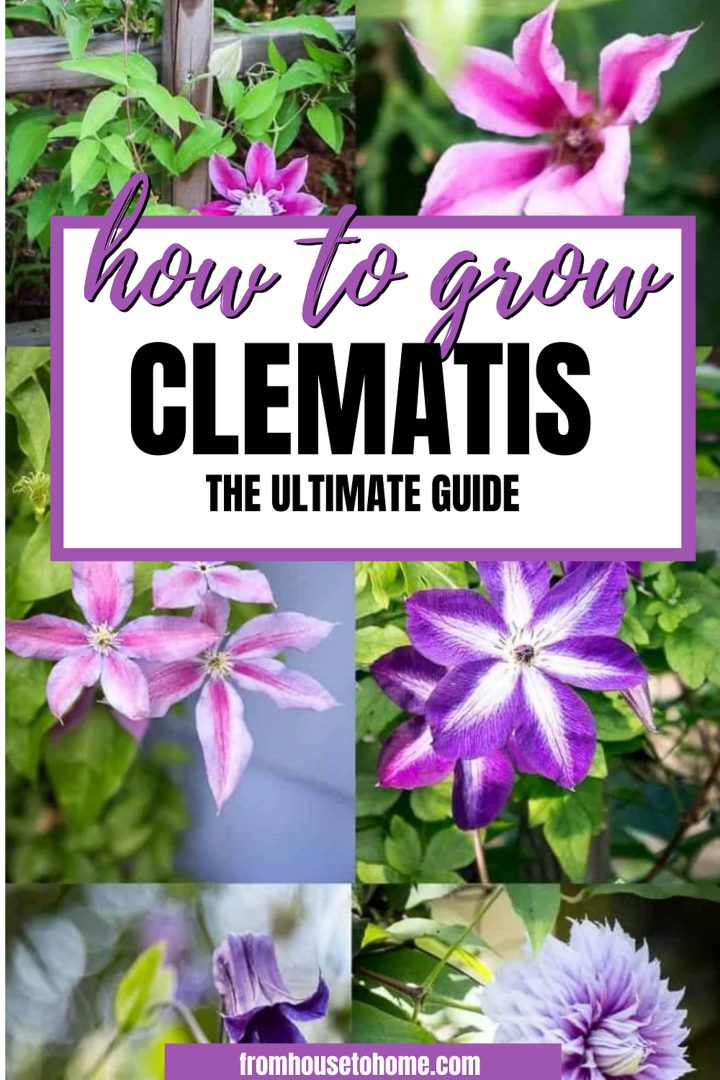
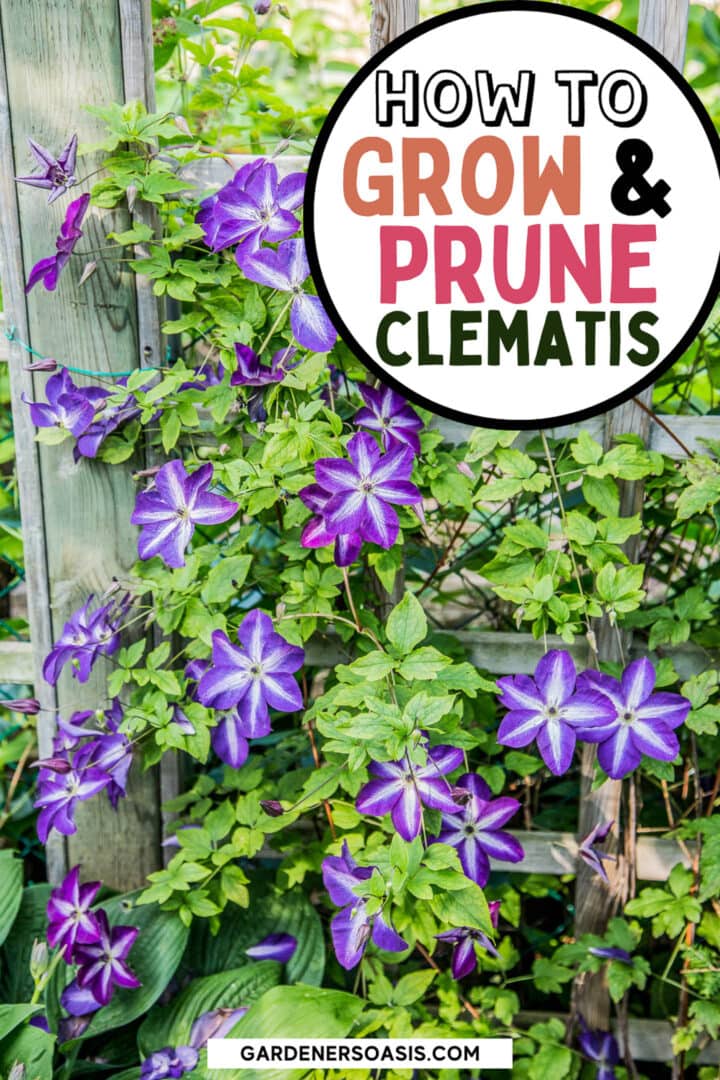
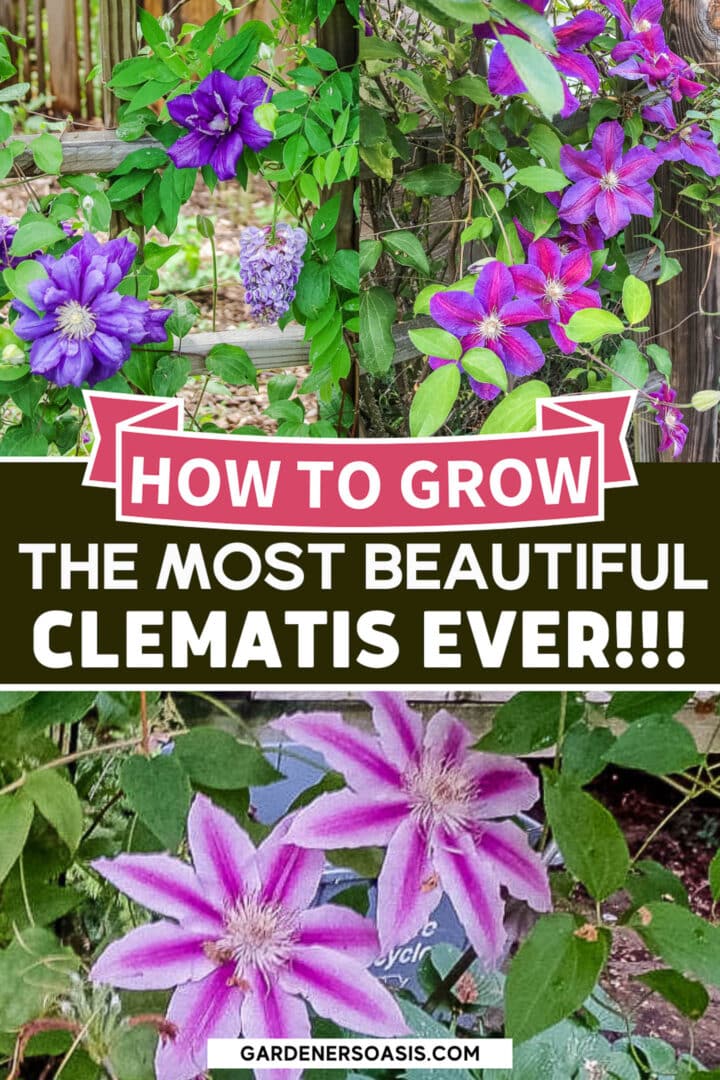
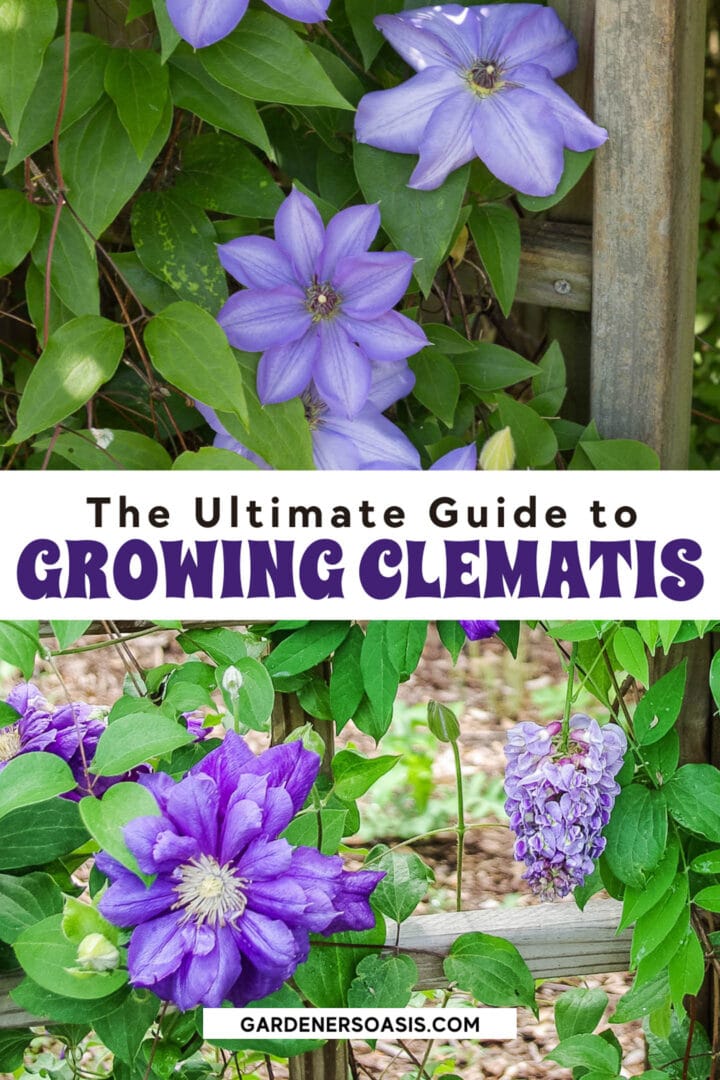
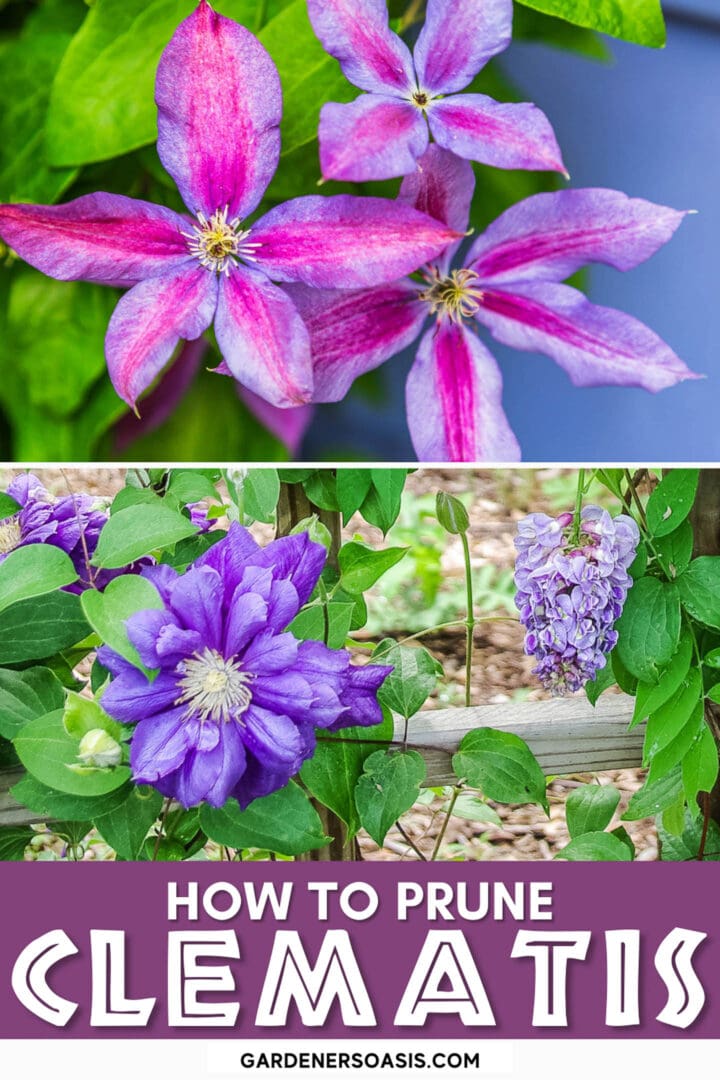
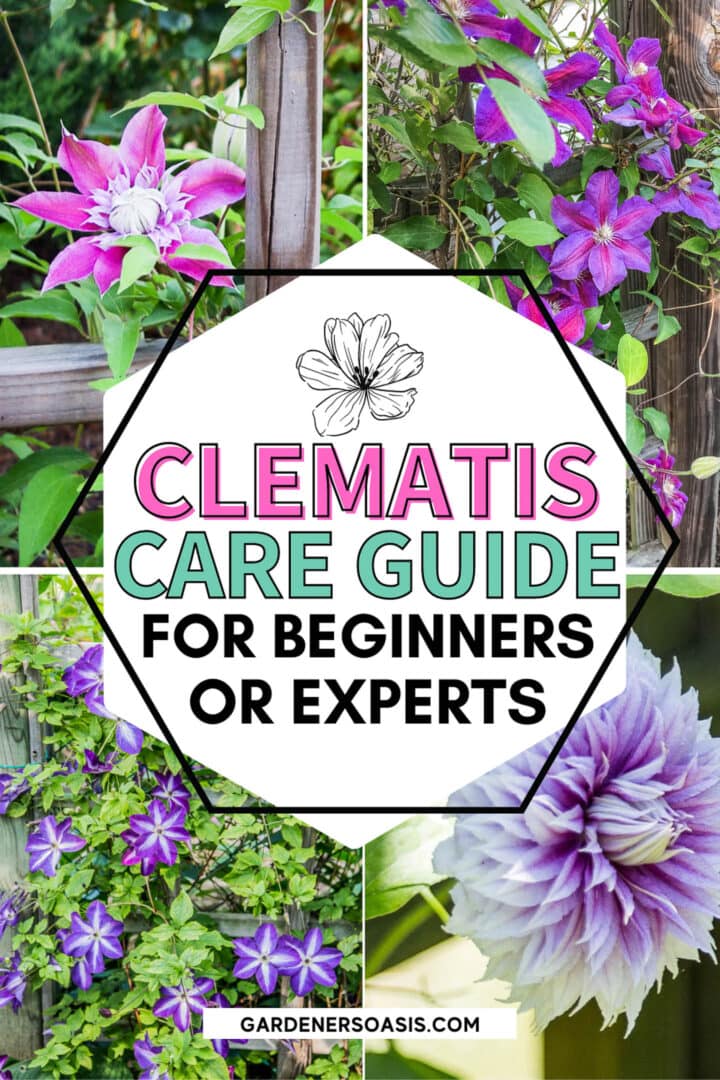
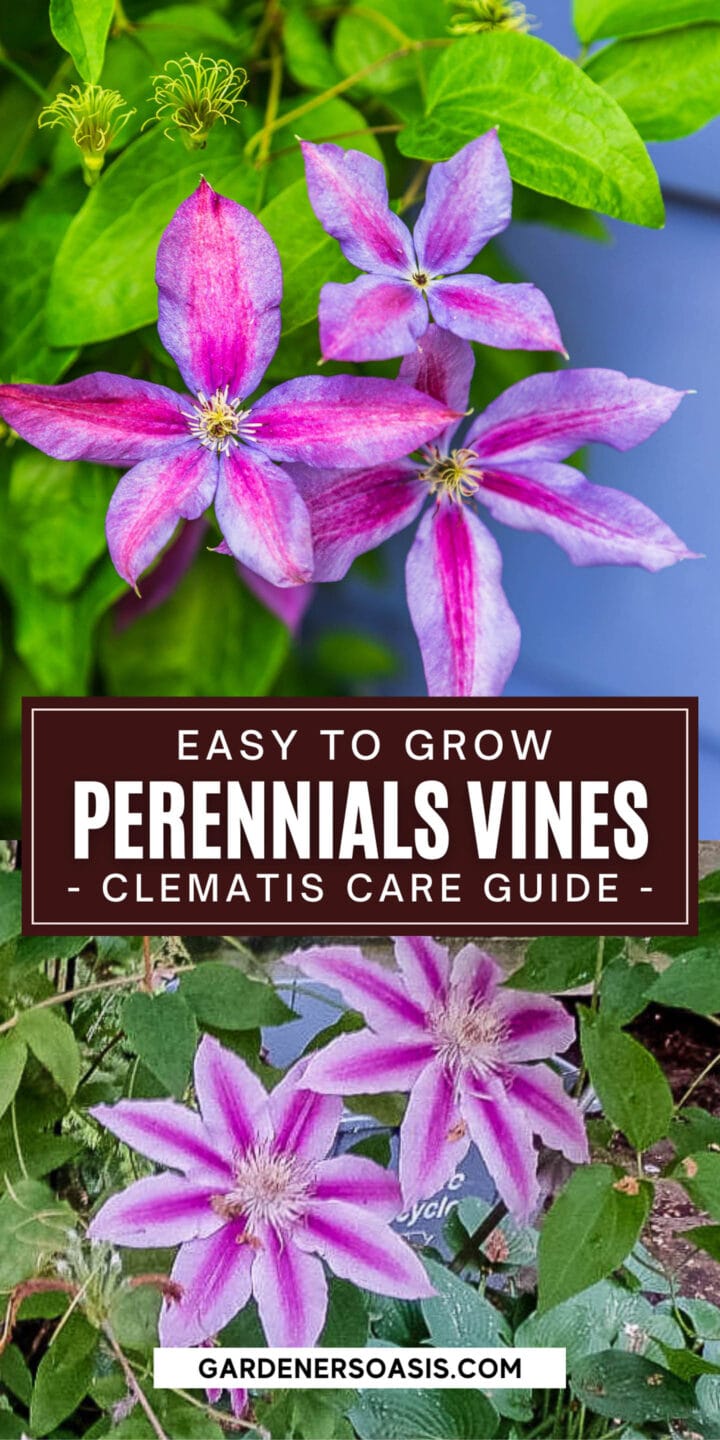
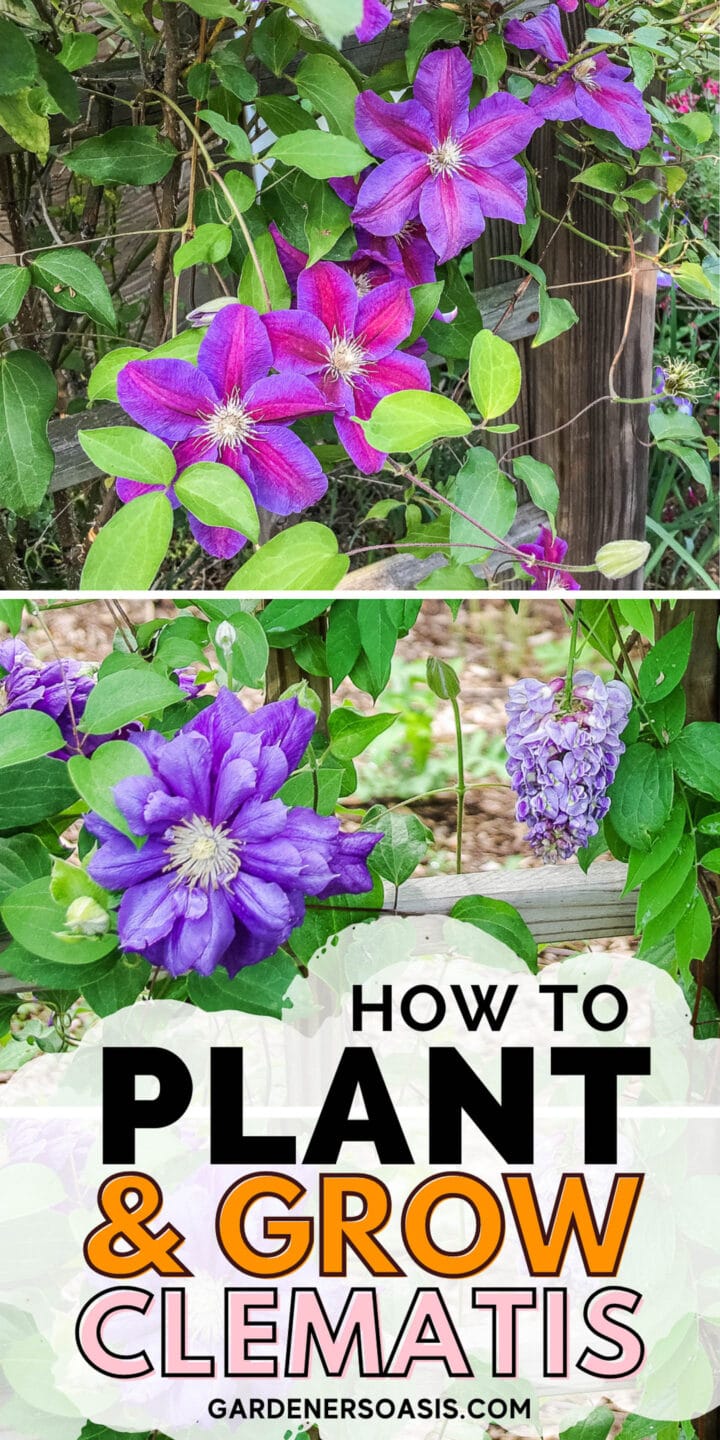
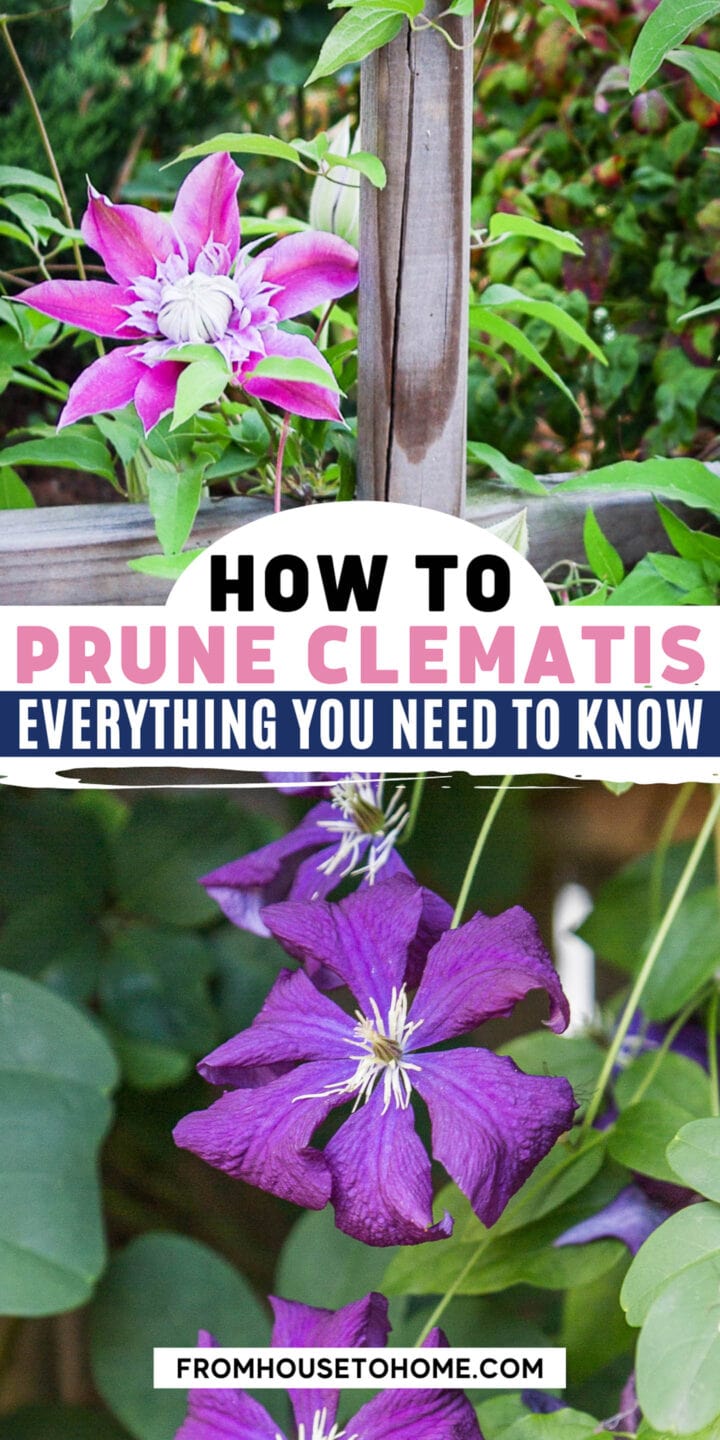
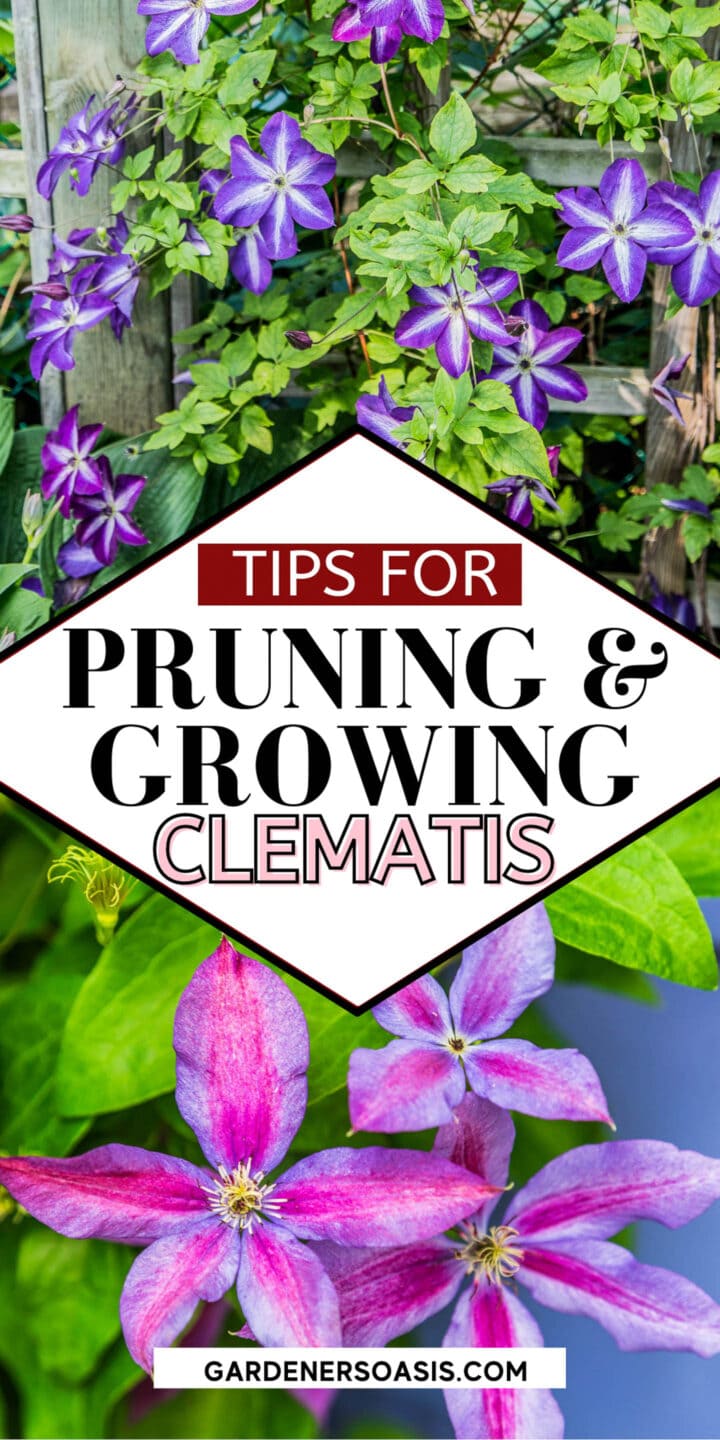
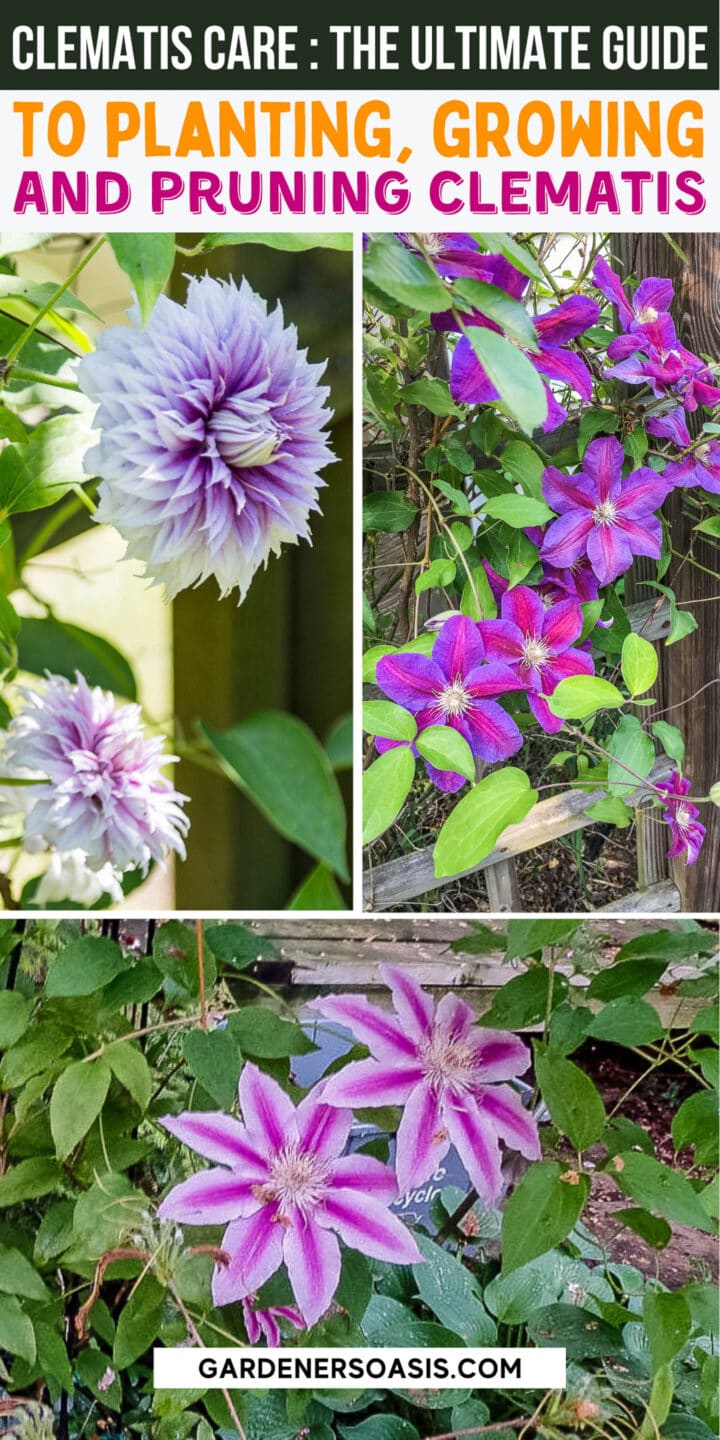



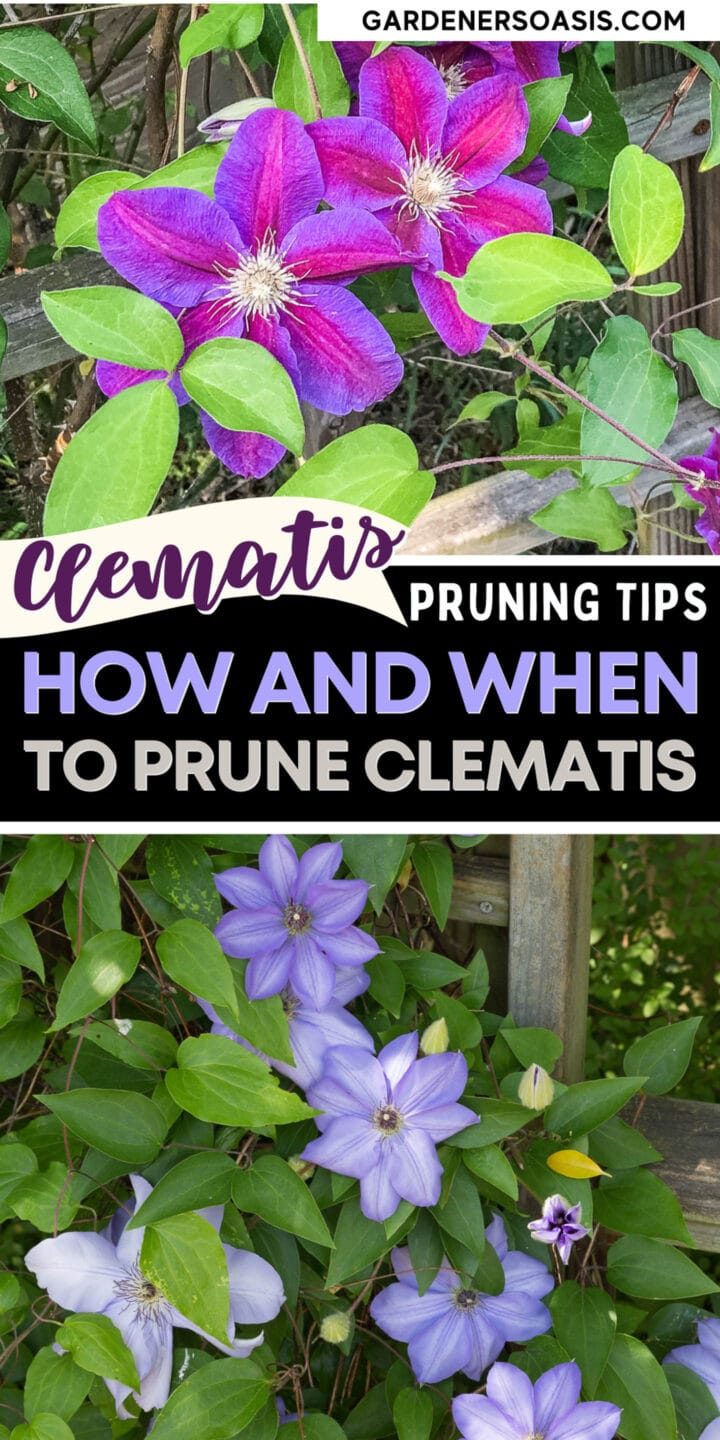

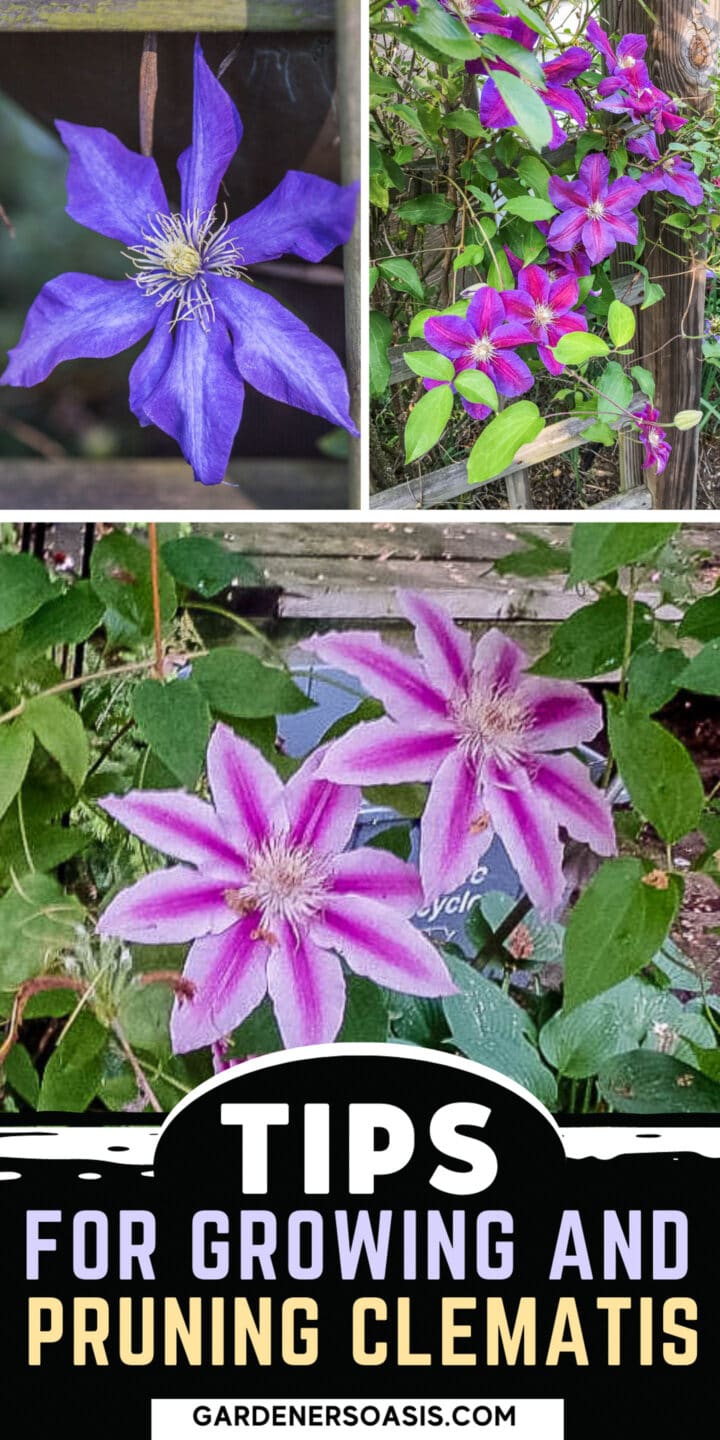

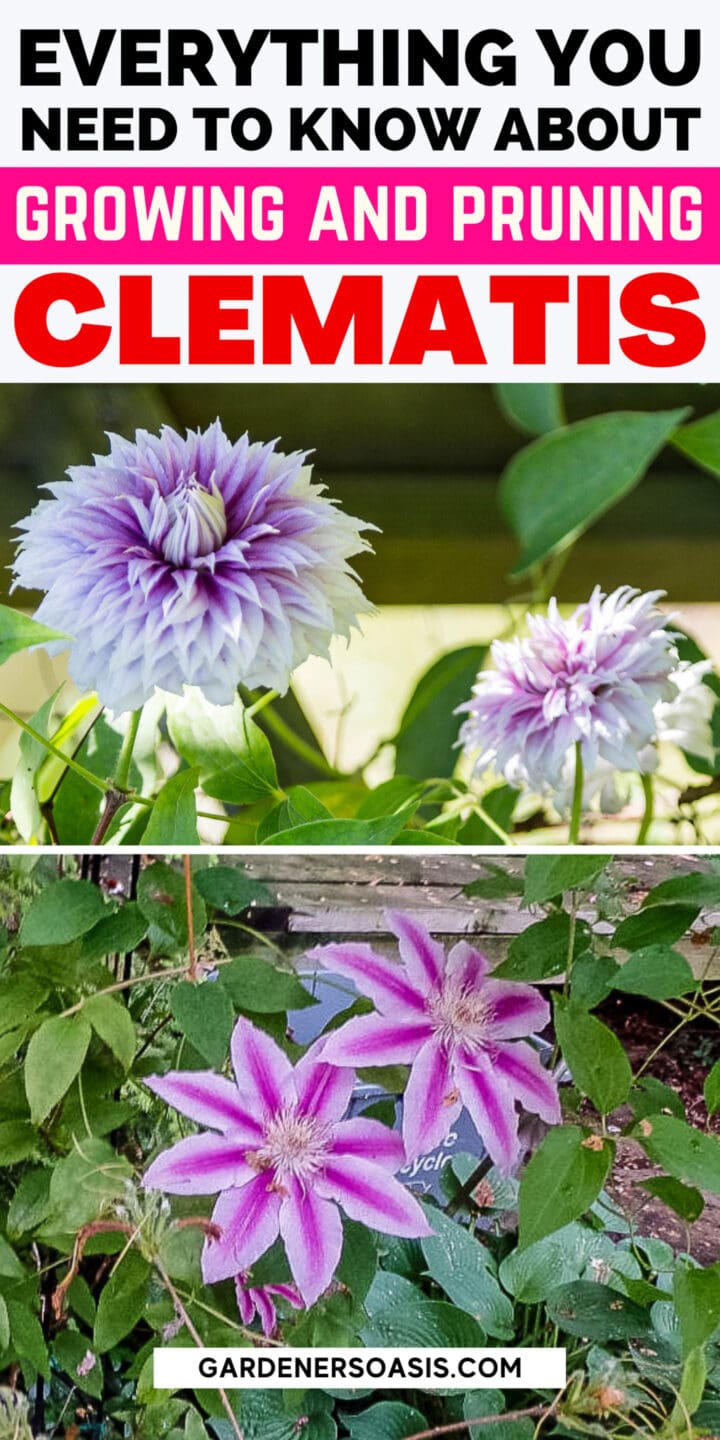
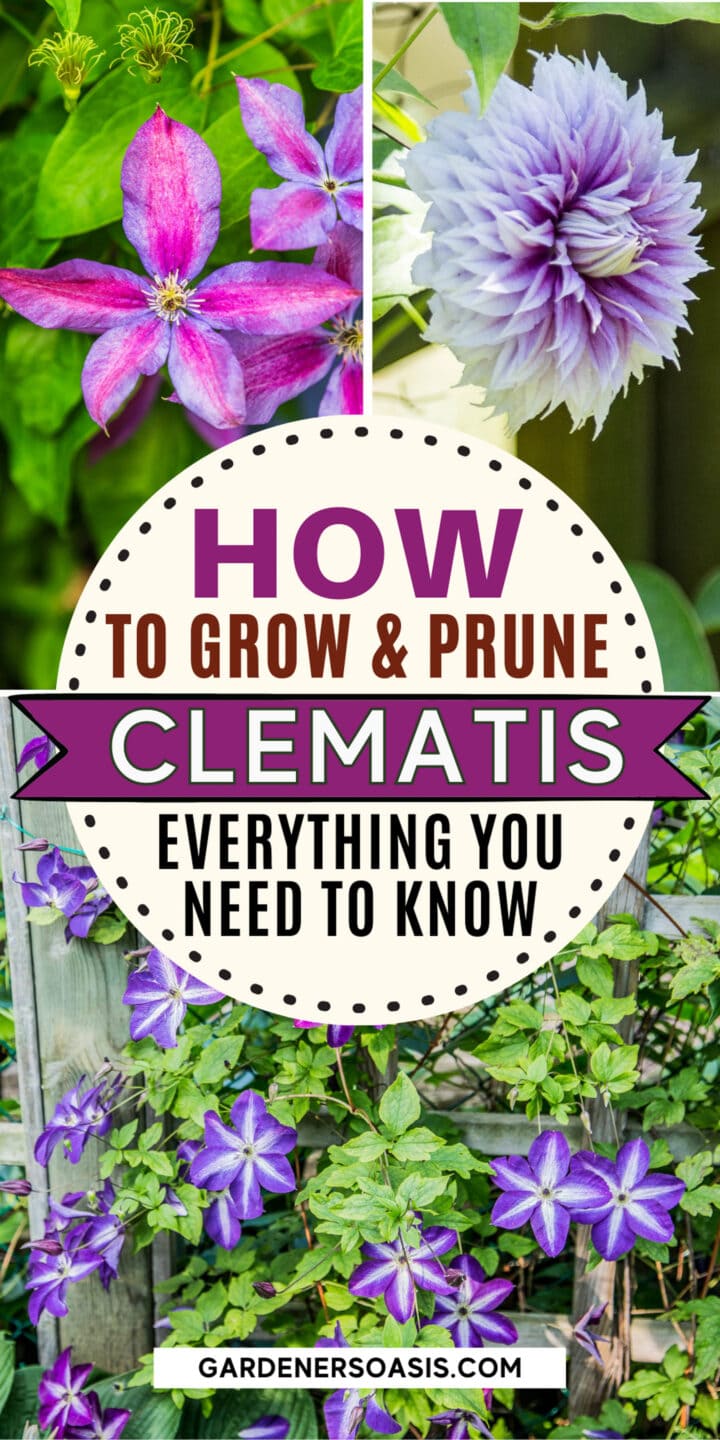

What is the length of time for the blooms?
Hi Sharon…the bloom time varies quite a bit depending on the variety, but most of them bloom for 3 to 4 weeks. I also find a lot of them last longer when it’s not too hot, so some of it will depend on where you live.
Where can I order the Bell of woking clematis. I got one and now know one has them, I just love the flowers.
Hi Sherry…I got mine from Wayside Gardens but you’re right, it doesn’t look like they are carrying them this year. I found a couple online at brushwoodnursery.com and Walmart (of all places!)…so hopefully that helps!
Joy Creek Nursery has Belle of Woking and just about any other clematis! Their website is joycreek.com and they sell mail order. If you’re ever in Oregon, their display gardens are definitely worth a visit!
Thanks for letting us know, Joy! I’m going to check out their website 🙂
I also live in South Carolina, Summerville to be exact, the clematis I have is group 2, I think, it blooms on old wood but very sparse, and then I get new branches coming up too, I’m so confused, a neighbor down the street told me not to prune at all, I have mulch around the roots to keep it cool, and the top is in some light morning sun and late evening sun but it looks so pathetic, I’m from Alaska where we can’t grow them at all because of the short summers, it has new sprouts popping out just about year round, and then we get cold again and they die off, but as soon as we have unusual warm Temps they sprout leaves but no flowers, help please if you can I’m confused.
Hi Brenda…In my area (Greenville), I find Clematis blooms really well in the spring and the fall (and often the same plant will bloom twice). But most of them look really pathetic in the summer…I think it’s just too hot. Since yours is blooming on old wood, youor neighbor’s suggestion of not pruning it could also help (to be honest, I rarely prune any of my Clematis unless they are growing somewhere I don’t want them). You can also try sprinkling compost, organic rose fertilizer, bone meal or alfalfa pellets (ie. rabbit or deer food) around the bottom of it. General fertilizers (like Miracle Gro or Osmocote) have too much Nitrogen, which produces a lot of leaves but not flowers so I wouldn’t use those. Clematis are so beautiful when they are blooming…I hope this works!
Hi I have a beautiful clematis which I bought already flowered but the flower leaves are falling off what can I do thankyou.
Hi Julie…I suspect it’s either too hot, too dry or needs some Clematis fertilizer.
Clematis like to have cool roots, so if you think it is too hot, you can try spreading some mulch around the bottom of the plant or planting a low growing perennial in front of it to keep the sun off. The mulch will also help to keep the soil from drying out too fast.
Having said that, I live in an area where the summers are really hot and humid…most of my Clematis look like they are having a hard time in the summer, but they always bounce back once it starts to cool down in the fall.
Those big, beautiful Clematis blooms do require a lot of nutrients from the soil. You can try using a Clematis fertilizer (should not be too high in Nitrogen). Or if you want to go the organic route, sprinkle alfalfa pellets around the base of the plant and water them until they turn mushy.
If you are still having problems, you can also cut it back, pretty close to the ground and let it re-grow.
Hope this helps!
Maybe try grass clippings around the bases of the plants. I have two of my plants in a garden bed around an old stump. One is in direct sun, the other in part sun, and they both seem to do equally well. I actually have never pruned my plants, unless cutting off a newly rooted vine. Love your pictures and advice!
Thanks, Michelle! I have to admit, I don’t usually get around to pruning mine either and they seem to do fine 🙂 But I think I do get more blooms when I actually do prune them properly.
I would like to know if you can take a cutting from a vine, put in water to start roots, then plant it?
Hi Deb…I have not tried growing Clematis from a cutting, but I found this article that says you can, and has the instructions on how to do it. Good luck with it!
Thank you Wanda. I will be giving this a try. Can’t wait!
How should I prepare my clematis plants for winter?
Hi Carla…I actually don’t do anything with mine 🙂 But if you want to make them look neater, you can cut off the old flower heads. (Depending on the variety, you may need to be careful not to cut off too much or you’ll lose next year’s blooms). Then if you live in a colder climate, you might want to add some mulch over the roots for extra protection. Hope that helps!
I’m Assuming deer eat this like candy? These are beautiful but I already spend too much on deer repellant. (Central Texas)
Hi Karen…according to the Rutgers University Deer Resistance list, Clematis falls into the “Occasionally Severely Damaged” category. So not the absolute worst (which would be the Frequently Severely Damaged category), but not great either. So I think you’re right…if you have a deer problem, there are probably better options…
I’m in Essex UK not to far from London, I find I’m not getting large blooms & some clematis disappeared completely :o(
Hi Jacqueline…I’m sorry to hear you are having problems with your Clematis. Most of the time when I have issues with them, it’s because they are either getting too much or not enough water. But they usually are pretty hard to kill (the ones that have disappeared may surprise you and re-grow later.) If you haven’t tried fertilizing them, that could be another option that would help the size of the blooms (use a fertilizer that is lower in Nitrogen so you don’t just get more leaves). You can also take a look at the Royal Horticultural Society website…they have some suggestions on other Clematis problems you might have. Good luck with them!
I’m having problems with the leaves turning yellow all of a sudden. Never did before and I’m not doing anything different. Any thoughts on what the problem could be and how to correct it? Thanks for any help you can give me.
Hi Thelma…it’s possible that there is an iron or magnesium deficiency in the soil. You can try sprinkling some iron chelate around the plant for the first issue. For magnesium, mix 1 teaspoon of Epsom salts with a gallon of water, and water the plant with it once a week for about a month. Also, if it has been hotter than usual, it could just be the heat…the plant should recover on its own once it cools down. Hope this helps!
Thanks Wanda for replying. I live in Oregon and we haven’t had real hot weather so far this year. My three plants started turning yellow as soon as they leaves out. As I said, in the past I didn’t have this problem. It just started in the last three to four years. I’ve been told to shade the roots more, which I did to no avail. I’ve made sure they were getting enough water. All the leaves doesn’t turn yellow, just enough to let me know something isn’t quite what it should be. Again thanks for your help. Will try the Epson Salts and the Iron remedy and see if that helps.
Thank you for that exelent and full information. I found out all answers to my questions reading your article. Thank you.
Thanks Iryna…I am happy you found it useful 🙂
I found everything very useful.
I live in Mississauga, Ontario. I am going to try several of your suggestions.
Thank you.
Barbara
I’m happy you found it helpful, Barbara. I am originally from Toronto so have some experience growing Clematis up there, too 🙂 The same principles apply.
I have a clematis but not sure what kind. I did get some blooms the first year and then it looked like it died.So I didn’t think too much of it. The branches are really thin and look dead. I pulled it up last year and behold It came back! So could you give me some advice what I should do now?
Thank You very much. It was my husbands favorite and he is gone now and I would love to keep it growning.
Hi Virginia…I’m sorry to hear about your husband. The fact that your Clematis came back is a good sign 🙂 Mine do die back like that and they really do look dead. Most of the time I just leave them alone and they re-grow…a lot of the time even the dead looking branches will start to put out leaves in the spring. So I think as long as you put some mulch around the bottom of it and make sure that it is well watered, it should be fine. If you want to give the plant an added boost, you can sprinkle some compost or fertilizer around the base of it. Hope this helps!
Boy! The Clematis “Josephine” is a very unique and gorgeous flower! You get 3 flowers in 1 and I must find one of these!
Thank you very much for this very informative article. I have read others that tried to explain the pruning process for each of the groups and yours is the first one that I fully understood and allowed me to identify which group my Clematis falls in (group 2).
I currently only have one Clematis in my yard but it is my favorite plant next to my Hydrangeas. I definitely would like to add a couple more and your article also helped me to realize which ones I would enjoy the most. Thank you!
Thanks, Stacy! “Josephine” is one of my favorite Clematis. I love all the different flower variations it produces! I’m happy you were able to identify which type of Clematis you have…and good luck with your future additions 🙂
Wow, I’m just now discovering Clematis and how beautiful they are! Thank you for sharing so much information. Do you have a favorite source for buying them online? I don’t see them typically in my area even though they’ll live in my zone. Just wondering!
Hi Lindsay…Clematis are really beautiful plants! It’s hard to believe they are so easy to grow 🙂 I have bought a lot of mine from Wayside Gardens: https://www.waysidegardens.com/clematis/c/GE_1003_80/. You can sometimes find them at Home Depot or Lowe’s…so you might want to check there just in case.
Hello I have 4 plants of clematis , I never cut them back , I also give them miracle grow they bloom all the time , keep feeding them , they also like shades . I had them for 5 years they are my favorites , have purple , blue and red I like to buy 1 more white . Do not cut them back .
Thanks, Lucia! I don’t cut mine back very often either and they seem to do just fine 🙂
I have several and love, love them. One is in the afternoon hot sun and the leaves at the bottom of it have dried up, yet it is blooming. My friend came by the other day and said, “Oh no, your Clematis is dying.” I said. “No, It does that.” But I never understood why. I think I understand why now. I will try the rabbit food and more water. I still have trouble understanding the pruning. I will keep trying to get it. I just got a new one from Spring Hill that is suppose to have several different phases of blooms like the Josephine. I can’t wait for it to bloom next year. I enjoyed your article.
Thanks, Tina! Trying to figure out what type your Clematis is so you can prune it at the right time is a little complicated. But to be honest, I often don’t get around to pruning them at all and they seem to do fine 🙂
Very helpful article! I am itching to plant more varieties in my new home.
Glad it was helpful, Janet! I think you can never have too many Clematis 🙂
I hope to find out! 😁
My clematis has outgrown its trellis; it falls over from the weight. I would like to get a new, larger trellis but I’m afraid I will kill the plant removing the old one. Any suggestions?
Hi Becky…I would wait until right after it has finished blooming. Then cut it back enough that you can get the old trellis out and put the new one in. Having said that, I’ve broken some of my Clematis off pretty close to the ground (by accident) and they always come back. Yours sounds like it’s very healthy so you probably don’t have anything to worry about…it will survive.